Inventec BC0312AAA000 PDA Phone User Manual users manual
Inventec Corporation PDA Phone users manual
Inventec >
Contents
- 1. users manual
- 2. USERS MANUAL
- 3. User Manual
users manual

User Manual
Velocity 103
Version : 0.001
日 期 : 2008/05/06
1
INVENTEC CORPORATION
英業達股份有限公司
1
Velocity 103 User Manual

User Manual
Velocity 103
Version : 0.001
日 期 : 2008/05/06
2
INVENTEC CORPORATION
英業達股份有限公司
2
Copyright © 2008 Inventec All Rights Reserved.
No part of this manual, including the product and software described in it, may be reproduced,
transmitted, transcribed, stored in a retrieval system, or translated into any language in any
form, by any means, without prior written permission from Inventec.
Inventec provides this publication “as is” without warranty of any kind. This information could
include technical inaccuracies or typographical errors. Inventec may make improvements
and/or changes in the product. Information and specifications contained in this document are
subject to change at any time without notice.
The information contained in this document does not affect or change the product
specifications or warranties. Inventec is not liable for any damages resulting from the use of
this product.
IMPORTANT PRECAUTIONS
Please read the following information carefully before you start using the Inventec Velocity 103
to avoid any damage caused by improper usage:
z The device is not charged when you take it out of the box. The battery should be charged
for at least 8 hours before first use. Do not remove the battery while charging.
z Do not service any product yourself. Service needed on components inside these
compartments should be done by an authorized service technician or provider.
z Do not use batteries which have not been specified by the manufacturer, as this may
cause leakage or rupture. Damage caused by using batteries not specified by the
manufacturer is not covered under warranty.
z Do not charge the battery with an unspecified AC Adapter, as this may cause damage to
both the device and the battery.
z Do not leave the AC adapter in places where the temperature may be lower than
-20℃(-4℉) or higher than 70℃(158℉) as this may damage the AC adaptor.
z When discarding the batteries, dispose of them in a proper manner, according to the
battery manufacturer’s instructions and your local laws.
z Power off the device and remove the battery before inserting SIM card. Make sure the SIM
card snaps correctly into the SIM socket.
z Do not open or tamper with the device cover, as this will void your warranty.
z Do not press hard on this product, as it may cause damage to the screen or the internal
components.

User Manual
Velocity 103
Version : 0.001
日 期 : 2008/05/06
3
INVENTEC CORPORATION
英業達股份有限公司
3
z Do not use the device at gas or refueling stations, chemical plants, and places containing
explosives or flammable materials. The product should be placed away from heat sources
such as radiators, heat registers, stoves, or other products (including amplifiers) that
produce heat.
z Do not strike, shake, or heat the device in a way which may cause battery leakage or
rupture and damage to the device.
z Use only a manufacturer-specified stylus. Do not scratch the screen or otherwise bring it
into contact with any hard objects (e.g. loose change in your pocket).
z Do not clean the screen with chemical detergents. Only use cloths specifically designed
for cleaning liquid-crystal displays. Unplug the product from the wall outlet before
cleaning. Do not use liquid cleaners or aerosol cleaners. Use a damp cloth for cleaning,
but NEVER use water to clean the LCD screen.
z Do not expose the device to prolonged direct sunlight, or leave the device in a humid
environment for extended periods of time, as this may cause damage to the device and
battery.
z Do not immerse the device in water. Never use the product in a wet location.
z The device may interfere with the navigation and/or communication systems on aircraft.
The use of the device on an aircraft is prohibited by laws in most countries.
z This product may cause medical equipment to malfunction. The use of this device is
forbidden in most hospitals and medical clinics.
z Always use hands-free devices, if you need to use the telephony services, while driving a
vehicle.
z Please turn down the volume before using headphones or other audio devices.
z Do not place the product on an unstable base.
z Do not push objects of any kind into cabinet slots or other openings in the device.
z The device should be operated from the type of power indicated on the marking label.
z If there are noticeable signs of overheating, unplug the device from the electrical outlet
immediately and refer servicing to an authorized service provider.
Non-ionizing Radiation
This product should be operated only in the suggested typical conditions to ensure good
radiative performance and safety from interference. For safety reasons, as with all other mobile
radio-transmitting equipment, it is recommended that no part of the human body be allowed to
come too close to the antenna during operation of the equipment.
Trademark Information

User Manual
Velocity 103
Version : 0.001
日 期 : 2008/05/06
4
INVENTEC CORPORATION
英業達股份有限公司
4
Microsoft, MS-DOS, Windows, Windows NT, Windows Server, Windows Mobile, ActiveSync,
Excel, Internet Explorer, Windows Live Messenger, Outlook, PowerPoint, and Word are either
registered trademarks or trademarks of Microsoft Corporation in the United States and/or other
countries.

User Manual
Velocity 103
Version : 0.001
日 期 : 2008/05/06
5
INVENTEC CORPORATION
英業達股份有限公司
5
Table of Contents
IMPORTANT PRECAUTIONS............................................................................................................2
NON-IONIZING RADIATION.............................................................................................................3
TRADEMARK INFORMATION.........................................................................................................3
CHAPTER 1. GETTING TO KNOW YOUR DEVICE......................................................................9
1.1 INTRODUCTION OF YOUR DEVICE.........................................................................................10
Accessories.....................................................................................................................................10
Views of the Device........................................................................................................................10
1.2 INSTALLING SIM CARD, BATTERY AND MIRCORSD CARD..................................................12
Installing the SIM Card and the Battery ......................................................................................12
Installing a MicroSD Card............................................................................................................14
1.3 BATTERY INFORMATION ..............................................................................................................14
Reducing Risk of Fire or Burns....................................................................................................15
Checking the Battery Power..........................................................................................................15
Optimizing Power Performance....................................................................................................15
Managing a Low Battery...............................................................................................................16
Charging the Battery .....................................................................................................................16
CHAPTER 2. BASIC OPERATIONS ................................................................................................17
2.1 GETTING STARTED.......................................................................................................................18
Turning On/Off the Device............................................................................................................18
2.2 INPUT METHODS ..........................................................................................................................18
Keyboard ........................................................................................................................................18
Letter Recognizer...........................................................................................................................19
Block Recognizer...........................................................................................................................19
Transcriber.....................................................................................................................................20
2.3 TODAY SCREEN COMPONENTS ....................................................................................................20
Today Screen..................................................................................................................................20
Notification Icons ..........................................................................................................................21
2.4 THE START MENU ........................................................................................................................22
List of All Programs.......................................................................................................................23
List of All Settings..........................................................................................................................24
CHAPTER 3. SYNCHRONIZING INFORMATION.......................................................................27
3.1 INSTALLING AND SETTING UP ACTIVESYNC ................................................................................28

User Manual
Velocity 103
Version : 0.001
日 期 : 2008/05/06
6
INVENTEC CORPORATION
英業達股份有限公司
6
3.2 SYNCHRONIZING INFORMATION..................................................................................................29
Starting and Stopping Synchronization Manually........................................................................29
Changing Which Information is Synchronized............................................................................29
3.3 CHANGING SETTINGS FOR AN INFORMATION TYPE....................................................................30
3.4 SYNCHRONIZING WITH EXCHANGE SERVER...............................................................................30
3.5 SYNCHRONIZING VIA INFRARED AND BLUETOOTH.....................................................................31
Connecting to a PC using Infrared...............................................................................................31
Connecting to a PC Using Bluetooth............................................................................................31
CHAPTER 4. PHONE FEATURES ...................................................................................................32
4.1 MAKING A CALL...........................................................................................................................33
The Phone Screen..........................................................................................................................33
Making a Call by Using the Phone Keypad..................................................................................33
Making a Call by Using the Keyboard..........................................................................................34
Making a Call from Contacts ........................................................................................................35
Making a Call from Speed Dial.....................................................................................................35
Receiving/Rejecting a Call ............................................................................................................37
Activating PIN Security.................................................................................................................38
Changing the Ring Type and Ring Tone.......................................................................................38
Changing the Ringer Volume........................................................................................................39
Blocking Incoming or Outgoing Calls..........................................................................................39
Displaying Caller ID......................................................................................................................39
Call Waiting ...................................................................................................................................40
Selecting a Network Manually......................................................................................................40
CHAPTER 5. CONTACTS & MESSAGING....................................................................................41
5.1 USING CONTACTS.........................................................................................................................42
Creating a New Contact.................................................................................................................42
Viewing and Editing Contact Information....................................................................................43
Sending an E-mail to a Contact ....................................................................................................43
Sending a Text Message to a Contact............................................................................................43
Creating a SIM Contact.................................................................................................................43
5.2 USING SIM MANAGER .................................................................................................................43
Adding a Phonebook Entry to the SIM Card................................................................................43
Deleting a Phonebook Entry from the SIM Card.........................................................................44
Saving Phonebook Entries to Contacts.........................................................................................44

User Manual
Velocity 103
Version : 0.001
日 期 : 2008/05/06
7
INVENTEC CORPORATION
英業達股份有限公司
7
5.3 E-MAIL .........................................................................................................................................44
Setting Up an E-mail Account.......................................................................................................44
Composing an E-mail Message.....................................................................................................46
Reading an E-mail Message..........................................................................................................46
CHAPTER 6. BASIC APPLICATIONS.............................................................................................48
6.1 USING CALENDAR ........................................................................................................................49
Making an Appointment................................................................................................................49
Deleting an Appointment...............................................................................................................49
Changing the Default Calendar Settings......................................................................................49
6.2 USING NOTES ...............................................................................................................................50
Creating a Note..............................................................................................................................50
Setting the Default Input Mode for Notes.....................................................................................50
Creating a Stand-alone Voice Recording ......................................................................................50
Switching between Typing/Writing Modes....................................................................................51
Deleting a Note ..............................................................................................................................51
Choosing a Default Note Template ...............................................................................................51
6.3 USING TASKS ................................................................................................................................51
Creating a Task..............................................................................................................................52
Deleting a Task...............................................................................................................................52
Changing a Task............................................................................................................................52
Sorting/Filtering Your Tasks .........................................................................................................53
Setting Tasks Options.....................................................................................................................53
CHAPTER 7. CONNECTING TO THE INTERNET.......................................................................54
7.1 SETTING UP INTERNET CONNECTIONS.........................................................................................55
Creating a GPRS Connection........................................................................................................55
Creating a Proxy Connection........................................................................................................56
Deleting a Connection...................................................................................................................56
7.2 USING INTERNET EXPLORER MOBILE ........................................................................................56
Browsing the Internet....................................................................................................................56
Adding a Web Page to the Favorite List........................................................................................57
Deleting a Favorite ........................................................................................................................57
Changing the Size of Text on Web Pages......................................................................................57
Showing or Hiding Pictures on Web Pages ..................................................................................57
Changing Web Page Display Options ...........................................................................................57

User Manual
Velocity 103
Version : 0.001
日 期 : 2008/05/06
8
INVENTEC CORPORATION
英業達股份有限公司
8
Send a Link via E-mail..................................................................................................................58
Clearing History, Cookies, or Temporary Files ............................................................................58
Viewing a Page in Full Screen Mode............................................................................................58
CHAPTER 8. TRANSFERRING FILES TO AND FROM YOUR DEVICE .................................59
8.1 USING ACTIVESYNC.....................................................................................................................60
8.2 TRANSFERRING FROM MEMORY CARDS .....................................................................................60
8.3 USING BLUETOOTH......................................................................................................................60
Turning on Bluetooth....................................................................................................................61
Creating a Bluetooth Partnership.................................................................................................61
APPENDIX ...........................................................................................................................................62
A.1 REGULATORY NOTICES...............................................................................................................63
Regulatory Agency IDs..................................................................................................................63
European Union Notice.................................................................................................................63
Federal Communications Commission Notice .............................................................................64
Exposure to Radio Frequency (RF) Signals.................................................................................65
WEEE Notice.................................................................................................................................65
RoHS Compliance .........................................................................................................................66
Warning! ........................................................................................................................................66
A.2 PC REQUIREMENT TO RUN ACTIVESYNC 4.5 ............................................................................67

User Manual
Velocity 103
Version : 0.001
日 期 : 2008/05/06
9
INVENTEC CORPORATION
英業達股份有限公司
9
Chapter 1. Getting To Know Your Device
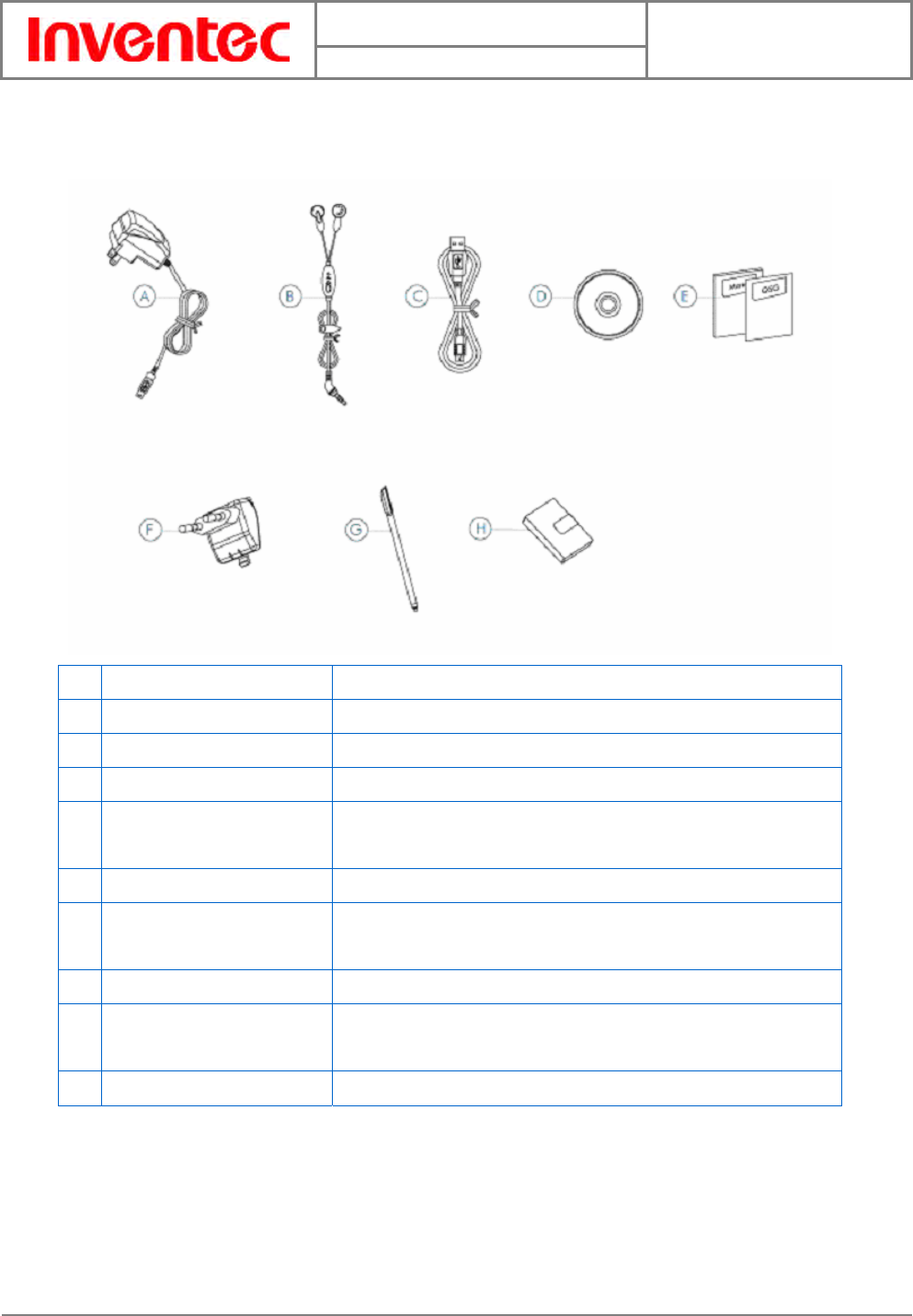
User Manual
Velocity 103
Version : 0.001
日 期 : 2008/05/06
10
INVENTEC CORPORATION
英業達股份有限公司
10
1.1 Introduction of Your Device
Accessories
A AC Adapter Recharges the device battery.
B Stereo Headset Allows you to make hands-free calls.
C USB Cable Connects the device to a Windows PC.
D Getting Started CD Windows MobileTM Getting Started Disc.
E User Manual/Quick Start
Guide
Provides instructions and help for using the device.
F EU plug Fits the AC adapter for use in Europe.
G Stylus For writing, drawing, or making selections on the device
touch-screen.
H Battery Rechargeable Li-ion polymer battery.
I TV out cable Allows you to show images on the device’s screen via a
television.
J UK plug Fits the AC adapter for use in the UK.
Views of the Device
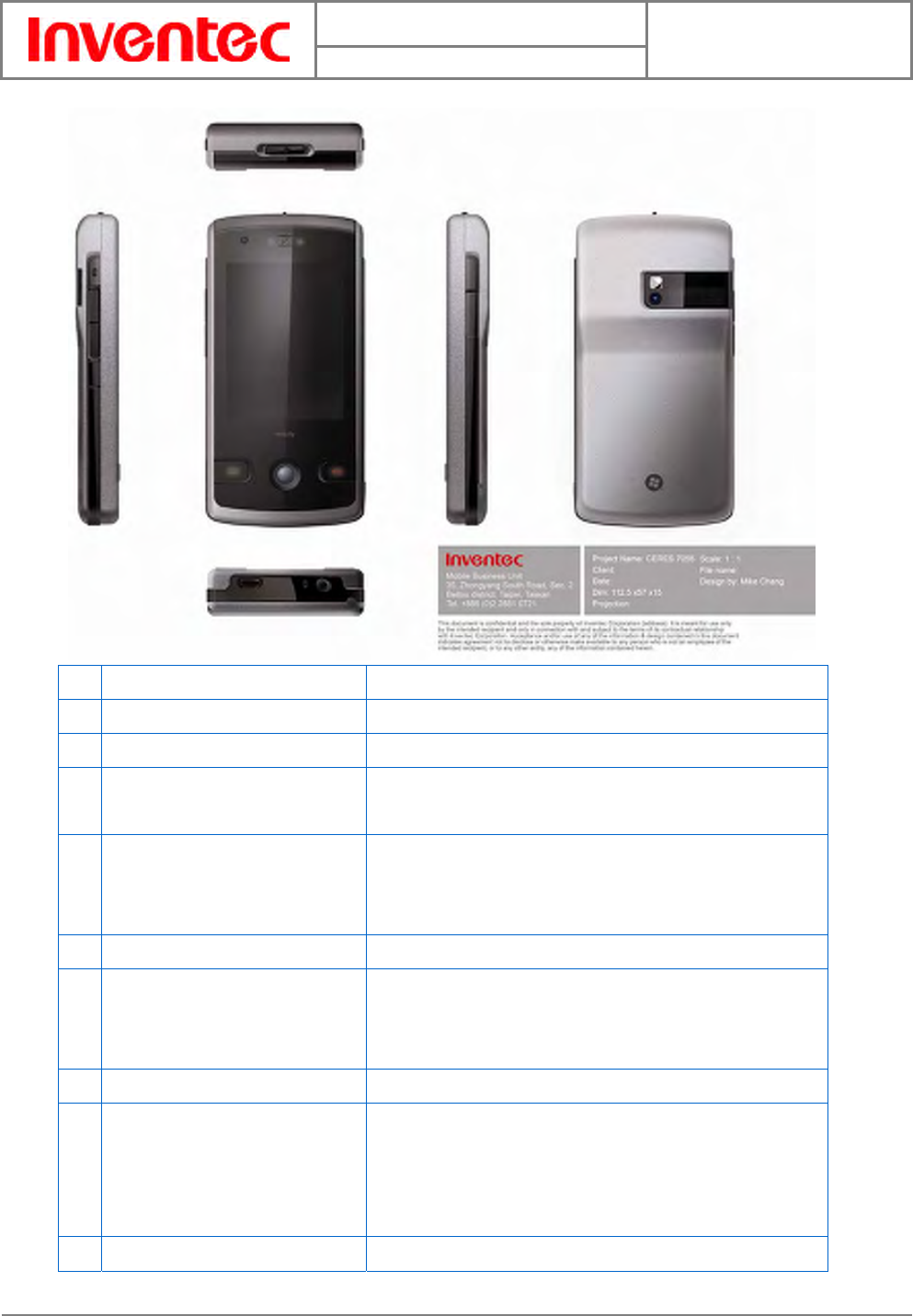
User Manual
Velocity 103
Version : 0.001
日 期 : 2008/05/06
11
INVENTEC CORPORATION
英業達股份有限公司
11
1 Cemera key * Press to launch the camera program.
2 Volume up*
3 Volume down*
4 Side key* Short press to carry out OK/Close functions; hold down
to launch the application toolbar shortcuts.
5 Power slider Push the power slider rightwards to turn on your
device; push the slider to the left side to lock your
device.
6 Second camera Use this camera for taking self portraits.
7 Bluetooth/notification LED Indicates Bluetooth/notification status. The blue light
flashes when Bluetooth is active or when notifications
exist for messages, missed calls or reminders.
8 Telephone receiver Speaker for listening to phone calls.
9 Battery/GSM LED Indicates battery/GSM status. LED displays solid red or
green light when the battery is under charge or the
battery is fully charged. Green light flashes when
GSM/UMTS is on.
10 Touch screen 2.8-inch TFT LCD with touch screen.
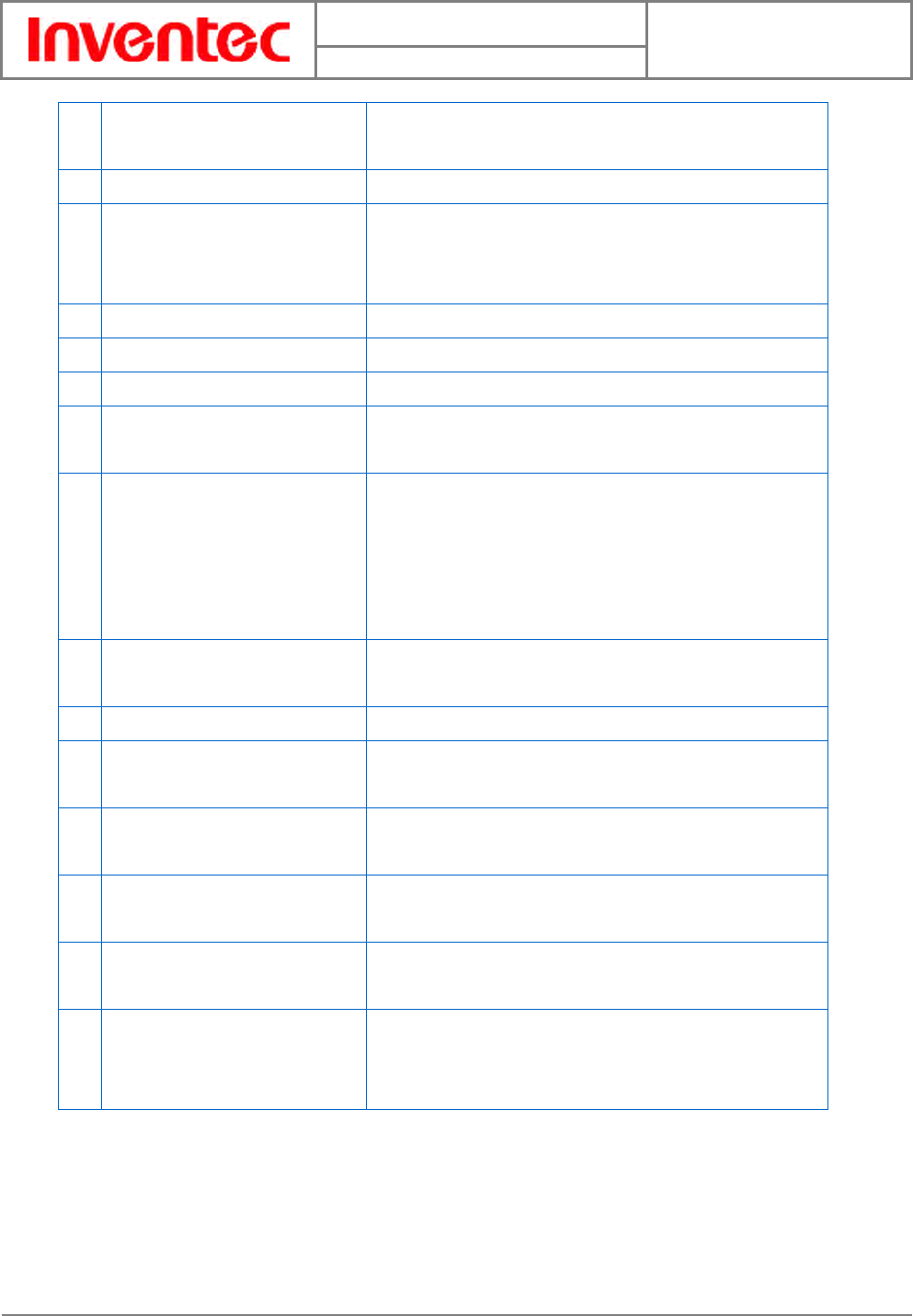
User Manual
Velocity 103
Version : 0.001
日 期 : 2008/05/06
12
INVENTEC CORPORATION
英業達股份有限公司
12
11 Velocity logo Tap here in any screen to show the application toolbar
shortcuts.
12 TALK Press TALK to dial or answer a call.
13 Jog ball Roll up, down, left or right to move through menus and
programs; carry out the selection by pressing the jog
ball.
14 END End a call or close phone application.
15 Mini-USB connector Mini-USB connector for PC sync and battery charging.
16 Back cover latch
17 Microphone Speak into the microphone when talking on the phone
or recording a voice note.
18 Reset switch Push the stylus into the reset hole to soft-reset your
device. Be sure to first push the power slider
rightwards to switch the device into sleep mode before
resetting the device; otherwise unsaved data or
settings may be lost.
19 Earphone socket/ TV out cable
socket
Socket for connecting a 2.5 mm earphone jack or TV
out cable.
20 MicroSD card slot Insert a mini-SD card to expand device memory.
21 Stylus Write, draw, or make selection on the device
touch-screen.
22 Self-Portrait mirror Reflector to help camera positioning while taking a
self-portrait shot.
23 Main camera Use the main camera to take photos or record video
clips.
24 Speaker Listen to audio media or listen to a phone call
hands-free.
25 Back cover Unlock the back cover latch and remove the back cover
to install the battery, the SIM card and the MicroSD
card.
* You can change the default programs/functions assigned to these buttons. To assign new
programs/functions, tap Start, tap Settings, and then tap Buttons.
1.2 Installing SIM Card, Battery and MircorSD Card
Installing the SIM Card and the Battery
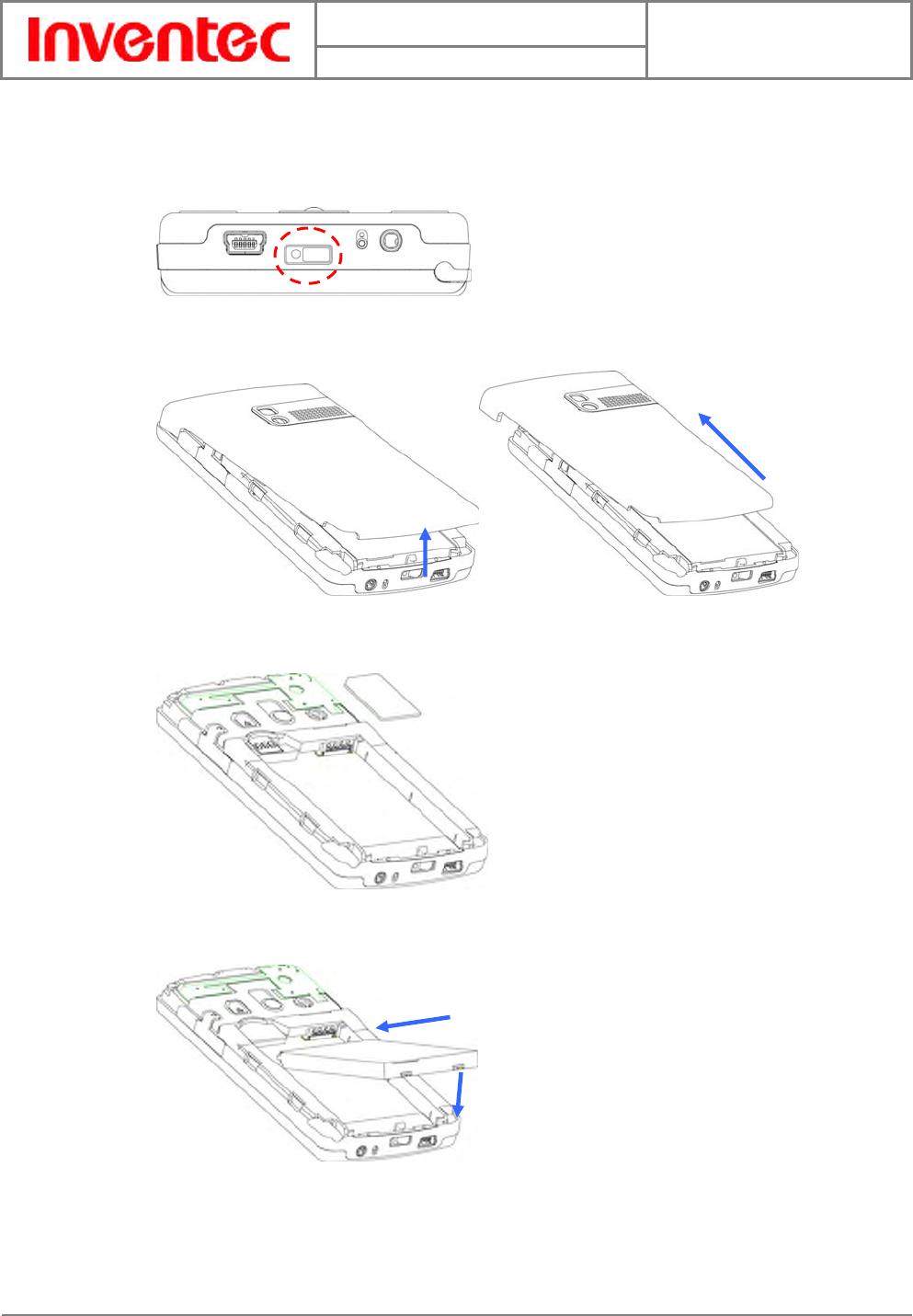
User Manual
Velocity 103
Version : 0.001
日 期 : 2008/05/06
13
INVENTEC CORPORATION
英業達股份有限公司
13
If you want to use the telephone features of the device, you must install a valid SIM card.
z With the back cover facing you, push the back cover latch to the right side to unlock
it.
z Lift the back cover as the diagram shown below and then slide the back cover
upwards in order to remove the back cover completely.
z Place the SIM card into the SIM cars slot with the gold contact facing down. The SIM
card’s cut-off corner should match the cut-off corner in the SIM card slot.
z Place the battery in position by aligning the golden contacts of the battery with the
corresponding connectors on the phone.
z Push the opposite end of the battery until it snaps into place.
z Close the back cover and lock it by sliding the latch to the left side.
①
②
①
②
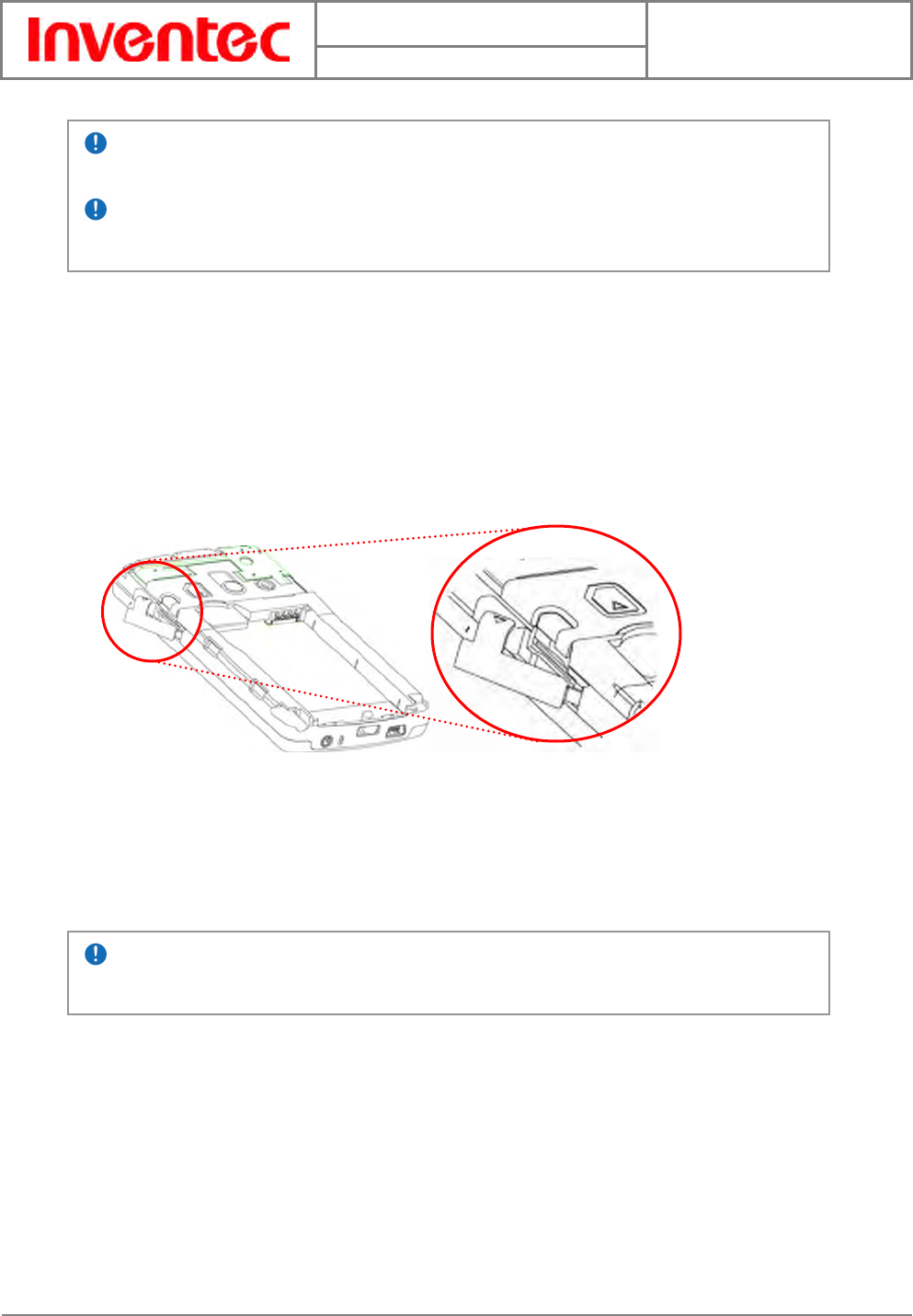
User Manual
Velocity 103
Version : 0.001
日 期 : 2008/05/06
14
INVENTEC CORPORATION
英業達股份有限公司
14
Installing a MicroSD Card
Your device contains a MicroSD card slot; use a certified MicroSD card in this slot to expand the
device’s storage memory by up to 2GB.
To install the MicroSD card, do the following:
1. Unlock the back cover latch and remove the back cover.
2. Remove the card slot cover as the diagram shown below.
3. Insert the MicroSD card with the logo side up and push into place until it clicks down and
is held in place.
To remove the MicroSD card, gently press the card and it will eject itself. You can then remove
the card by hand.
1.3 Battery Information
Battery performance depends on many factors, including your wireless service provider’s
network configuration, signal strength, the temperature of the environment in which you
operate your phone, the features and settings you select and use, items attached to your
phone’s connecting ports, and your voice, data, and other program usage patterns.
Inserting the MicroSD card in the wrong direction by force can cause damage to the
card and the card slot.
The device is supplied with a rechargeable Li-ion polymer battery. This battery is
supplied completely discharged and should be charged for at least 8 hours before first use.
Please follow the normal turn-off procedure to remove the battery; otherwise unsaved
data may be lost.
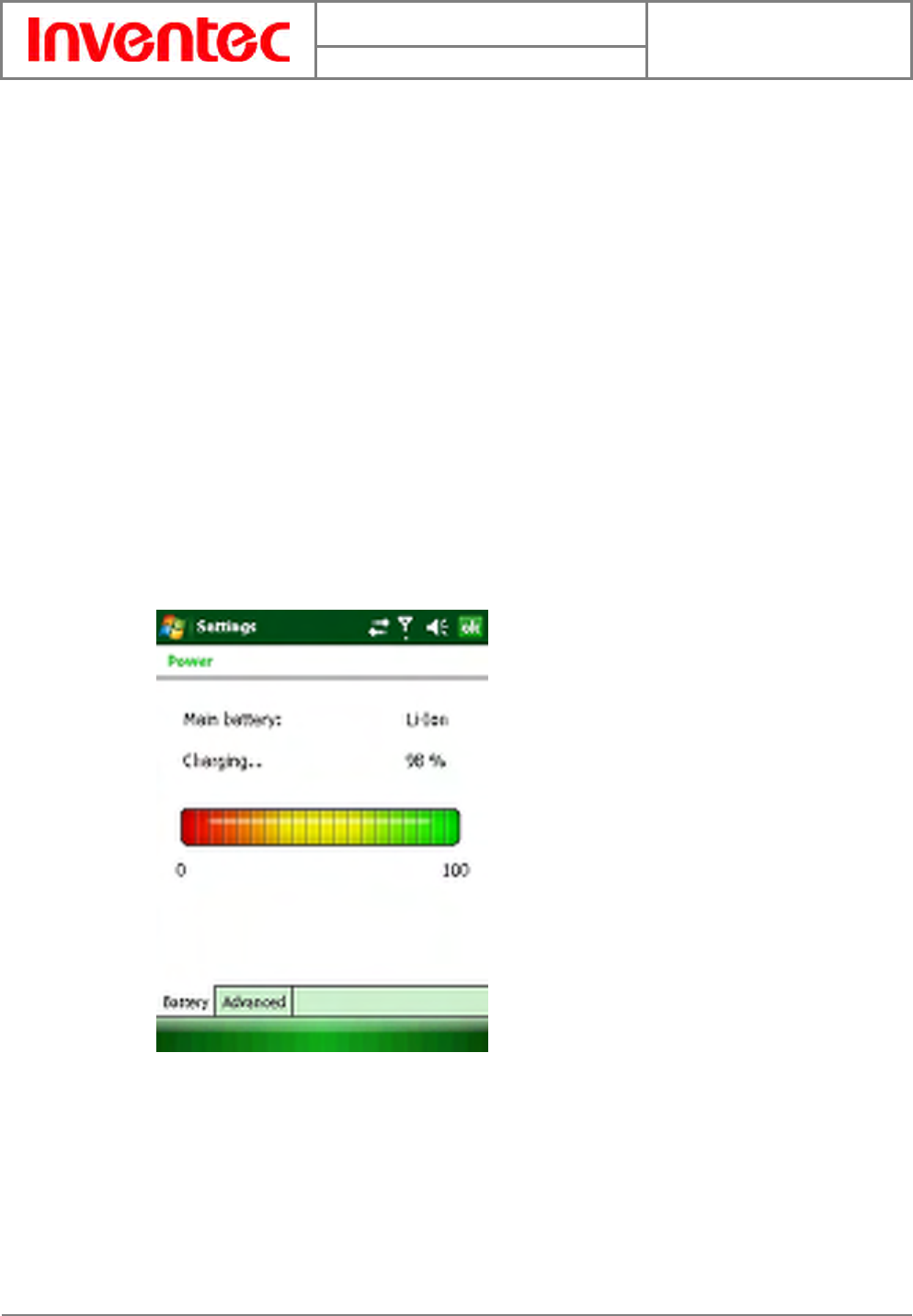
User Manual
Velocity 103
Version : 0.001
日 期 : 2008/05/06
15
INVENTEC CORPORATION
英業達股份有限公司
15
Battery life estimates (approximations):
z Talk time: 5 hours
z Standby time: 150-200 hours
Reducing Risk of Fire or Burns
z Do not attempt to open, disassemble, or service the battery pack.
z Do not crush or puncture the battery, short the external contacts, or dispose of in
fire or water.
z Do not expose to temperatures above 45˚C (113˚F) or below -10˚C (14˚F).
z Replace only with the battery pack designated for this product.
z Recycle or dispose of used batteries as stipulated by local regulation and in a
manner that respects the environment.
Checking the Battery Power
z Tap Start, tap Settings, tap the System tab, and then tap Power.
Optimizing Power Performance
z Tap Start, tap Settings, tap the System tab, tap Power, tap Advanced, and
then adjust the time for turning off the device if it is not in use.
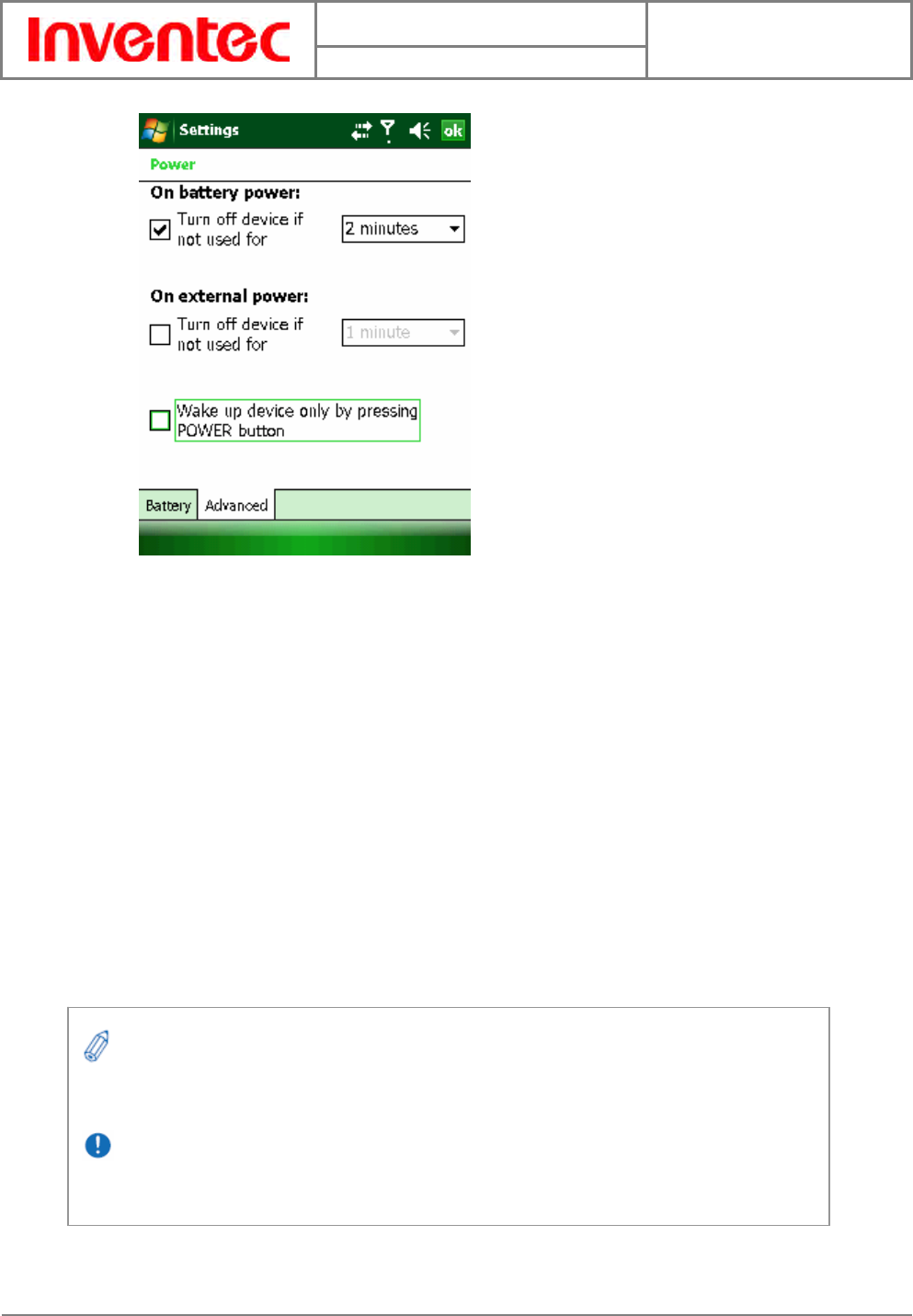
User Manual
Velocity 103
Version : 0.001
日 期 : 2008/05/06
16
INVENTEC CORPORATION
英業達股份有限公司
16
Managing a Low Battery
When the low-battery warning appears, do the following:
1. Immediately save your current data.
2. Start charging the battery or turn off your phone.
Charging the Battery
1. To charge the battery, make sure the battery is sitting in the battery slot correctly.
See the previous section for how to install the battery.
2. Do one of the following:
z Connect the device to the AC adapter and plug the AC adapter into a power
outlet.
z Connect the device to a PC with the USB cable (supplied with the device).
T
o char
g
e the device with the USB cable, you must connect the device to a functionin
g
USB port on a PC that is powered on.
For safety reasons, charging will not occur at temperatures below 0˚C/32˚F or above
40˚C/104˚F.

User Manual
Velocity 103
Version : 0.001
日 期 : 2008/05/06
17
INVENTEC CORPORATION
英業達股份有限公司
17
Chapter 2. Basic Operations
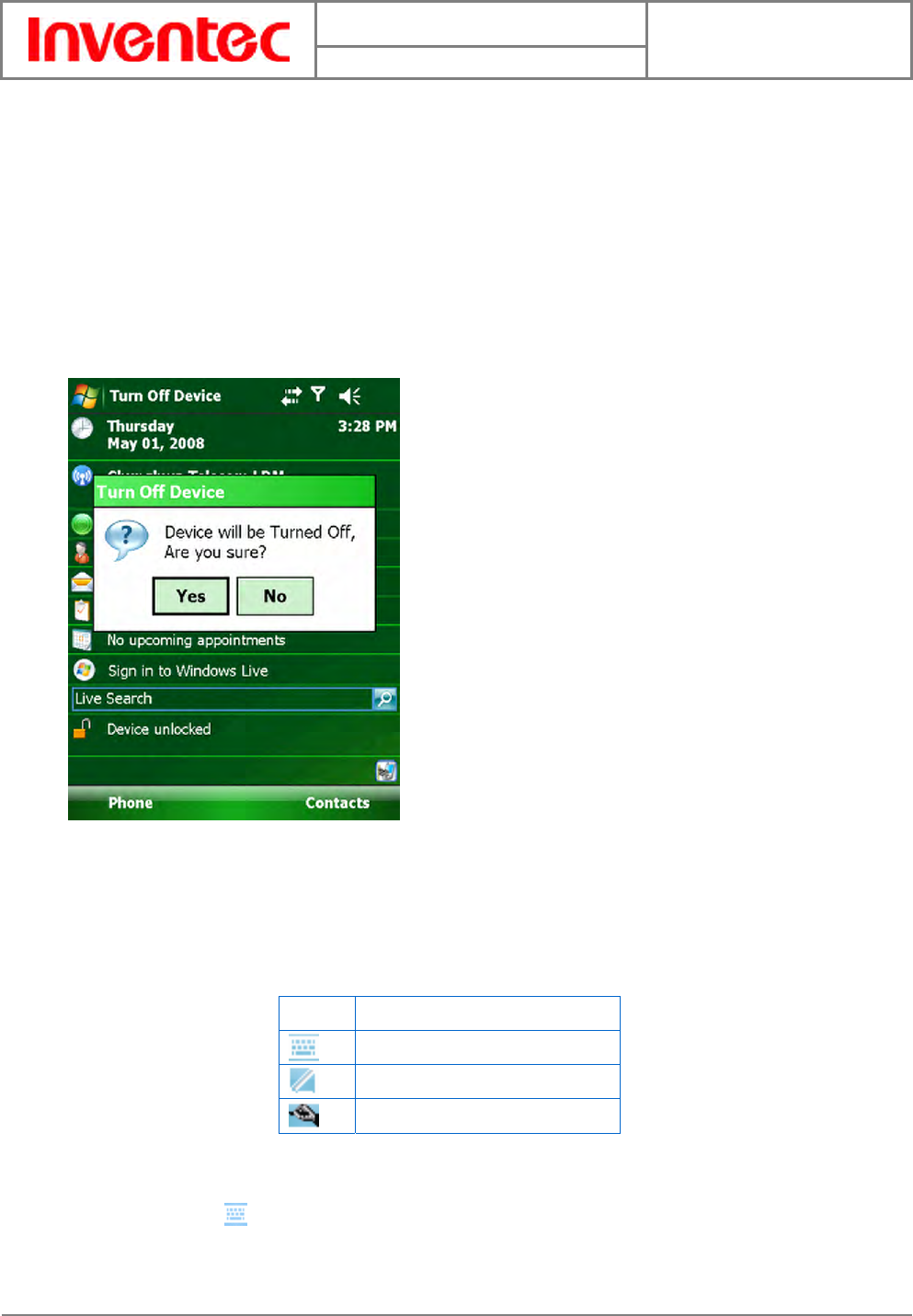
User Manual
Velocity 103
Version : 0.001
日 期 : 2008/05/06
18
INVENTEC CORPORATION
英業達股份有限公司
18
2.1 Getting Started
Turning On/Off the Device
Push the power slider rightwards to turn on the device. When your device is turned on, you can
push the power slider rightwards to switch the device into sleep mode. You can still receive
phone calls and messages when the device is operating in sleep mode. To resume the system
from sleep mode, push the power slider rightwards.
To power off the device completely, press and hold the power slider rightwards for 5 seconds
and the system will ask you to confirm before powering off the device.
2.2 Input Methods
The device contains 4 software input methods: keyboard, Letter Recognizer, Block Recognizer,
and Transcriber.
Icon Input Method
Keyboard
Letter/Block Recognizer
Transcriber
Keyboard
z Tap the in the center of the bottom menu bar) to launch the on-screen software
keyboard. If the Keyboard is not the selected input method, tap the input method
selector arrow (the up arrow next to the input method icon) and select Keyboard.
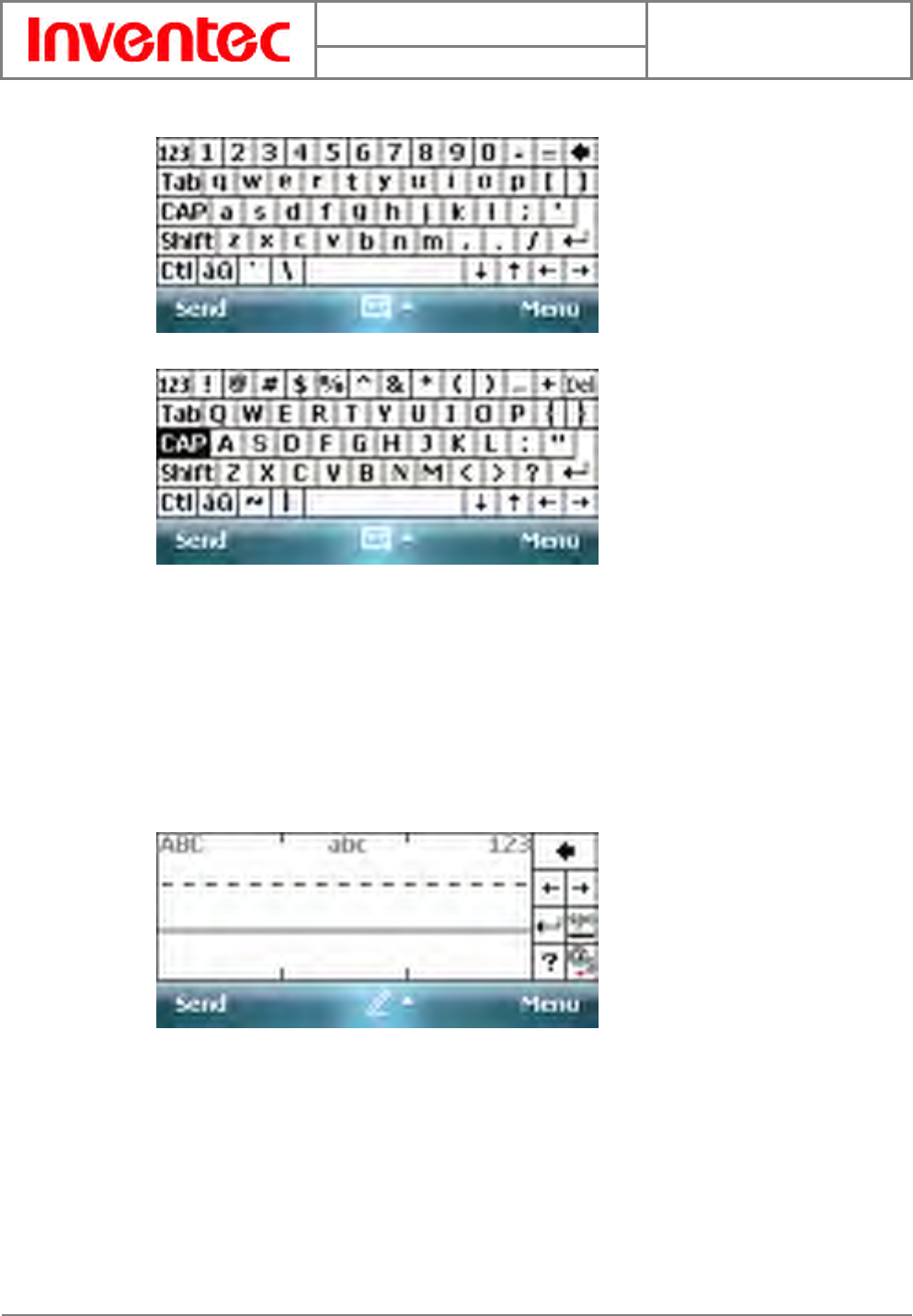
User Manual
Velocity 103
Version : 0.001
日 期 : 2008/05/06
19
INVENTEC CORPORATION
英業達股份有限公司
19
z To enter text, tap the keys on the on-screen keyboard.
z Tap the CAP key on the on-screen keyboard to enter capital letters and/or symbols.
Letter Recognizer
Letter Recognizer recognizes one letter, number, or symbol at a time.
z To launch Letter Recognizer, tap the input method selector arrow (the upward arrow
next to the input method icon) and select Letter Recognizer.
z Write uppercase letters in the left recognition area (the ABC box).
z Write lowercase letters in the middle recognition area (the abc box).
z Write numbers and symbols in the right recognition area (the 123 box).
Block Recognizer
Block Recognizer recognizes letters written in one stroke.
z To launch Block Recognizer, tap the input method selector arrow (the upward arrow
next to the input method icon) and select Block Recognizer.
z Write lowercase letters in the text recognition area (the abc box on the left).
z Write numbers and symbols in the numeric recognition area (the 123 box on the
right).
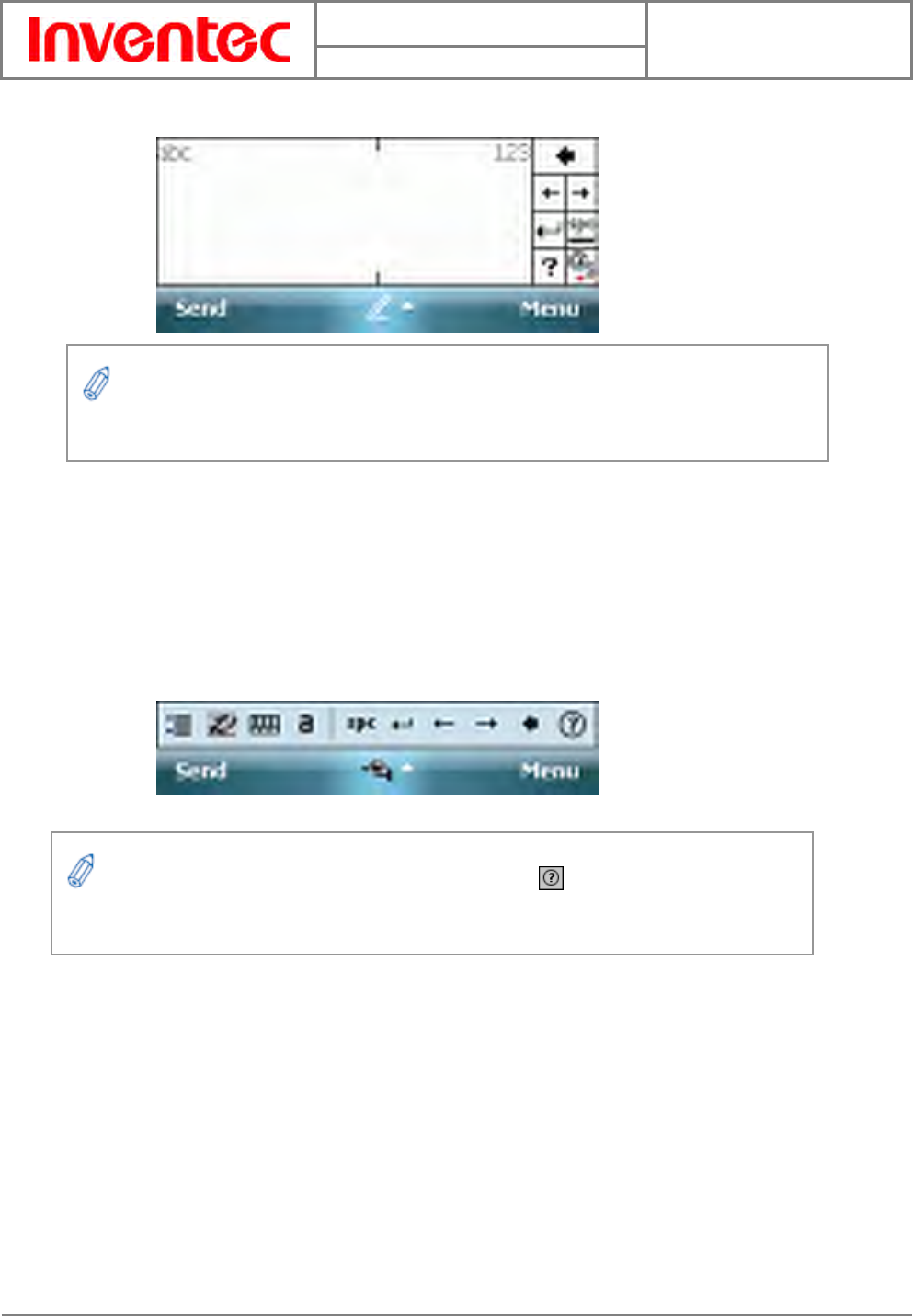
User Manual
Velocity 103
Version : 0.001
日 期 : 2008/05/06
20
INVENTEC CORPORATION
英業達股份有限公司
20
z To input symbols, tap any recognition area, text or numeric, once and write symbols.
Transcriber
Transcriber recognizes handwriting in cursive and/or print. It uses the full screen as its
recognition area. It interprets the movement of the stylus on the screen as you write.
z To launch Transcriber, tap the input method selector arrow (the up arrow next to the
input method icon) and select Transcriber.
z Write anywhere on the screen.
2.3 Today Screen Components
Today Screen
The Today Screen is usually the first screen that appears when you turn on the device for the
first time each day. It displays a summary of relevant information, shows you the system status
and contains a list of shortcuts to programs.
Tap ? in Letter or Block Recognizer to see a demo on how to write recognizable
characters.
The Transcriber comes with detailed help pages. Tap if you need further
assistance.
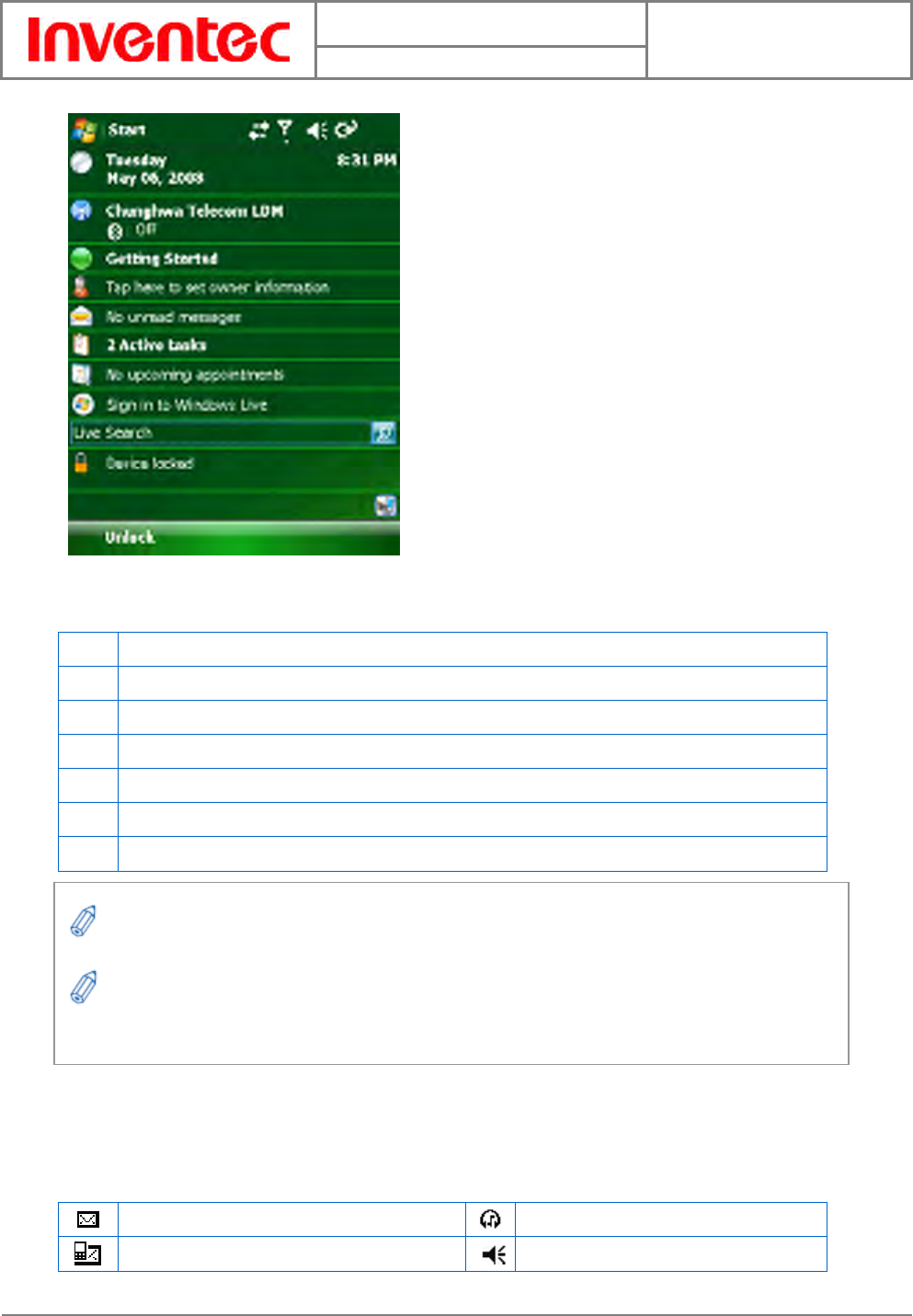
User Manual
Velocity 103
Version : 0.001
日 期 : 2008/05/06
21
INVENTEC CORPORATION
英業達股份有限公司
21
The items in the example screen above are defined as follows:
1 Date and time
2 Owner information
3 Unread messages, including text messages, MMS messages, and e-mails
4 Active tasks
5 Upcoming appointments
6 Tap here to use Live Search. This feature requires an internet connection.
7 Device lock status
Notification Icons
Notification icons appear at the title bar on the screen. The following table lists common status
indicators and their meanings.
New e-mail Bluetooth headset detected
New voice mail or text message (SMS) Ringer on
You can also access the Today screen by selecting Today from the Start menu.
To change the items shown in the Today screen, tap Start, tap Settings, tap Today, and
then tap Items tab.
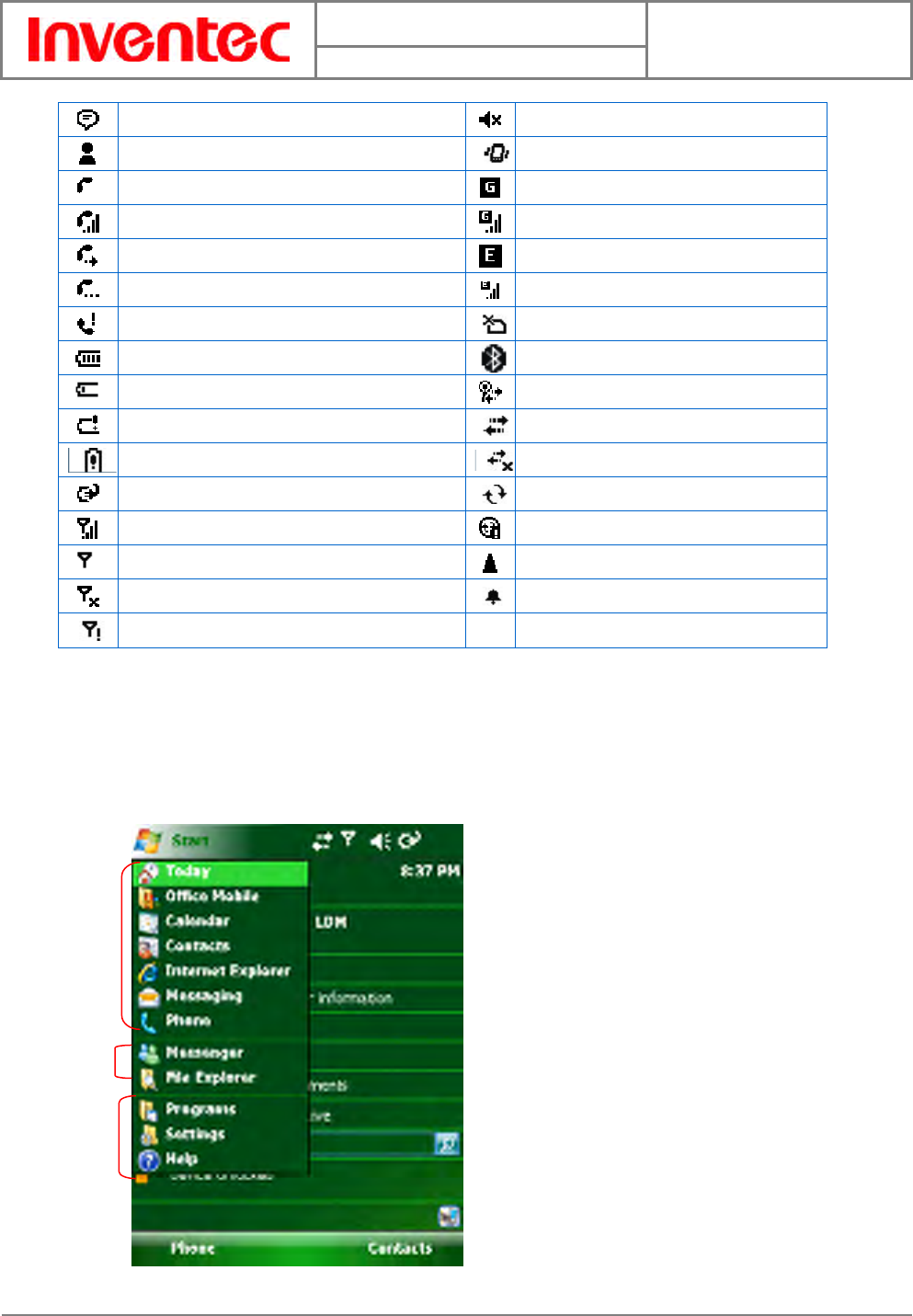
User Manual
Velocity 103
Version : 0.001
日 期 : 2008/05/06
22
INVENTEC CORPORATION
英業達股份有限公司
22
New notifications Ringer off
New instant message Ringer in vibration mode
Voice call GPRS available
Voice call in progress GPRS in use
Calls are being forwarded EDGE available
Call on hold EDGE in use
Missed call No SIM card installed
Battery full Bluetooth connection in progress
Low battery Wi-Fi connection in progress
Battery alert Data Connection is active
Extremely low battery Connection is not active
Battery charging Synchronization in progress
Signal strength Synchronization error
No signal Roaming
Flight mode Alarm
No service
2.4 The Start Menu
The Start menu is accessible by tapping the Start button at the top left of the screen, or by
pressing START on the left side of your device.
①
②
③
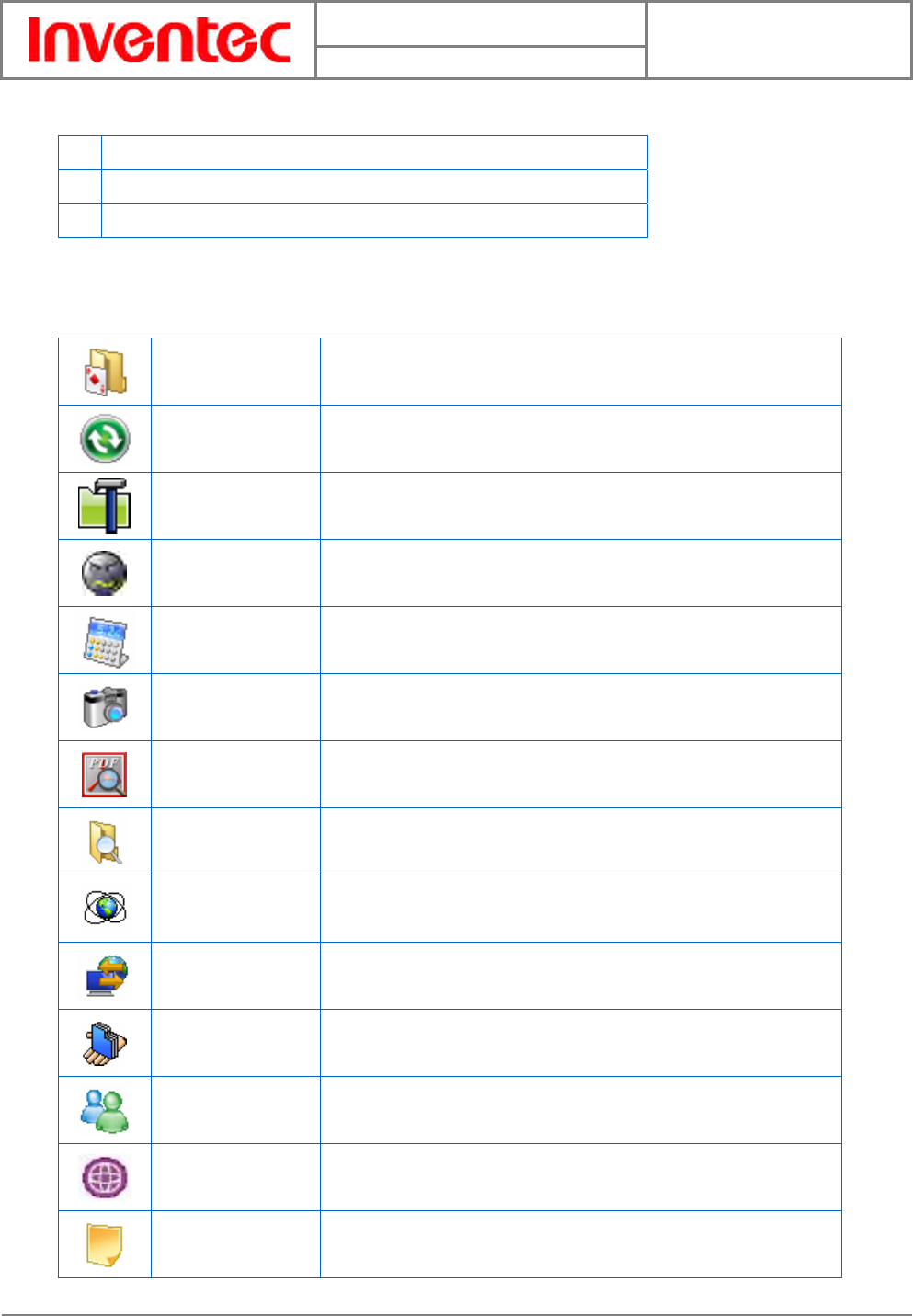
User Manual
Velocity 103
Version : 0.001
日 期 : 2008/05/06
23
INVENTEC CORPORATION
英業達股份有限公司
23
The Start menu is divided into 3 groups, as follows:
1 Commonly used items
2 Recently accessed applications
3 List of all programs, device settings, and system help
List of All Programs
The following table lists icons of programs that are already installed on your device.
Games Two games are installed on your device: Bubble Breaker and
Solitaire.
ActiveSync Synchronizes information between your device and a PC. See
“Chapter 3. Synchronizing Information” for details.
Auto Config Lets you select your mobile operator manually and applies the
correct data settings for that operator.
Blacklist Lets you set up a list of phone numbers to block.
Calculator Performs basic calculations such as addition, subtraction,
multiplication, and division.
Camera Allows you to use the built-in device camera and microphone
to capture videos and photographs.
ClearVue PDF Lets you read files stored in the Portable Document Format.
See “9.2 ClearVue PDF” for details.
File Explorer Lets you view, organize and manage the files and folders on
your device.
GPS Test Tests satellite signal strength and shows the GPS raw data
stream.
Internet
Sharing
Lets you use your device as an external modem for a PC,
connecting through a USB port or Bluetooth.
Local Backup Lets you back up and recover your data. See “9.3 Backing up/
Recovering” for details.
Messenger Lets you send and receive instant messages with your
Windows Live Messenger contacts.
MIDlet Manager Enables you to install Java applications from local files or a
network.
Notes See “6.2 Using Notes” for details.
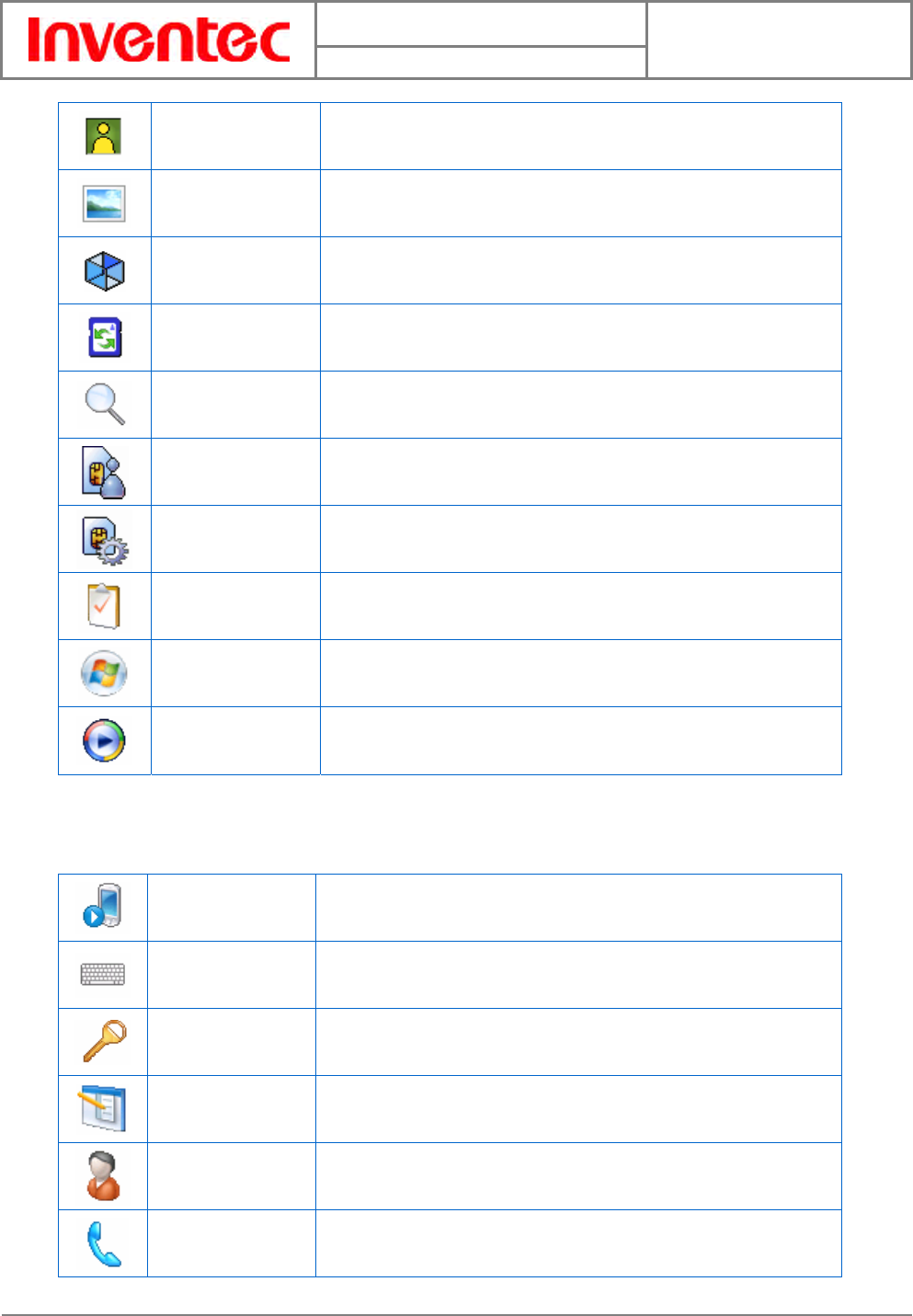
User Manual
Velocity 103
Version : 0.001
日 期 : 2008/05/06
24
INVENTEC CORPORATION
英業達股份有限公司
24
Photo Contacts See “5.3 Using Photo Contact” for details.
Pictures &
Videos
Collects, organizes, and sorts picture and video files in the My
Pictures folder on your device or on a storage card.
Profile Lets you set different usage profiles for the phone in different
situations. See “9.6 Profile” for details.
SD Format Formats the inserted mini-SD card.
Search Searches the data stored in your device.
SIM Manager Lets you manage your SIM card. See “5.2 Using SIM Manager”
for details.
SIM Toolkit A software toolkit comes with the SIM card. The functionality
of this toolkit depends on your SIM card provider.
Tasks Keeps track of your tasks. See “6.3 Using Tasks” for details.
Windows Live Allows you to access Microsoft services such as Window Live
Spaces and Windows Live Messenger.
Windows Media Use it to play music and video.
List of All Settings
Personal
Buttons Configures the device’s programmable buttons.
Input Input method configurations.
Lock You can set a password to unlock the device.
Menus Configures the Start menu.
Owner
Information
Enter and edit information about the owner of the device.
Phone Configures the Phone features. See “Chapter 4. Phone
Features” for details.
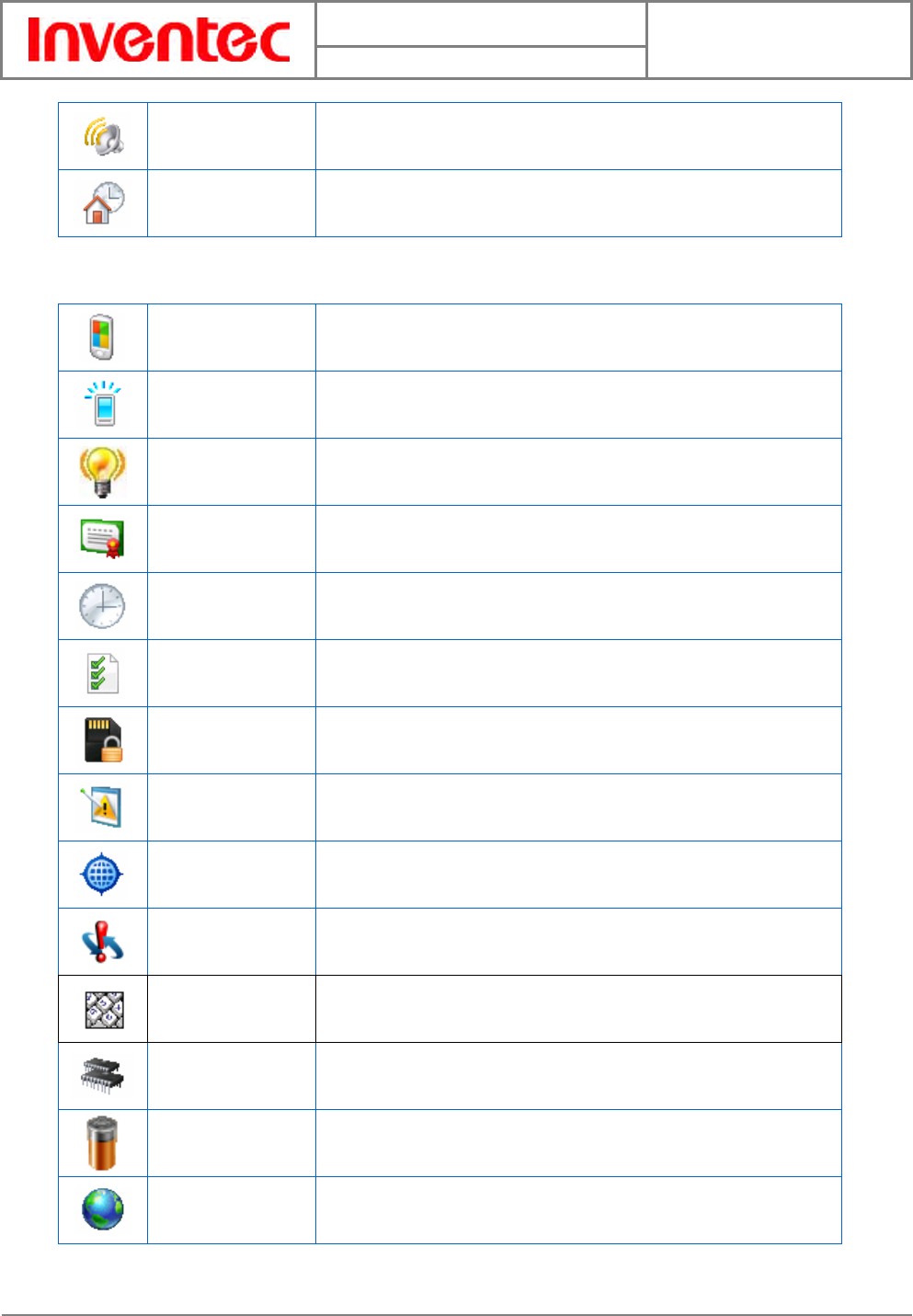
User Manual
Velocity 103
Version : 0.001
日 期 : 2008/05/06
25
INVENTEC CORPORATION
英業達股份有限公司
25
Sounds &
Notifications
Configures program and event sounds.
Today Configures the Today screen items and theme, including the
background wall-paper and device color-scheme.
System
About Windows Mobile information and device name.
Backlight Configures the display backlight.
Brightness Lets you adjust the brightness of display and keypad.
Certificates Manages personal and root certificates.
Clock & Alarms Sets time and alarms.
Customer
Feedback
Sends volunteered, non-personal information about how you
use Windows Mobile software to Microsoft.
Encryption Encrypts files as they are placed on a storage card.
Error Reporting Enables or disables the in-built error reporting system.
External GPS Lets you define the ports used for GPS configuration.
Factory Reset Lets you reset all settings to the manufacturer defaults.
Key Config Provides functions such as LCD auto lock.
Memory Memory and process management.
Power Power management settings.
Regional
Settings
Configures the device’s locale.
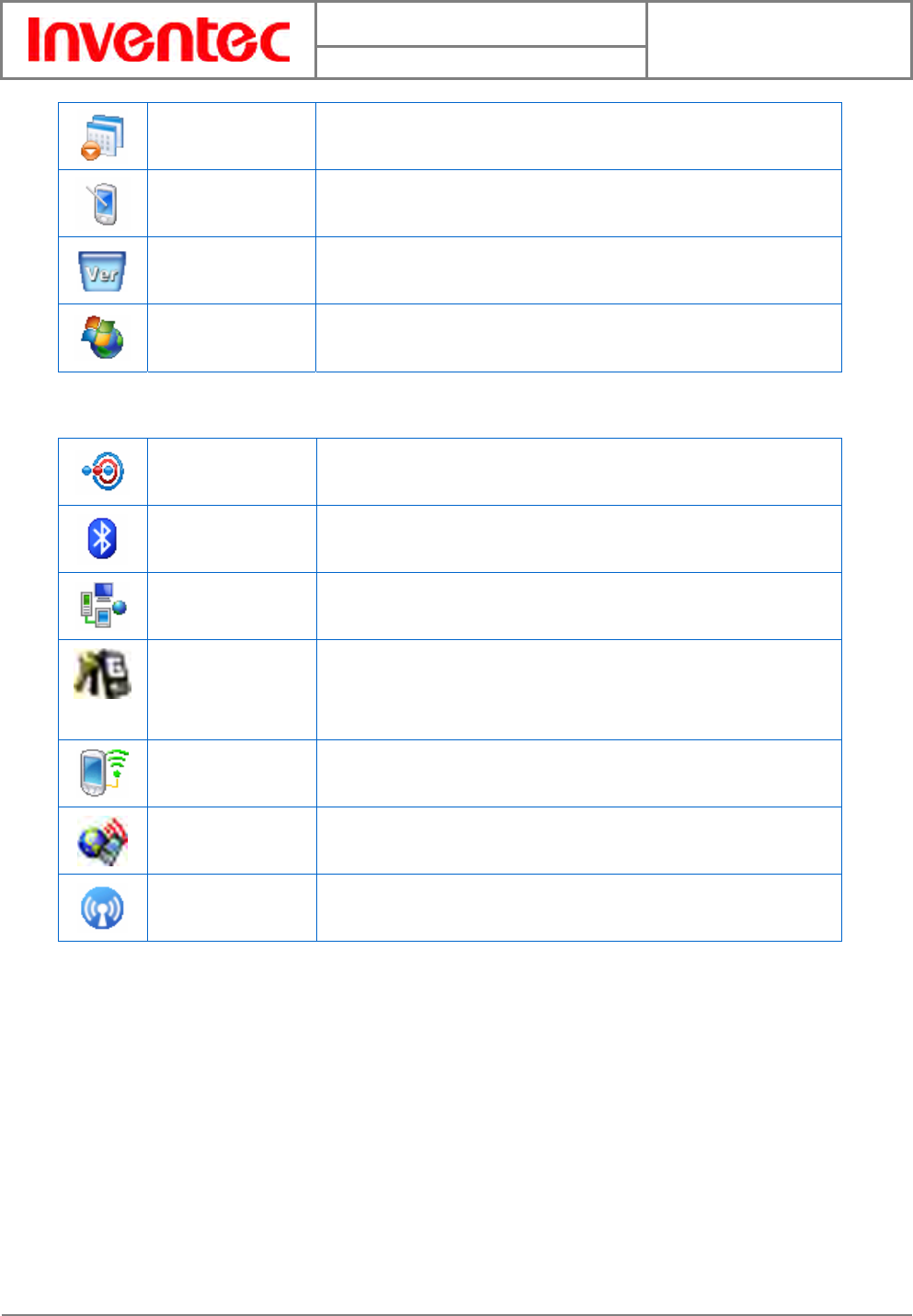
User Manual
Velocity 103
Version : 0.001
日 期 : 2008/05/06
26
INVENTEC CORPORATION
英業達股份有限公司
26
Remove
Programs
Allows you to view and remove installed applications.
Screen Lets you align the screen. See “Calibrating Your Device” in
Chapter 2 for details.
System Version Displays the device software version.
Windows
Update
Lets you download Windows Mobile updates such as critical
security fixes.
Connections
Beam Turns on/off the beam feature.
Bluetooth Configures Bluetooth settings. See “8.4 Using Bluetooth” for
details.
Connections Configures the device’s connections.
GPRS
Authentication
Helps you to change authentication schemes for GPRS setting.
Please contact your mobile telephone service provider for
information on which scheme to select.
Network Cards Configures the network adapter. When connecting to Wi-Fi,
you can configure wireless networks here as well.
WiFi Network
Manager
Displays detailed information for a connected Wi-Fi Network.
You can change Wi-Fi Network settings here as well.
Wireless
Manager
Turns on/off wireless, Bluetooth and phone features.

User Manual
Velocity 103
Version : 0.001
日 期 : 2008/05/06
27
INVENTEC CORPORATION
英業達股份有限公司
27
Chapter 3. Synchronizing Information
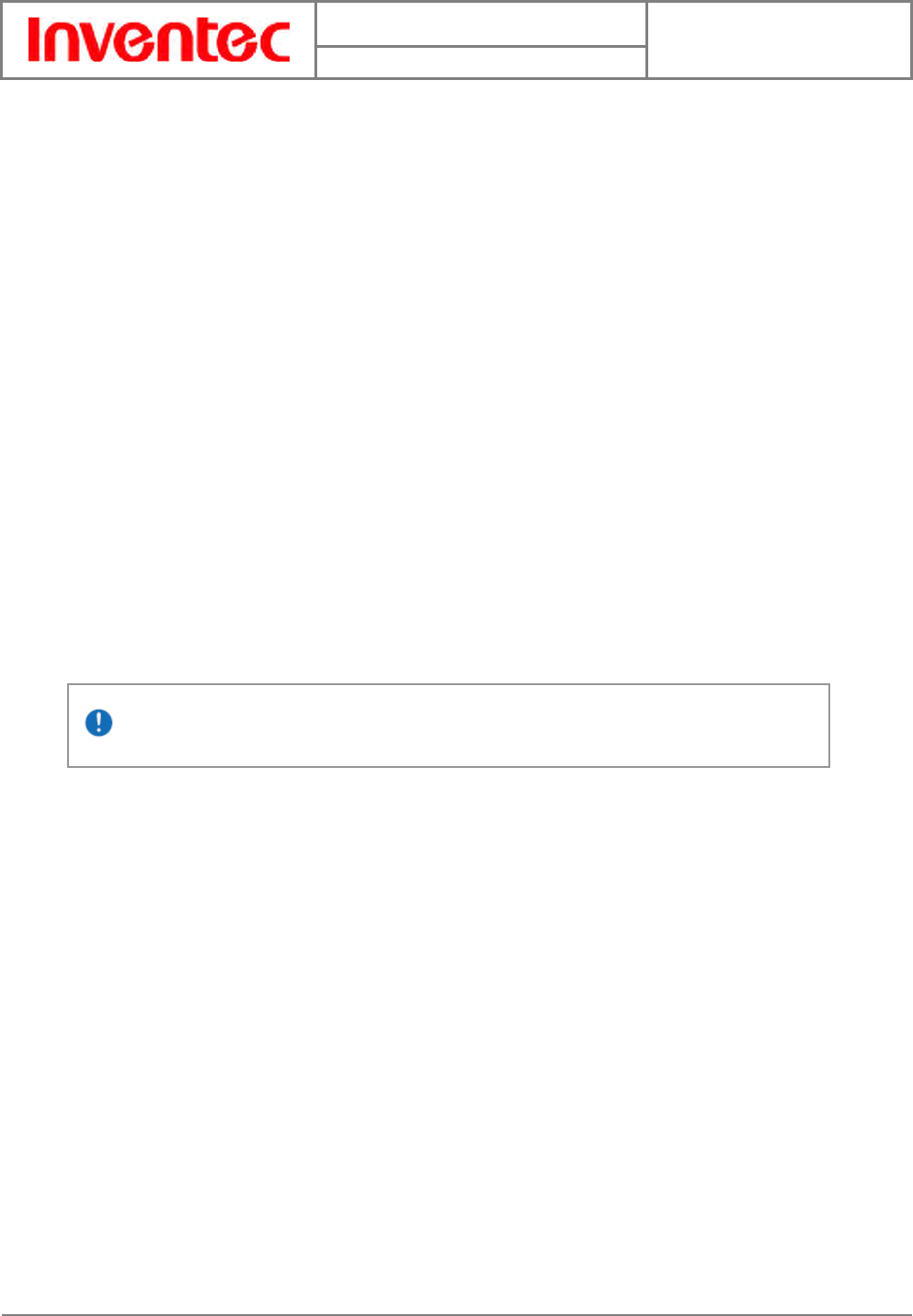
User Manual
Velocity 103
Version : 0.001
日 期 : 2008/05/06
28
INVENTEC CORPORATION
英業達股份有限公司
28
ActiveSync synchronizes information on your phone with information on your PC such as
Outlook content. ActiveSync can also synchronize over a wireless or cellular network with
Exchange Server, provided your company or service provider is running Exchange Server with
Exchange ActiveSync.
Specifically, you can use ActiveSync to:
z Synchronize Outlook e-mail, contacts, calendar, or tasks on your phone with your PC
z Synchronize pictures, video, and music between the device and your PC.
z Synchronize Outlook e-mail, contacts, calendar appointments, and tasks on your
phone directly with Exchange Server so that you can stay up to date even when your
PC is turned off.
z Copy files between your phone and your PC without synchronizing.
z Select which types of information are synchronized and specify how much
information is synchronized. For example, you can choose how many weeks of past
calendar appointments to synchronize.
3.1 Installing and Setting up ActiveSync
1. Install ActiveSync on your PC, as described on the Windows Mobile™ Getting Started
Disc. After setup completes, the Synchronization Setup Wizard automatically starts
when you connect your device to the PC (via USB cable or Bluetooth).
2. Follow the instructions on the screen to complete the wizard. In the Sync Setup
Wizard, you can:
z Create a synchronization relationship between your PC and the device.
z Configure an Exchange Server connection to synchronize directly with Exchange
Server. To synchronize your device with Exchange Server, obtain the name of the
Exchange Server, your user name, password, and domain name from your
administrator before completing the wizard.
z Choose information types to synchronize.
3. Once synchronization completes, you can disconnect your phone from your PC.
Be sure to install ActiveSync on the PC before connecting your device to it.
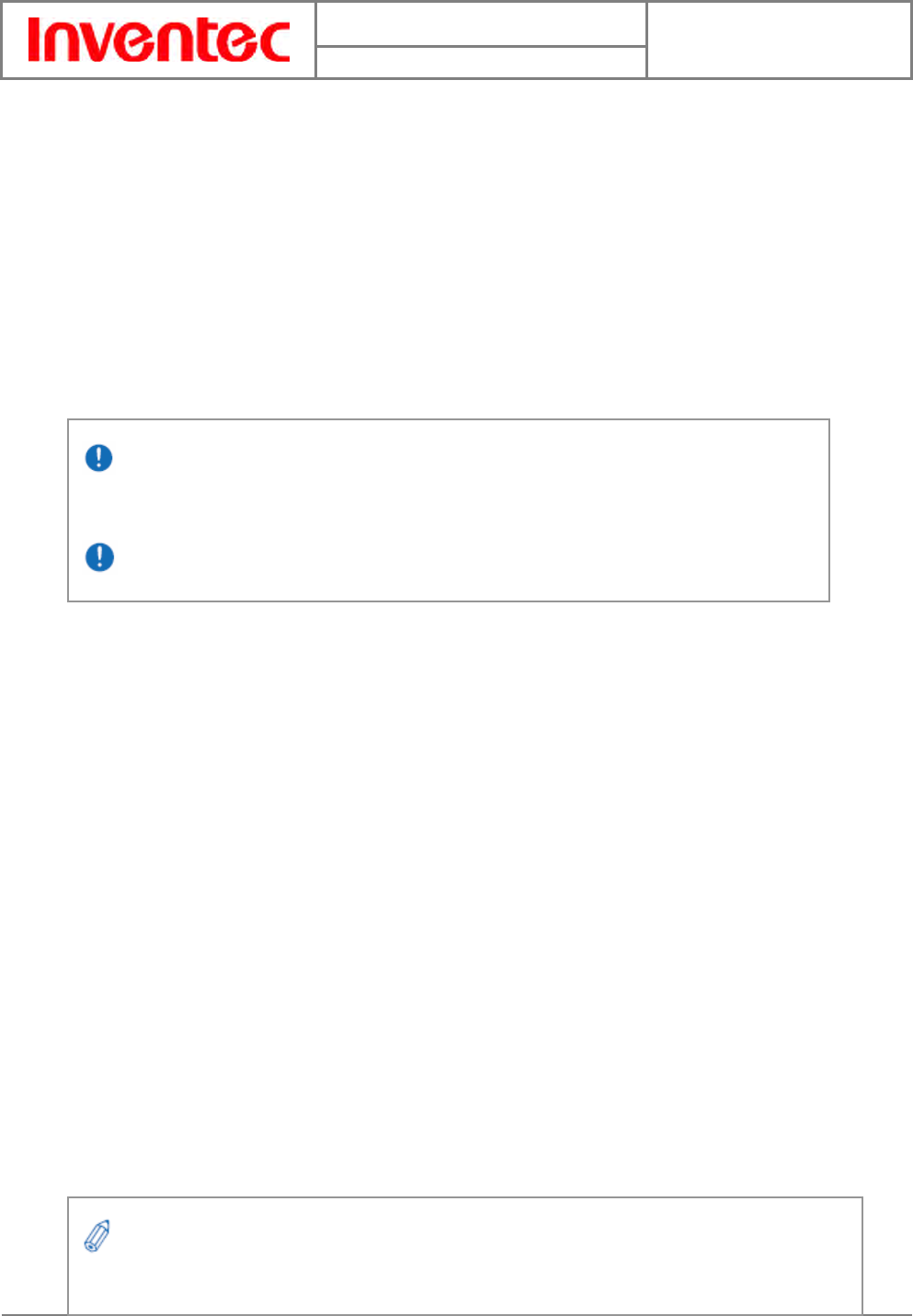
User Manual
Velocity 103
Version : 0.001
日 期 : 2008/05/06
29
INVENTEC CORPORATION
英業達股份有限公司
29
3.2 Synchronizing Information
Starting and Stopping Synchronization Manually
1. Turn on the device.
2. Connect your device to your PC using a USB cable, Bluetooth, or infrared connection.
For more detailed information, see "Connecting a mobile device to a PC" in ActiveSync
Help on your PC.
3. On your device, tap Start, tap Programs, and then tap ActiveSync.
4. To start synchronization, tap Sync.
5. To stop synchronizing, tap Stop.
Changing Which Information is Synchronized
ActiveSync synchronizes a limited amount of information by default to save storage space on
your phone. You can change the amount of information that is synchronized by performing the
following steps.
1. On the Today screen, click Start > Programs > ActiveSync.
2. Tap Menu > Options.
3. Do one or more of the following:
z Select the checkbox for the items you want to synchronize. If you cannot select
a checkbox, you might have to clear the checkbox for the same information type
elsewhere in the list.
z Clear the checkbox for any items you want to exclude.
z To customize synchronization of a computer, select the computer name and then
click Settings.
z To customize synchronization of particular information, select the information
type and then click Settings.
z To stop synchronizing with one computer completely, select the computer name
and click Delete.
You can start and stop synchronization only if your device already has a sync
relationship with a PC or Exchange Server.
Some Anti-Virus software may conflict with ActiveSync.
Outlook e-mail can be synchronized with only one computer and one Exchan
g
e ActiveSync
server.
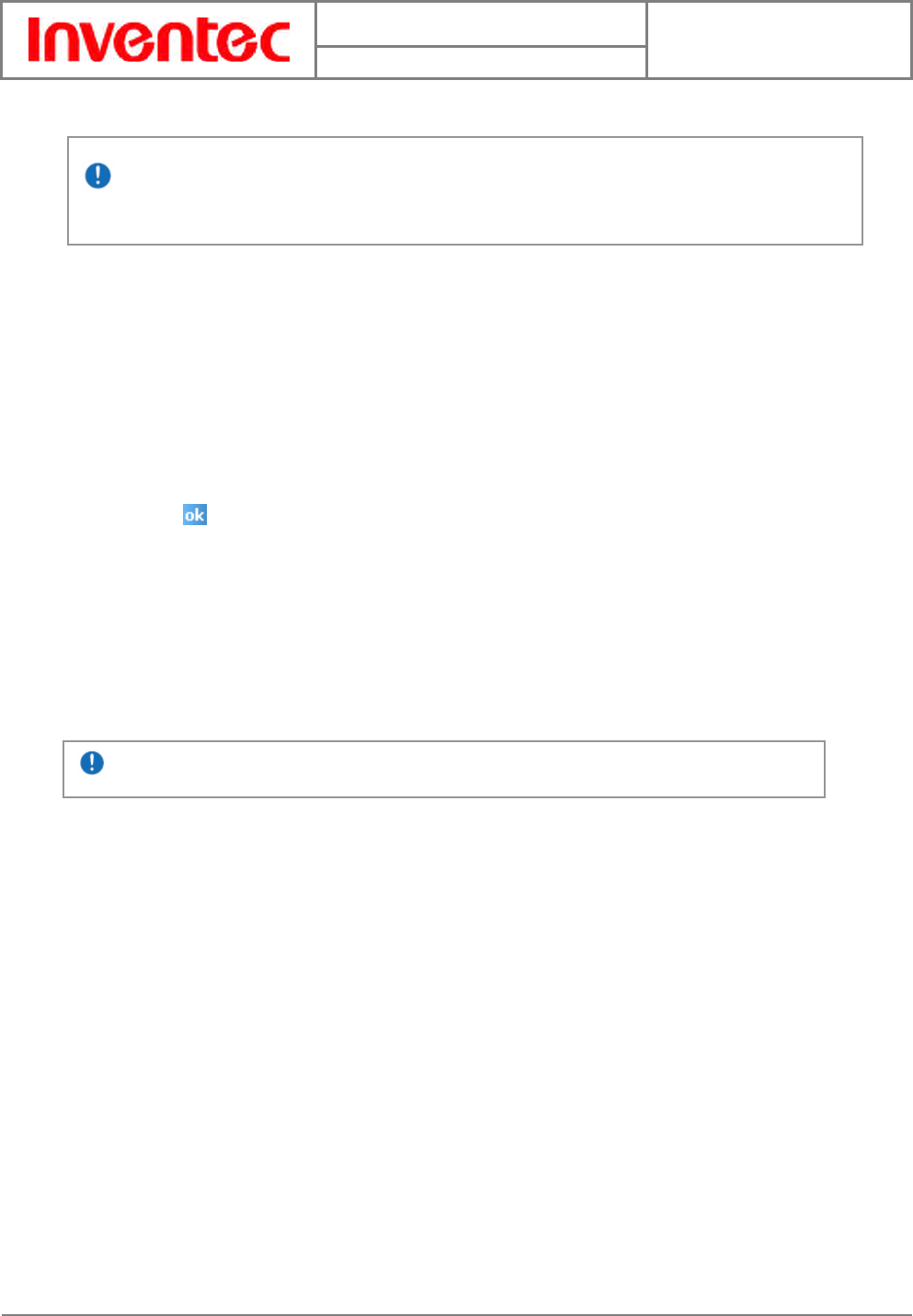
User Manual
Velocity 103
Version : 0.001
日 期 : 2008/05/06
30
INVENTEC CORPORATION
英業達股份有限公司
30
3.3 Changing Settings for an Information Type
1. Tap Start, tap Programs, tap ActiveSync, tap Menu, and then tap Options.
2. Select one of the information types (e.g. E-mail, Tasks or Calendar items).
3. Do one of the following:
z To view or change settings for an information type (when available), tap
Settings.
z To view or change settings for a computer or Exchange Server, tap Settings.
4. Change the amount of information to be synchronized or other settings.
5. Tap (or Finish in the Exchange Server settings wizard).
3.4 Synchronizing with Exchange Server
To set up your device to synchronize directly with Exchange Server, you will need to get the
name of the server and the server domain name from your service provider or system
administrator. You must also know your Exchange user name and password.
1. On your device screen, tap Start, tap Programs, tap ActiveSync, tap Menu, and
then tap Configure Server. If you have not yet set up synchronization with
Exchange Server, this menu item will instead say Add Server Source.
2. In Server address, enter the name of the server running Exchange Server, and tap
Next.
3. Enter your user name, password, and domain name, and tap Next.
4. If you want the device to save your password so that you will not need to enter it on
each connection, select the Save password checkbox.
5. Select the checkboxes for the types of information items that you want to synchronize
with Exchange Server.
6. To change available synchronization settings, select the type of information, and tap
Settings.
7. To change the rules for resolving synchronization conflicts, tap Advanced.
8. Tap Finish.
Before changing synchronization settings on the device, disconnect it from your PC.
Before changing settings for an information type on the device, disconnect the device from
y
our PC.
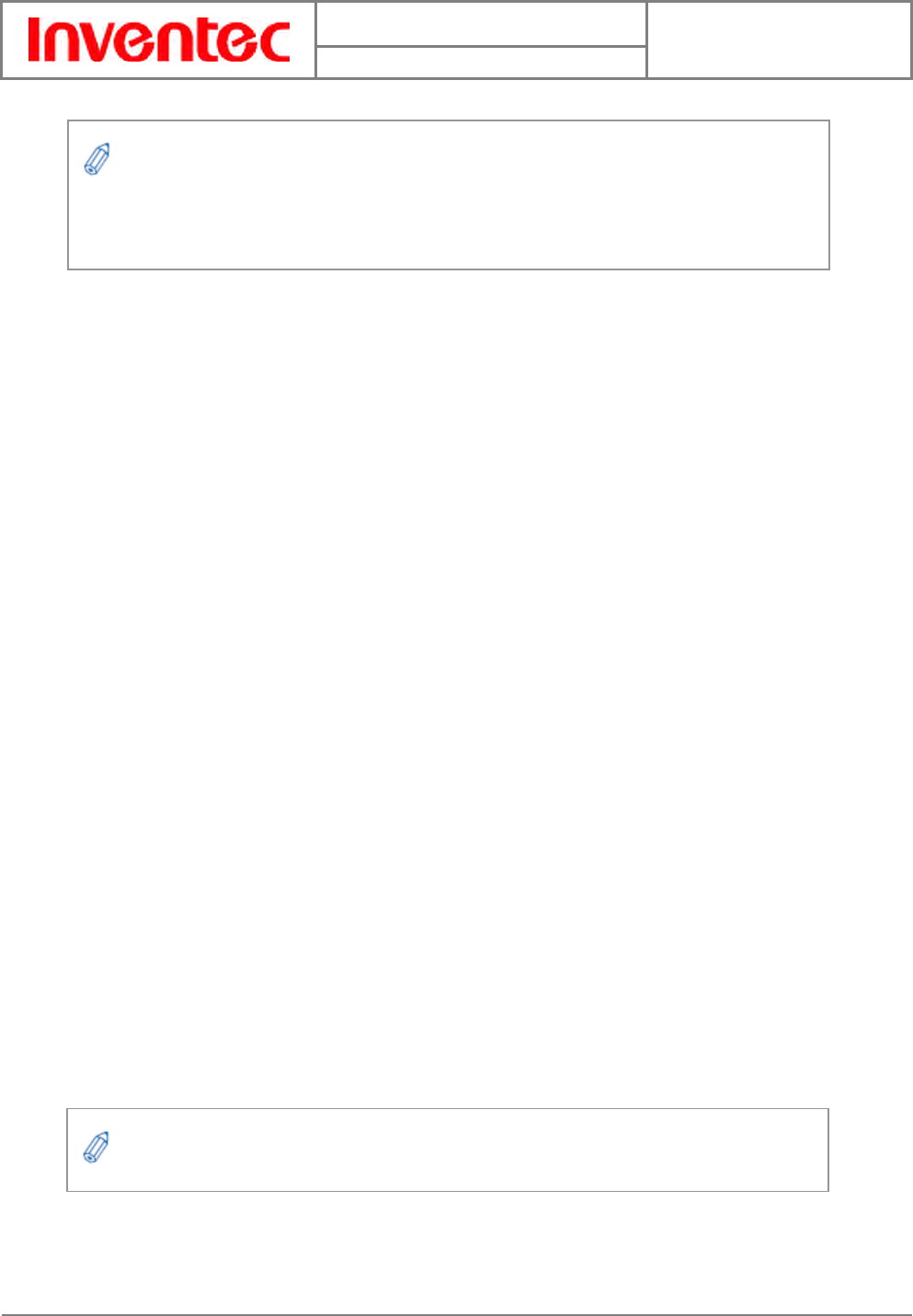
User Manual
Velocity 103
Version : 0.001
日 期 : 2008/05/06
31
INVENTEC CORPORATION
英業達股份有限公司
31
3.5 Synchronizing via Infrared and Bluetooth
Connecting to a PC using Infrared
1. Your PC must be equipped with a suitable IrDA transceiver
2. Follow the instructions in ActiveSync Help on the PC for setting up your PC to receive
infrared beams.
3. Line up the infrared (IR) ports so that they are unobstructed and within close range.
4. On your device, tap Start, tap Program, and then tap ActiveSync.
5. Tap Menu and then tap Connect via IR.
6. Tap Sync.
Connecting to a PC Using Bluetooth
1. Your PC must be equipped with a suitable Bluetooth radio.
2. Follow the instructions in ActiveSync Help on the PC for configuring Bluetooth on your
PC to support ActiveSync.
3. On your device, tap Start, tap Programs, and then tap ActiveSync.
4. Tap Menu and then tap Connect via Bluetooth. Ensure that the device and PC are
within close range.
5. If this is the first time you have connected to this PC via Bluetooth, you must
complete the Bluetooth wizard on the phone and set up a Bluetooth partnership with
the PC before synchronizing. This process will typically involve exchanging a pass-key
between the device and the PC.
6. Tap Sync.
7. When finished, tap Menu and then tap Disconnect Bluetooth.
You can also use the Sync Setup Wizard to set up the device to synchronize remotely
with the Exchange Server. This wizard is started when you connect your device to your PC
after installing ActiveSync on the PC.
To preserve battery power, turn off Bluetooth after the synchronization is completed.

User Manual
Velocity 103
Version : 0.001
日 期 : 2008/05/06
32
INVENTEC CORPORATION
英業達股份有限公司
32
Chapter 4. Phone Features
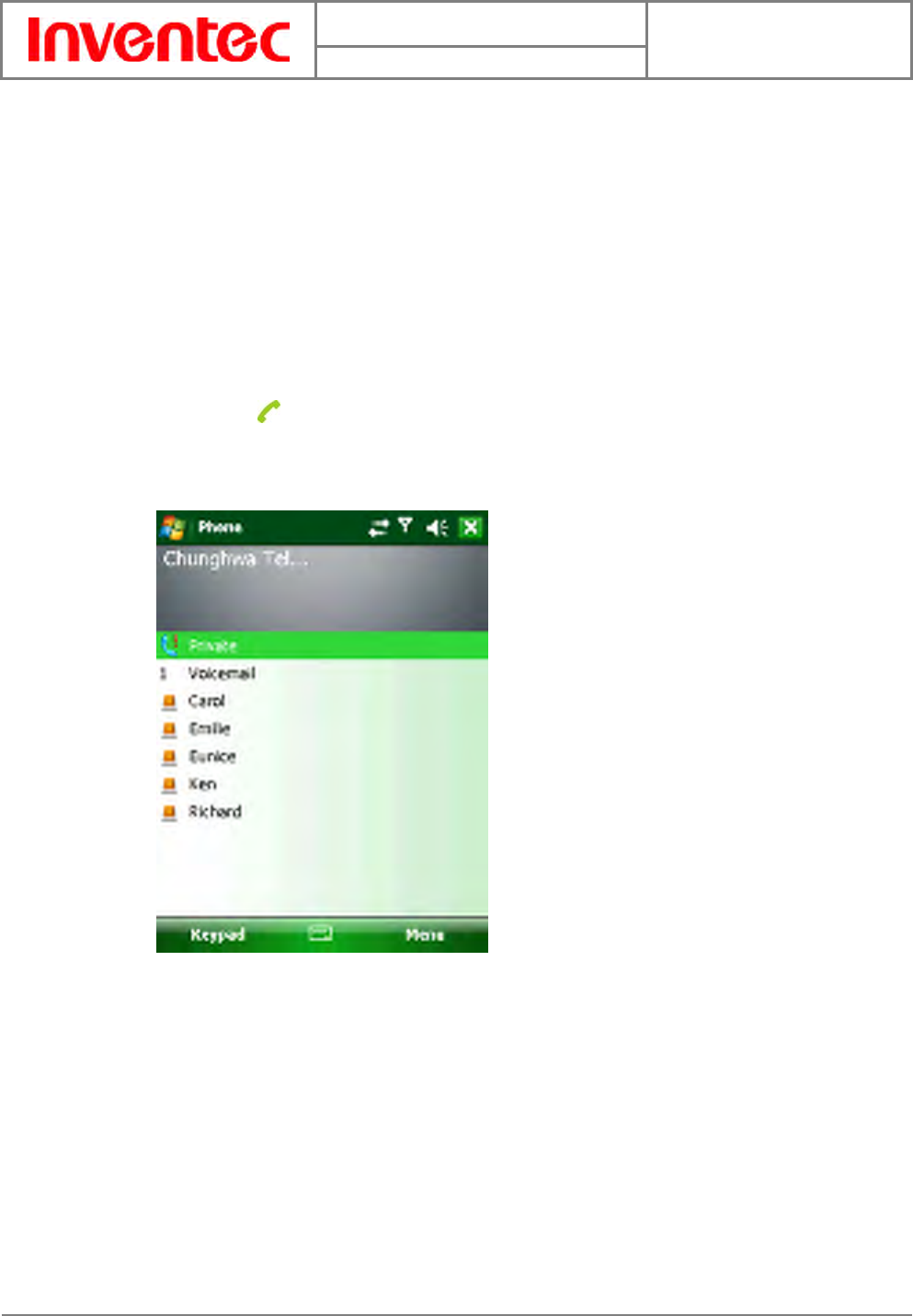
User Manual
Velocity 103
Version : 0.001
日 期 : 2008/05/06
33
INVENTEC CORPORATION
英業達股份有限公司
33
You can use your phone to make, receive, and keep track of calls, and to send text messages
(SMS) and multimedia messages (MMS). You can also call a phone number directly from the
Contacts application, and copy SIM contacts to Contacts on the phone.
4.1 Making a Call
The Phone Screen
You can see Call History, Speed Dial and Contacts from the Phone Screen. Moreover, you can
open, call or find a contact, and even save a new number in Contacts. To access the Phone
Screen, do any of the following:
z Press TALK ( ).
z Tap Phone on the screen.
z Tap Start and then tap Phone.
Making a Call by Using the Phone Keypad
To enter phone numbers by tapping the screen directly, you have to open the Phone Keypad.
1. On the Phone screen, tap Keypad to bring up the phone keypad if it doesn’t show
automatically. You can then tap in the phone number using the touch-screen.
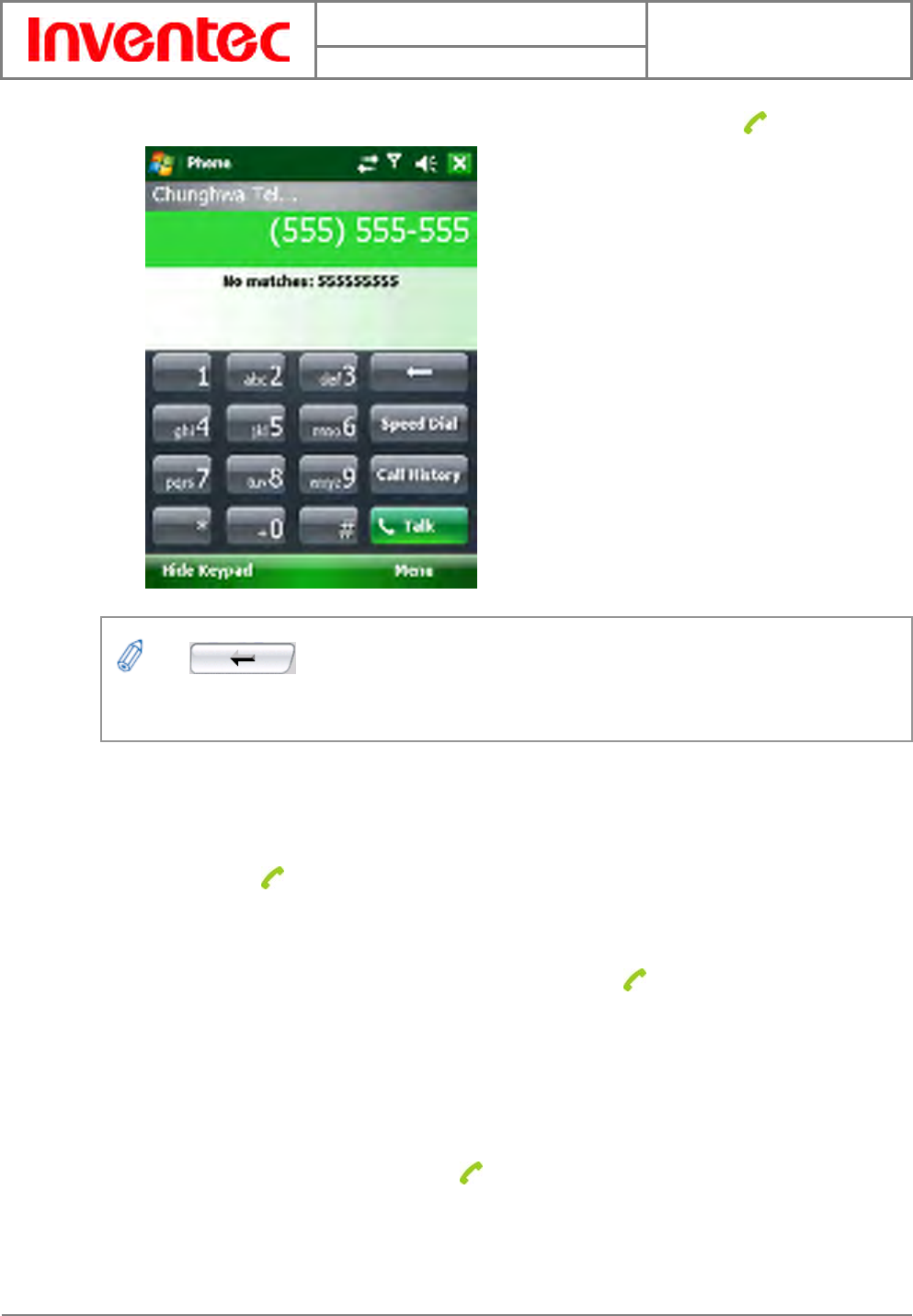
User Manual
Velocity 103
Version : 0.001
日 期 : 2008/05/06
34
INVENTEC CORPORATION
英業達股份有限公司
34
2. After entering the phone number, tap Talk on the screen or press TALK ( ).
Making a Call by Using the Keyboard
1. On the Today Screen, start entering a contact’s name or a phone number.
2. Matching contacts will be listed; select one and tap Call on the screen or press
TALK ( ). The Call option will only appear if that contact’s information
includes a phone number.
3. If you do not see the number or contact name, finish entering the number or
name, then tap Talk on the screen or press TALK ( ).
Making a Call from Call History
The Call History screen displays calls you have made, received, and missed.
1. Tap Call History on the Phone keypad.
2. Select the name or phone number to call.
3. Tap Call on the screen or press TALK ( ).
Tap on the screen once to erase one single digit in the phone number; tap and
hold it to erase a whole string of numbers.
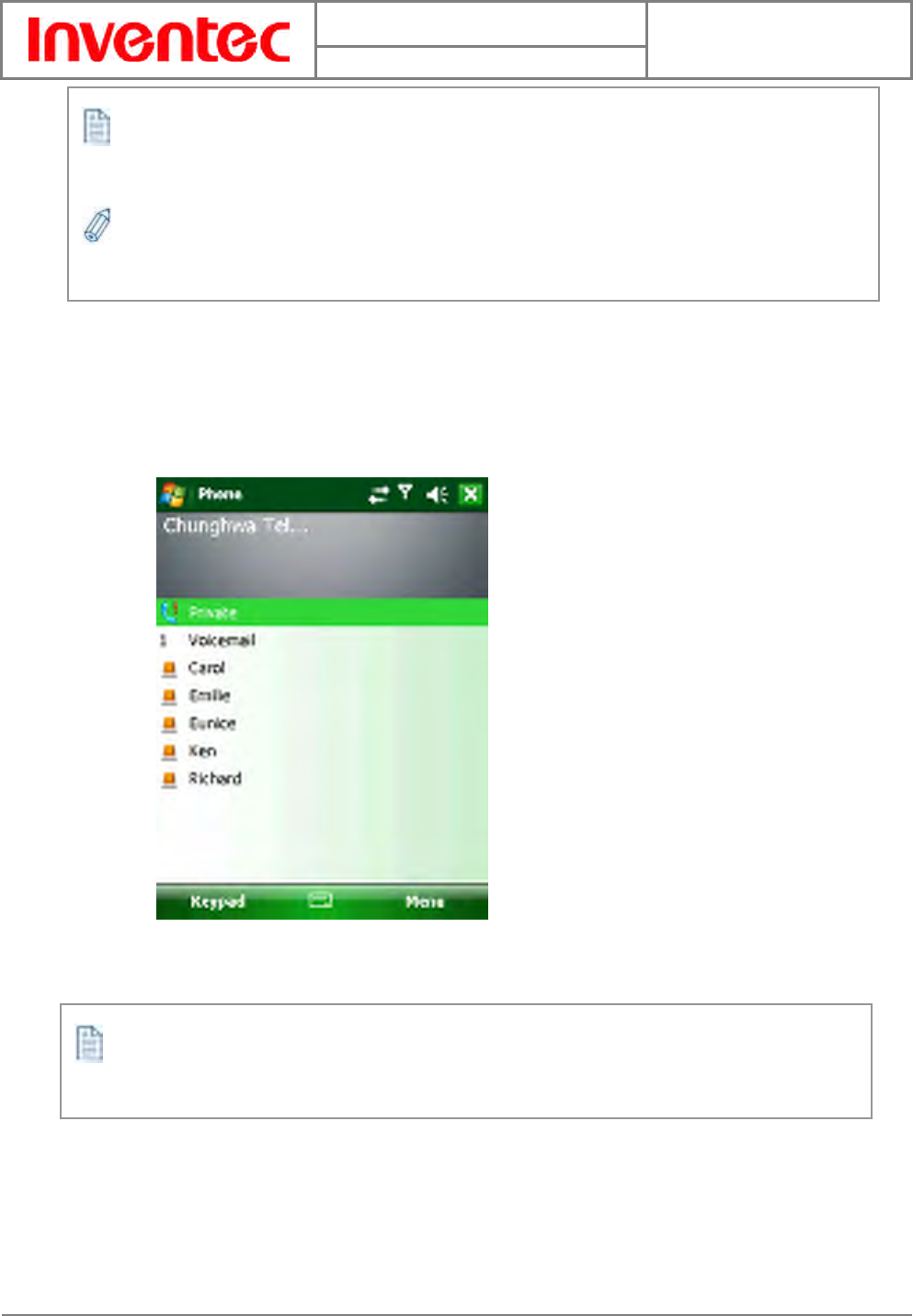
User Manual
Velocity 103
Version : 0.001
日 期 : 2008/05/06
35
INVENTEC CORPORATION
英業達股份有限公司
35
Making a Call from Contacts
Do either of the following to make a call from Contacts:
z On the Phone Screen, tap on the desired contact in the list and then tap on the
number you want to dial.
z Tap Contacts on the Today screen, then tap and hold the desired contact and select
Call Work, Call Home, or Call Mobile from the pop-up submenu.
Making a Call from Speed Dial
You can create speed dial entries for frequently called numbers or frequently accessed items.
Speed Dial allows you to dial a number by pressing a single key. For example, if you assign
location 2 to a contact in Speed Dial, you can simply press and hold 2 on the Phone Keypad to
Tapping a phone number or a contact in the Call History list displays the history for all the
calls related to the contact or the phone number.
When someone who isn’t in your list of contacts calls you, you can create a contact during
the call or from Call History. Tap Menu and then tap Save to Contacts.
On the Phone screen, you can quickly search throu
g
h Contacts by enterin
g
the first letter of
contact’s name or the first number of the contact’s phone number.
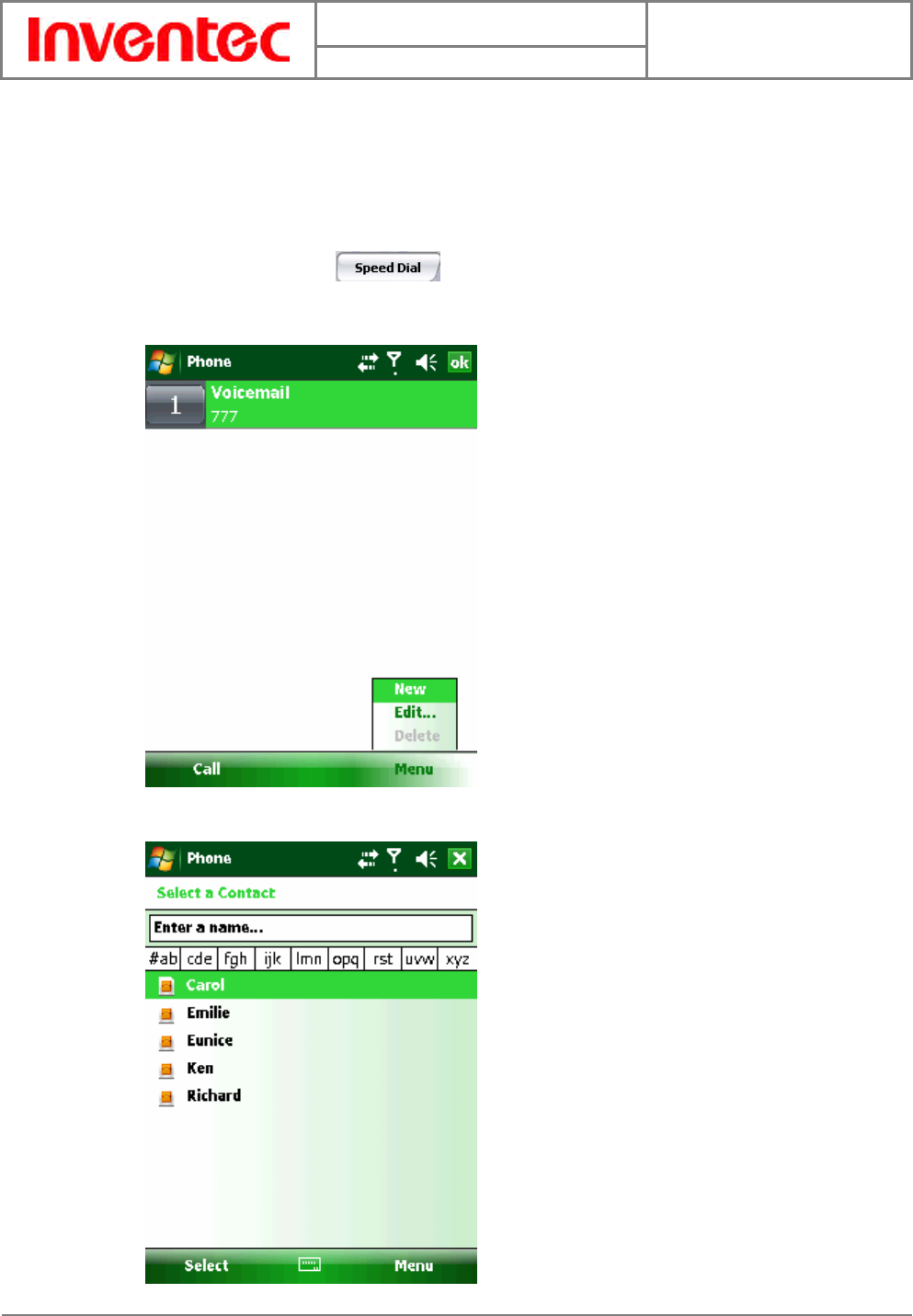
User Manual
Velocity 103
Version : 0.001
日 期 : 2008/05/06
36
INVENTEC CORPORATION
英業達股份有限公司
36
dial the contact’s number. Speed dials can be created only for numbers that are stored in
Contacts.
To create a speed dial entry for a contact
1. On Phone Keypad, tap .
2. Tap Menu and then tap New.
3. Tap the contact for whom to create a speed dial.
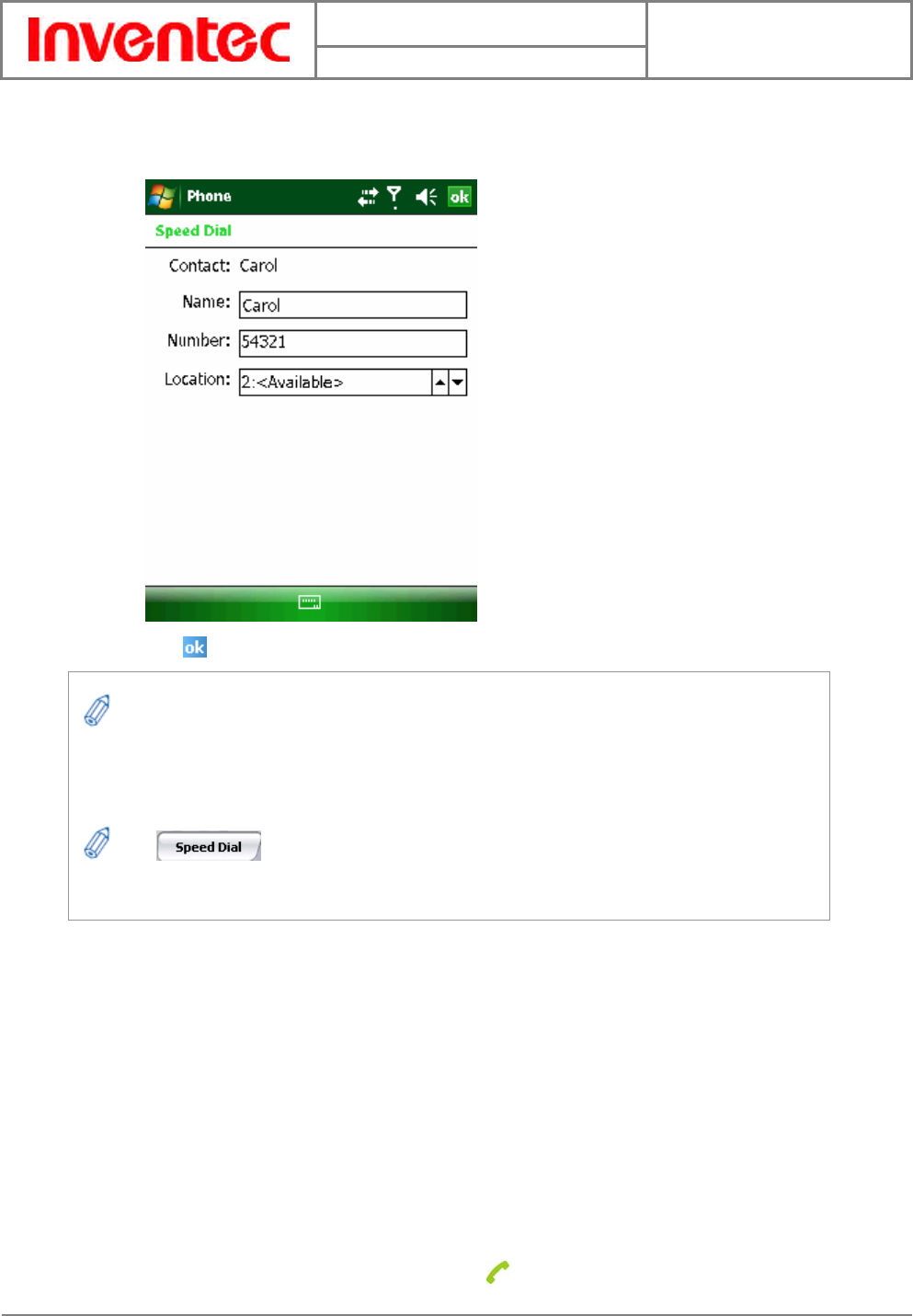
User Manual
Velocity 103
Version : 0.001
日 期 : 2008/05/06
37
INVENTEC CORPORATION
英業達股份有限公司
37
4. Select the phone number for which to create a speed dial.
5. In Location, select the speed dial number to use.
6. Tap when finished.
To delete a speed dial entry
z In the Speed Dial list, tap Menu and then tap Delete.
To retrieve a voicemail message
z On the Today screen, press and hold 1 to access your voice mailbox, and follow the
prompts to retrieve your messages.
Receiving/Rejecting a Call
When you receive a phone call, you have the option to answer it or ignore it.
To receive a call
z Tap Answer on-screen or press TALK ( ) to accept an incoming call.
The first speed dial location is generally reserved for your voice mail. Speed Dial uses
the next available location by default. If you want to place a number in a location that is
already used, the new number replaces the existing number.
Tap on the Phone Keypad to check the success of creatin
g
a Speed Dial
entry.
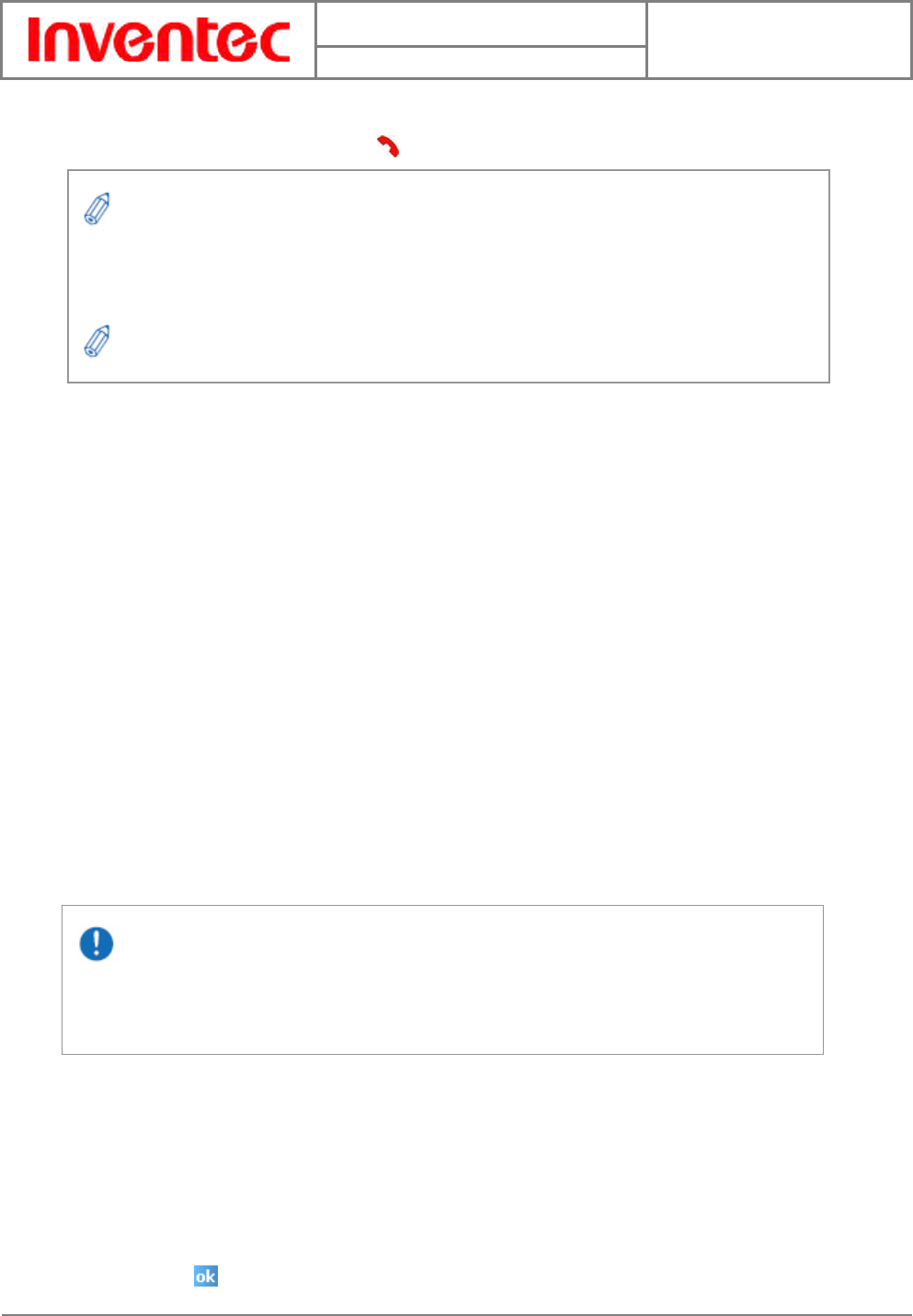
User Manual
Velocity 103
Version : 0.001
日 期 : 2008/05/06
38
INVENTEC CORPORATION
英業達股份有限公司
38
To end a call
z Tap Ignore or press END ( ) to hang up a call.
4.2 Configuring the Phone
Your wireless service provider may provide useful services such as Call Barring, Caller ID, Call
Forwarding, Call Waiting, Voice Mail and Text Messages and Fixed Dialing. You can get these
settings from the Network and change them.
Activating PIN Security
Most Subscriber Identity Module (SIM) cards are preset with a personal identification number
(PIN) that is provided by your wireless service provider. When PIN Security is activated, you
need to enter the PIN whenever you use your phone.
1. Tap Start, tap Settings, tap Phone, and then select Require PIN when phone
is used.
2. Enter the preset PIN provided by your wireless service provider.
3. Tap Enter.
Changing the Ring Type and Ring Tone
You can choose how to be notified for incoming calls.
1. Tap Start, tap Settings, and then tap Phone.
2. In the Ring type list, tap the desired option.
3. In the Ring tone list, select the sound you want to use.
4. Tap .
To adjust the earpiece volume during a call, roll the scroll wheel up/down on the phone
side panel. Adjusting the volume at any other time to change sound levels for the phone
ringer, system notifications and music.
You can mute the volume of incoming calls by scrolling the wheel all the way down.
If your PIN is entered incorrectly three times, the SIM card will be blocked. If this
happens, you can unblock it with the PIN Unblockin
g
Key (PUK) obtained from your wireless
service provider.
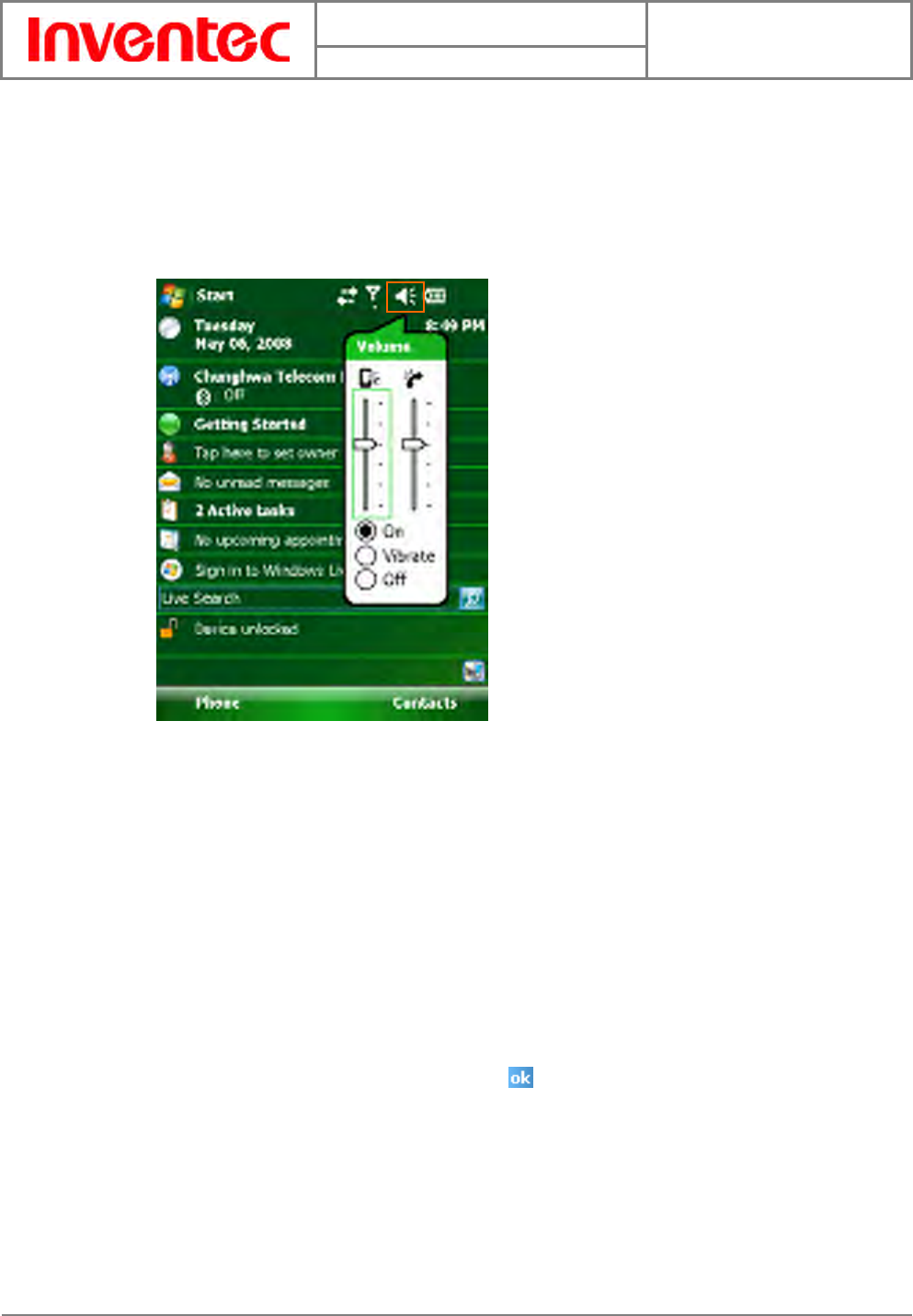
User Manual
Velocity 103
Version : 0.001
日 期 : 2008/05/06
39
INVENTEC CORPORATION
英業達股份有限公司
39
Changing the Ringer Volume
You can press Volume on the left side of the device to change the ringer volume or do the
following:
1. Tap the volume button on the screen.
2. Do either of the following:
z Move the slider to the desired volume level.
z Select On, Vibrate, or Off to quickly change both the ringer and system and
settings.
Blocking Incoming or Outgoing Calls
Please note that, depending on the options you choose here, you may not be able to receive or
make calls.
1. Tap Start, tap Settings, tap Phone, and then tap the Services tab.
2. Tap Call Barring and then tap Get Settings.
3. Choose the calls you want to block, and tap .
z Block incoming calls: All calls, When roaming, Off.
z Block outgoing calls: All calls, International, International except to home
country, Off.
Displaying Caller ID
You can provide a way for people to see your number when you are calling them.
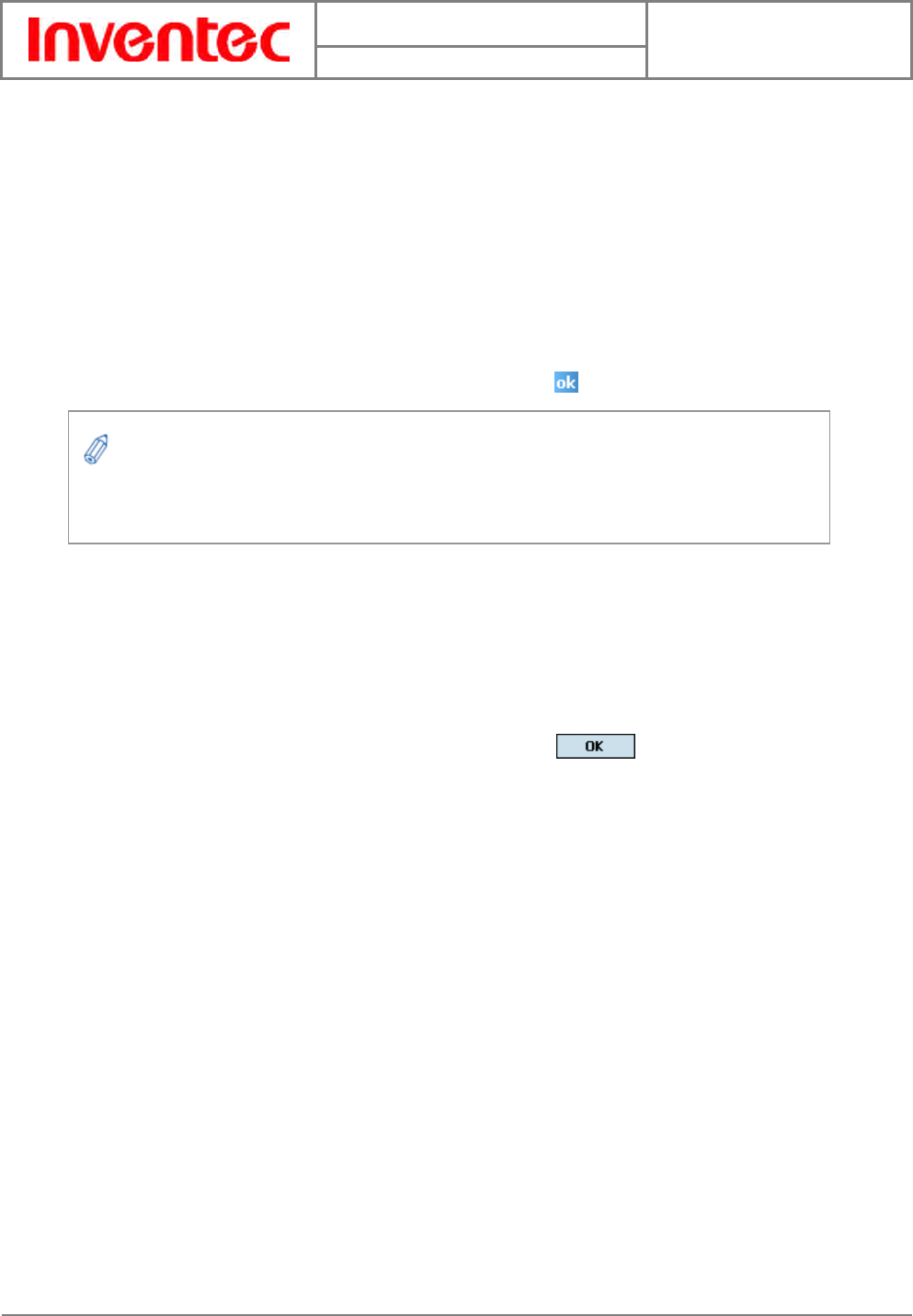
User Manual
Velocity 103
Version : 0.001
日 期 : 2008/05/06
40
INVENTEC CORPORATION
英業達股份有限公司
40
1. Tap Start, tap Settings, tap Phone, and then tap the Services tab.
2. Tap Caller ID and then tap Get Settings.
3. Select Everyone, No one or Only to contact.
Call Waiting
When you are in another call, you will be notified of an incoming call if this option is selected.
1. Tap Start, tap Settings, tap Phone, tap the Services tab, tap Call Waiting, and
then tap Get Settings.
2. Select Notify me or Do not notify me, and tap .
Selecting a Network Manually
1. Tap Start, tap Settings, tap Phone, and then tap the Network tab. Alternatively,
you can tap Menu, tap Options, and then tap Network from the Phone Screen.
2. In the Network selection list, tap Manual. The list of available networks will be
displayed.
3. Select the network you want to use, and then tap .
Another way of changing phone settings is to select Menu > Options > Services
from the Phone keypad.

User Manual
Velocity 103
Version : 0.001
日 期 : 2008/05/06
41
INVENTEC CORPORATION
英業達股份有限公司
41
Chapter 5. Contacts & Messaging
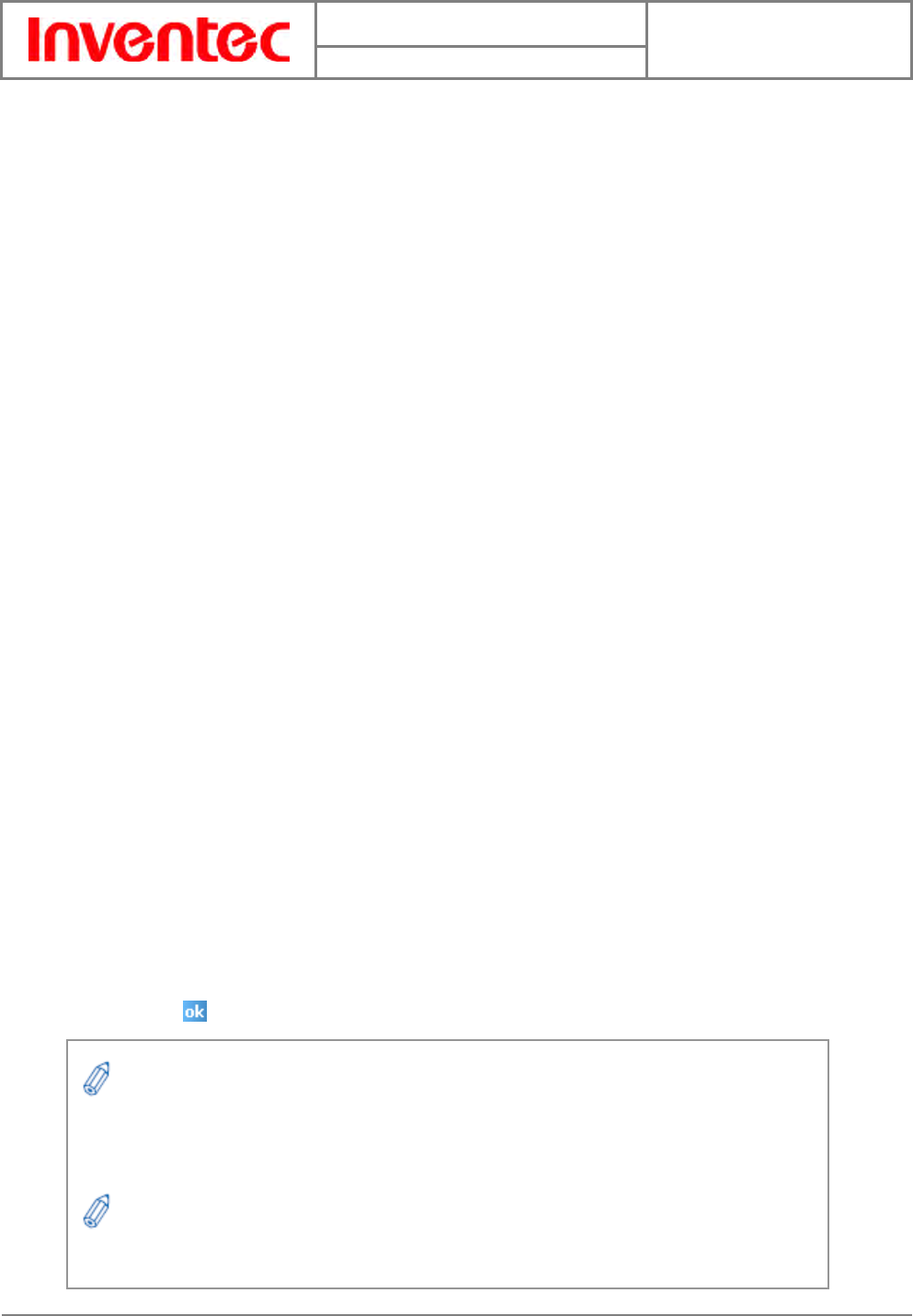
User Manual
Velocity 103
Version : 0.001
日 期 : 2008/05/06
42
INVENTEC CORPORATION
英業達股份有限公司
42
The Contacts application helps you to manage your contact information for friends, family and
business associates.
The Messaging application is the unified point of access for all message types within your
device. With Messaging, you can send and receive text messages, e-mails, and MMS messages.
This section describes how to send and receive different kinds of messages, and how to use
Contacts to manage addresses and phone numbers.
5.1 Using Contacts
Contacts is your address book and information storage for the people and businesses you
communicate with. This is where you can store phone numbers, e-mail addresses, home
addresses, and any other information that relates to a contact (such as a birthday or an
anniversary date). You can also add a picture or assign a specific ring tone to a contact.
You can quickly communicate with people using the contact list. Click a contact in the list for a
summary of contact information and available communication methods. This summary page
will allow you to call or send a message, depending on the information available for that
contact.
If you use Outlook on your PC, you can synchronize contacts between your phone and PC.
Creating a New Contact
1. Tap Start, tap Contacts, and then tap New.
2. Select Outlook Contact.
3. Enter information for the new contact.
4. Tap .
If someone who isn't in your list of contacts calls you or sends you a messa
g
e, you can
create a contact from Call History or from the message by tapping Menu and then tapping
Save to Contacts.
To save an existing contact to your SIM card, open the contact, tap Menu and then tap
Save to SIM.

User Manual
Velocity 103
Version : 0.001
日 期 : 2008/05/06
43
INVENTEC CORPORATION
英業達股份有限公司
43
Viewing and Editing Contact Information
1. Tap Start, and then tap Contacts.
2. Tap the contact whose information you want to view.
3. To edit the information, tap Menu and then tap Edit.
4. Do any of the following:
z Tap Picture and select a picture you want to add. This can be an existing
picture, or you can take a new picture using the Camera application.
z Tap Ring Tone and select the ring tone you want to use for this contact. This
will allow you to know who is calling without having to look at the screen.
5. When finished making changes, tap .
Sending an E-mail to a Contact
1. Tap Strat and then tap Contacts.
2. Select the contact from the list.
3. Select the e-mail account to use.
4. Enter a subject, compose your message, and then tap Send.
Sending a Text Message to a Contact
1. Tap Start and then tap Contacts.
2. Tap the contact you want to send a text message to, and tap Send text message.
3. Compose your message, and tap Send.
Creating a SIM Contact
Contacts can be created and stored on a subscriber identity module (SIM.) If you move the SIM
to another phone, your SIM contacts are moved as well.
1. Tap Start, tap Contacts, and then tap New.
2. Select SIM Contact.
3. Enter the name and phone number of the contact and tap .
5.2 Using SIM Manager
The SIM Manager helps you to manage the phonebook in your SIM card. Using the SIM
Manager, you can easily transfer phonebook entries from your SIM card to Contacts.
Adding a Phonebook Entry to the SIM Card
Please note that SIM card contacts can store far less information than Outlook contacts. There
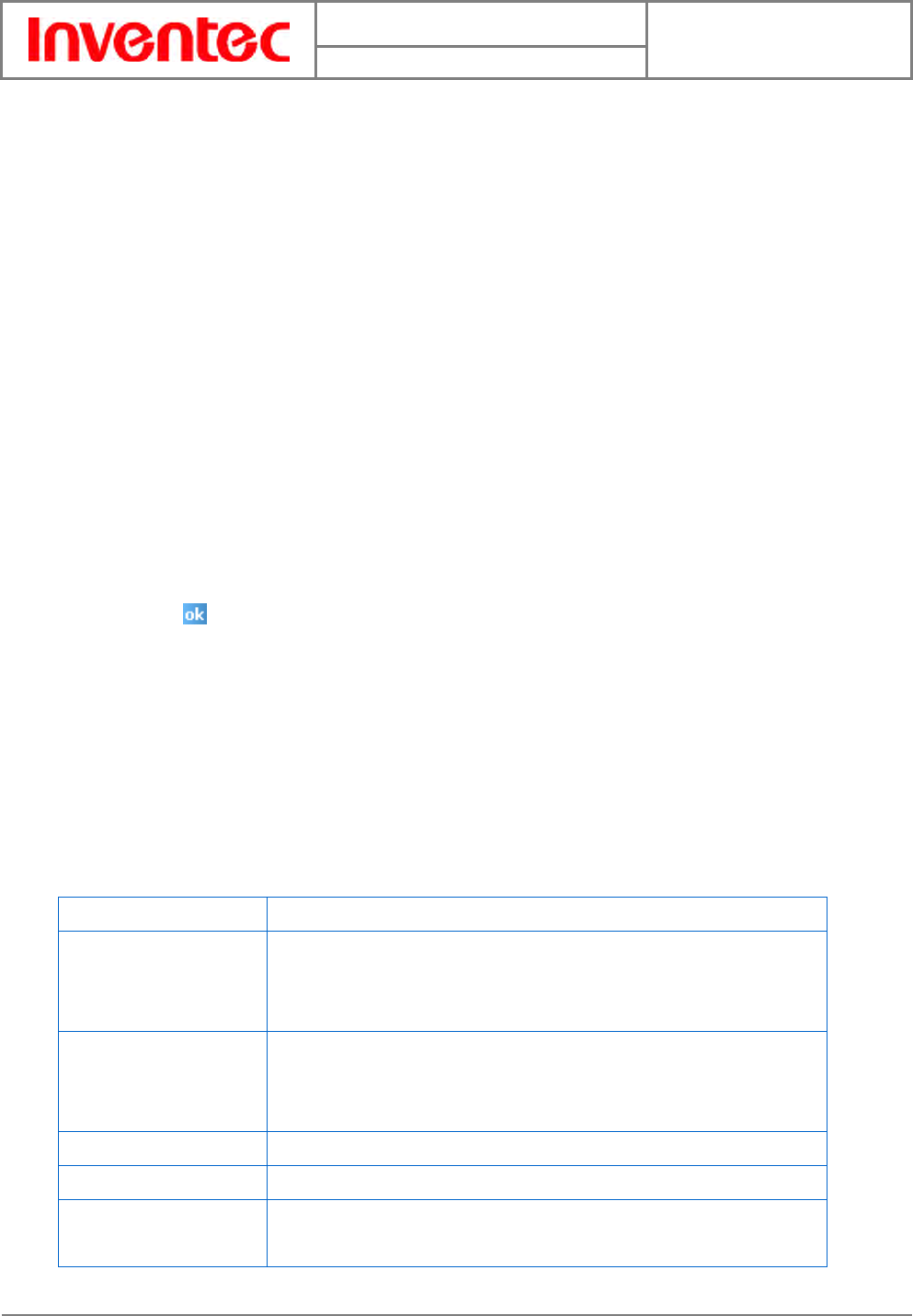
User Manual
Velocity 103
Version : 0.001
日 期 : 2008/05/06
44
INVENTEC CORPORATION
英業達股份有限公司
44
is a restriction on the length of the contact name, and you can only have one number per
contact.
1. Tap Start, tap Programs, and then tap SIM Manager.
2. Tap Add and enter the name and phone number you want to add.
3. Tap the Add button.
Deleting a Phonebook Entry from the SIM Card
1. Tap Start, tap Programs, and then tap SIM Manager.
2. Select an entry you want to delete, tap Menu and then tap Delete.
3. Tap Yes to confirm that you want to delete the contact.
Saving Phonebook Entries to Contacts
1. Tap Start, tap Programs, and then tap SIM Manager.
2. Select the entries you want to save to Contacts by checking the checkboxes in front.
3. Tap Menu, and then tap Save to Contact.
4. Tap to close the notification dialog box.
5.3 E-mail
Setting Up an E-mail Account
Before you set up your Internet e-mail account, please ensure that you have the necessary
information from your e-mail service provider. The kind of information you’ll need to have ready
is tabulated below. Use this as a check-list before proceeding with the account set-up.
Setting Description
User name Usually the first part of your e-mail address, which appears before
the “at” sign (@). For some e-mail service providers, the full e-mail
address is used as the user name.
Password Choose a strong password. You will have the option to save your
password, so that you do not need to enter it each time you
connect to your e-mail server.
Domain The domain name. This may not always be required.
Server type The type of e-mail server that hosts your mailbox (POP3 or IMAP4).
Account name A friendly name for this account (e.g. “My Webmail”). You must use
a different name for each account that you set up.
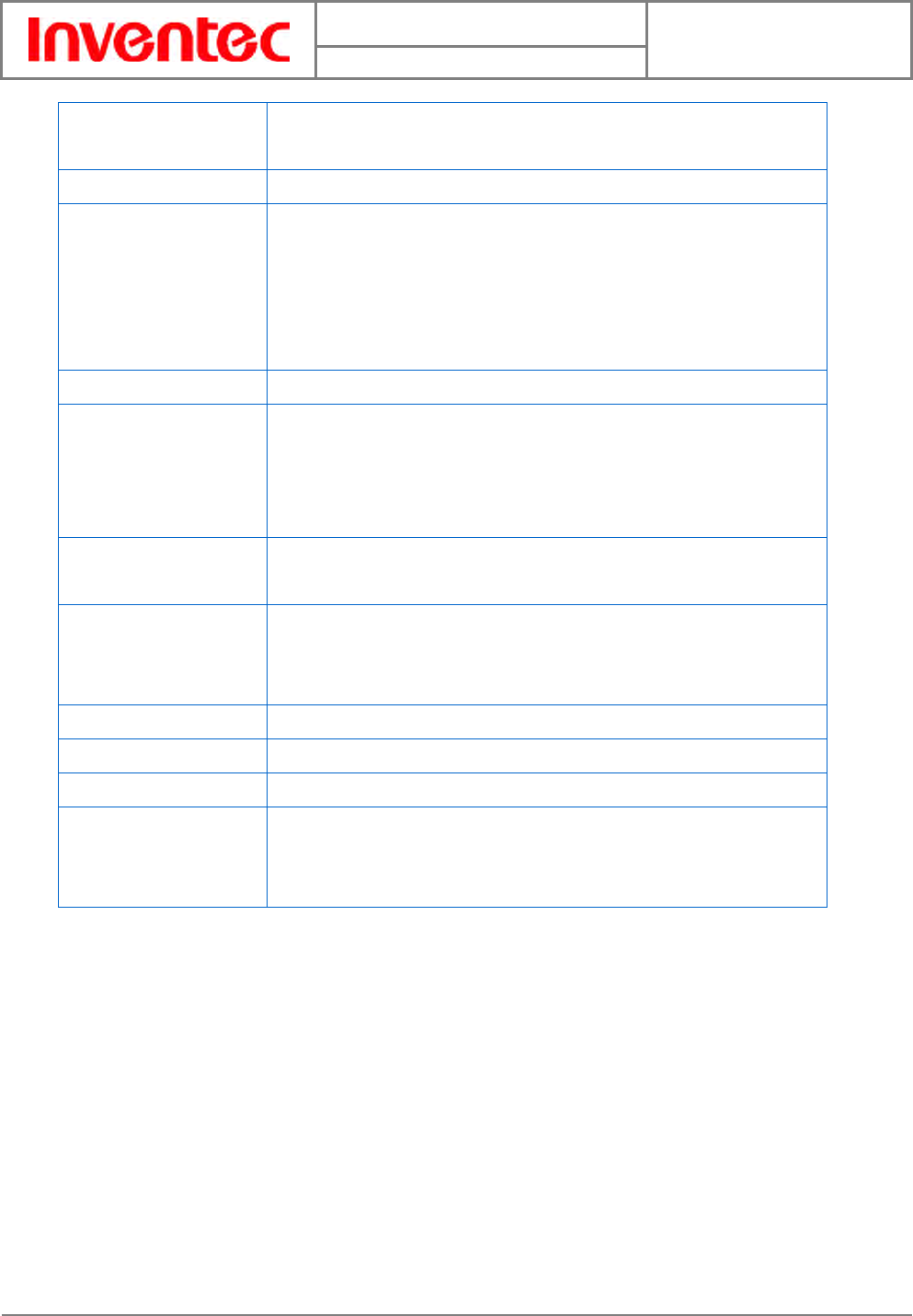
User Manual
Velocity 103
Version : 0.001
日 期 : 2008/05/06
45
INVENTEC CORPORATION
英業達股份有限公司
45
Network The type of network your e-mail server connects to (e.g. Work or
The Internet).
Incoming mail server The name of your e-mail server (POP3 or IMAP4).
Require SSL connection Select this to ensure you always receive e-mail for this account
using an SSL connection. This enables you to receive personal
information more securely. Please note that if you select this and
your ISP does not support an SSL connection, you will not be able
to connect to receive e-mail.
Outgoing mail server The name of your outgoing e-mail server (SMTP).
Outgoing server
requires authentication
Your outgoing e-mail server (SMTP) may require authentication.
Note: unless otherwise specified in the next section, your
previously given user name and password will be used for
authenticating against the outgoing e-mail server.
Outgoing server
settings
Your outgoing e-mail server may require different authentication
settings than your incoming e-mail server.
Use different user
name for outgoing
server
A checkbox that lets you enter separate settings for your outgoing
e-mail server.
User name Your user name for the outgoing e-mail server.
Password Your password for the outgoing e-mail server.
Domain The domain name of the outgoing e-mail server.
Require SSL connection
(Outgoing mail server
only)
A connection that enables you to send personal information more
securely. Note that if you select this and your ISP does not support
an SSL connection, you will not be able to send e-mail.
Now you are ready to set up your account:
1. Tap Start, tap Messaging, and then select Setup E-mail.
2. Enter your e-mail address and password. Select Save password if you want, or you
can enter the password each time you send and receive e-mail. Then tap Next.
3. Tap Next. If the device is connected to the internet, the Auto Setup feature will
attempt to retrieve settings for this e-mail account, saving you the effort of typing in
all the required settings. If no matching settings are found (or if no internet
connection exists), then you will need to enter each setting manually.
4. Enter the name you want to appear when you send messages, and then tap Next.
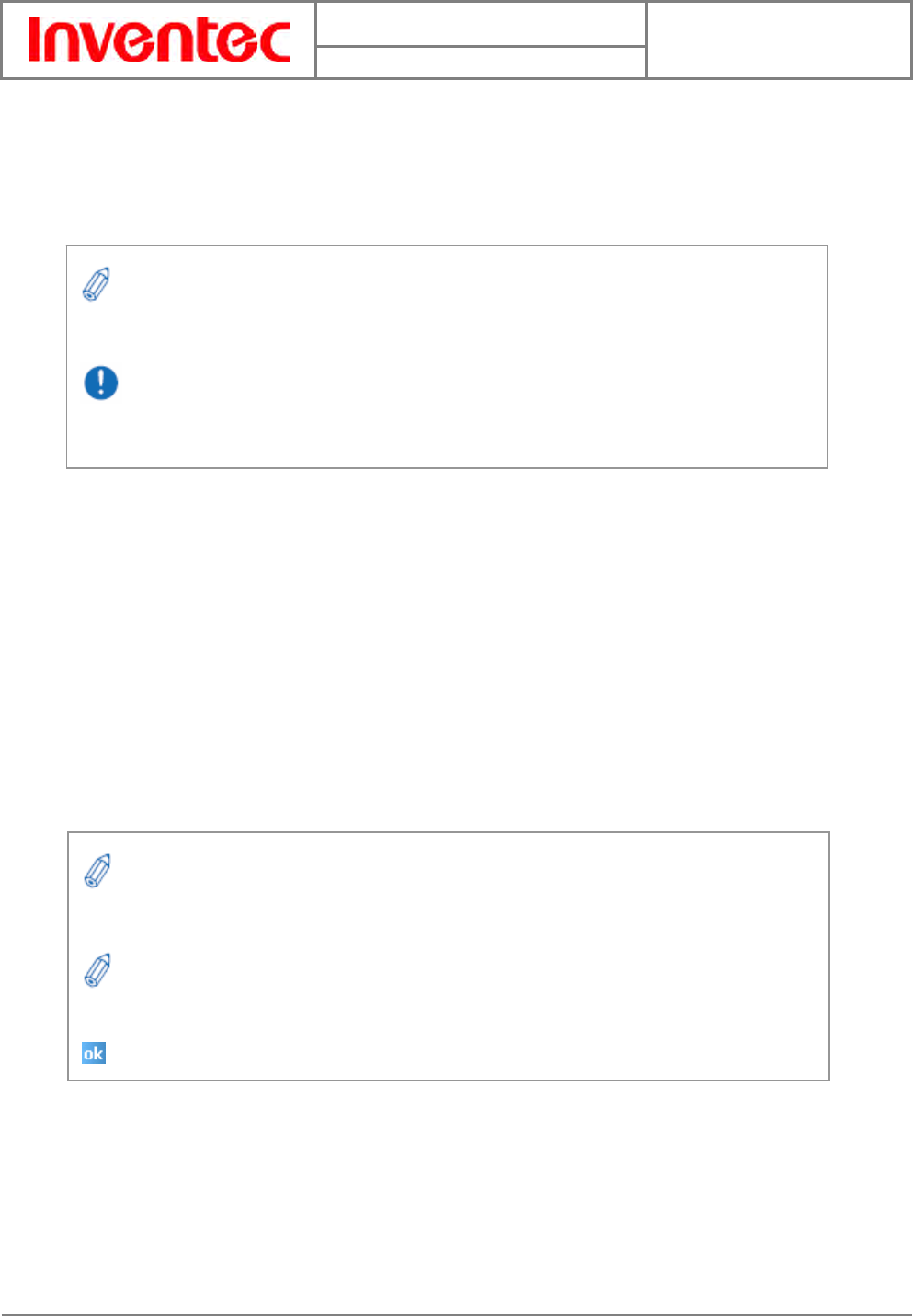
User Manual
Velocity 103
Version : 0.001
日 期 : 2008/05/06
46
INVENTEC CORPORATION
英業達股份有限公司
46
5. In Automatic Send/Receive, select a frequency for sending/receiving e-mail.
Please note that data charges will probably be incurred if you send and receive e-mail
outside of WiFi or Bluetooth range. Tap Review all download settings to change
your e-mail settings; otherwise, tap Finish to start downloading messages.
Composing an E-mail Message
1. Tap Start and then tap Messaging.
2. Select an e-mail account to use.
3. Tap Menu and then tap New. This will bring up a new e-mail form.
4. Enter recipient e-mail addresses in the To, Cc and/or Bcc fields as necessary. Insert a
semicolon (;) between multiple addresses.
5. In the Subject field, type in a subject.
6. Enter a message.
7. Tap Send. E-mail messages are stored in Outbox and are sent to recipients the next
time you synchronize or connect to your e-mail server and send and receive mail.
Reading an E-mail Message
1. Tap Start, tap Messaging, and then select an e-mail account..
2. Make sure the folder drop-down menu says Inbox▼. If it doesn’t, tap the drop-down
menu and select Inbox under this e-mail account.
3. In the e-mail list, tap the e-mail message you want to read.
To change options for an e-mail account, tap Start, tap Messaging, tap Menu, tap
Options, and then select the type of options to change.
If you save your password and then lose your phone, someone finding your phone
might be able to gain access to your e-mail.
You can quickly enter e-mail addresses from your contact cards. In the To field, press
ENTER and select a recipient from the list. Then, select the recipient’s e-mail address.
To change message settings such as its priority, tap Menu and then tap Message
Option in the message you are editing. Select the type of options to change and then tap
.

User Manual
Velocity 103
Version : 0.001
日 期 : 2008/05/06
47
INVENTEC CORPORATION
英業達股份有限公司
47
Unread e-mails are normally listed in the Messa
g
in
g
item on the Today screen. You can
access unread e-mails directly by tapping the Messaging item on the Today screen.

User Manual
Velocity 103
Version : 0.001
日 期 : 2008/05/06
48
INVENTEC CORPORATION
英業達股份有限公司
48
Chapter 6. Basic Applications
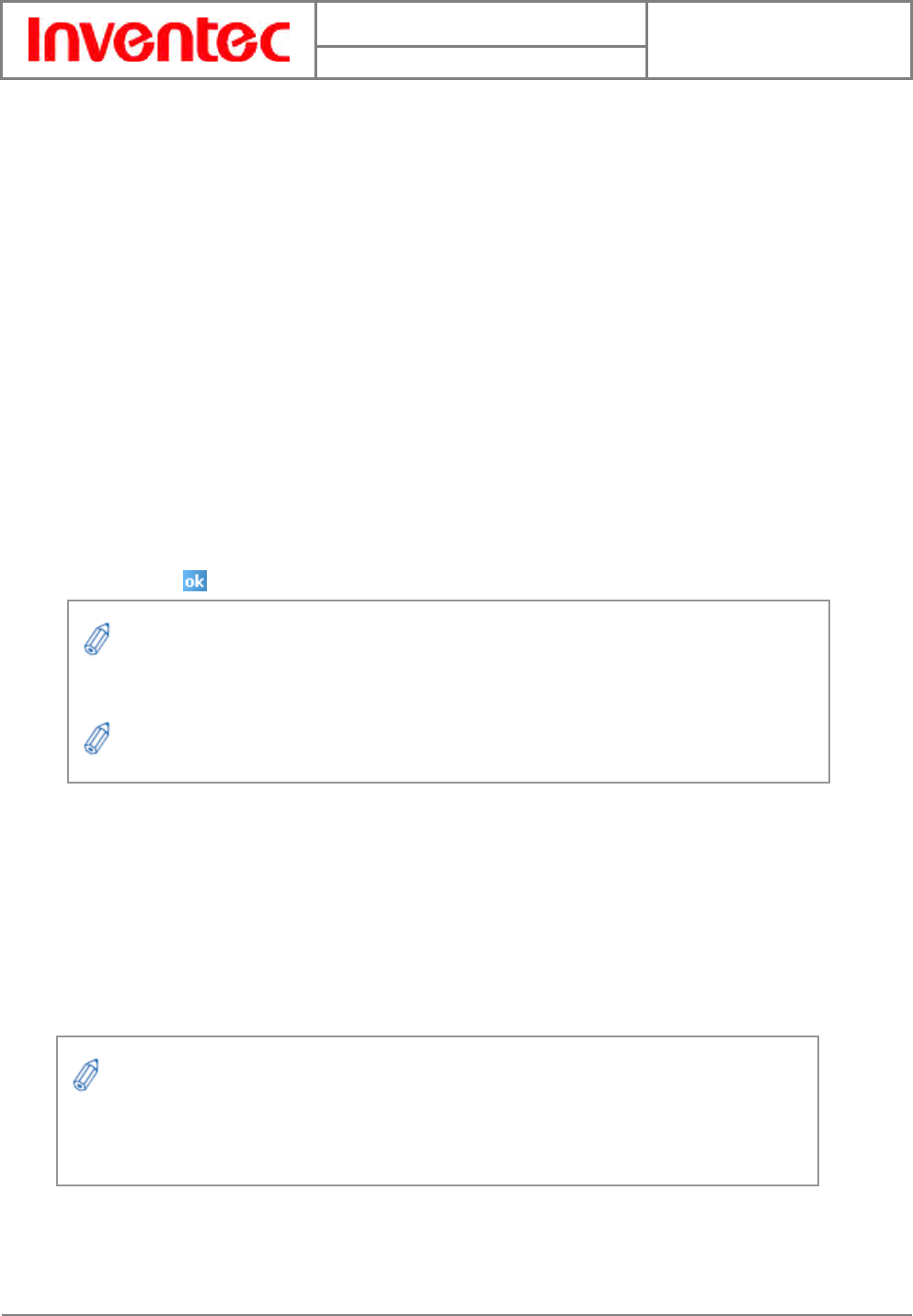
User Manual
Velocity 103
Version : 0.001
日 期 : 2008/05/06
49
INVENTEC CORPORATION
英業達股份有限公司
49
6.1 Using Calendar
Use the Calendar application to schedule appointments, including meetings and other events.
Your appointments for the day can be displayed on the Today screen. If you use Outlook on
your PC, you can synchronize appointments between your device and PC. You can also set
Calendar to remind you of appointments with an audible alarm or flashing light.
You can look at your appointments in several different views (Day, Week, Month, Year and
Agenda). To see detailed appointment information in any view, tap the appointment.
Making an Appointment
1. Tap Start and then tap Calendar. Alternatively, you can tap the appointment item on
the Today Screen.
2. Tap Menu and then tap New Appointment.
3. Enter information about the appointment.
4. Tap to save the appointment.
Deleting an Appointment
1. Tap Start and then tap Calendar.
2. In Agenda/Day/Week view, select the appointment to delete.
3. Tap Menu and then tap Delete Appointment.
4. If the appointment is recurring, tap All to delete the series, or tap One to delete only
the current occurrence.
Changing the Default Calendar Settings
1. Tap Start and then tap Calendar.
When you delete an appointment in Calendar on your phone, it is also deleted on your
PC the next time you synchronize. If the appointment has not been synchronized with a PC,
it will be deleted only from the phone.
If you make this appointment as an all-day event, it will not occupy blocks of time in
Calendar; instead, it will appear in banners at the top of the Calendar view.
You can assign a category to an appointment or create a new category for it.

User Manual
Velocity 103
Version : 0.001
日 期 : 2008/05/06
50
INVENTEC CORPORATION
英業達股份有限公司
50
2. Tap Menu, tap Tools, tap Options and then do one of the flowing:
z To assign a default view, in Start in, select Agenda View, Day View, Week
View, Month View or Year View.
z To specify the first day of the week, in 1st day of week, tap Sunday or
Monday.
z To specify the number of days you want to appear in a week, in Week view,
tap 5-day week, 6-day week, or 7-day week.
3. Tap to save settings.
6.2 Using Notes
The Notes application helps you to quickly capture thoughts, questions, reminders, to-do lists,
and meeting notes. You can create handwritten and typed notes, record voice notes, convert
handwritten notes to text for easy readability, and send notes to others.
Your notes and recordings are displayed in the note list. If you have a long list, tap the sort list
(labeled Name by default), and select the option you want. To open a note or play a recording,
tap it. To see a list of available actions for a note or recording, tap and hold the note or
recording.
Creating a Note
1. Tap Start, tap Programs, and then tap Notes.
2. Tap New and enter text.
3. Tap to save your note.
Setting the Default Input Mode for Notes
1. Tap Start, tap Programs, and then tap Notes.
2. Tap Menu > Options
3. Select one of the following modes in Default mode:
z Select Writing if you prefer your notes to be handwritten.
z Select Typing if you would like your notes to be typed.
4. Tap .
Creating a Stand-alone Voice Recording
1. Tap Start, tap Programs, and then tap Notes.
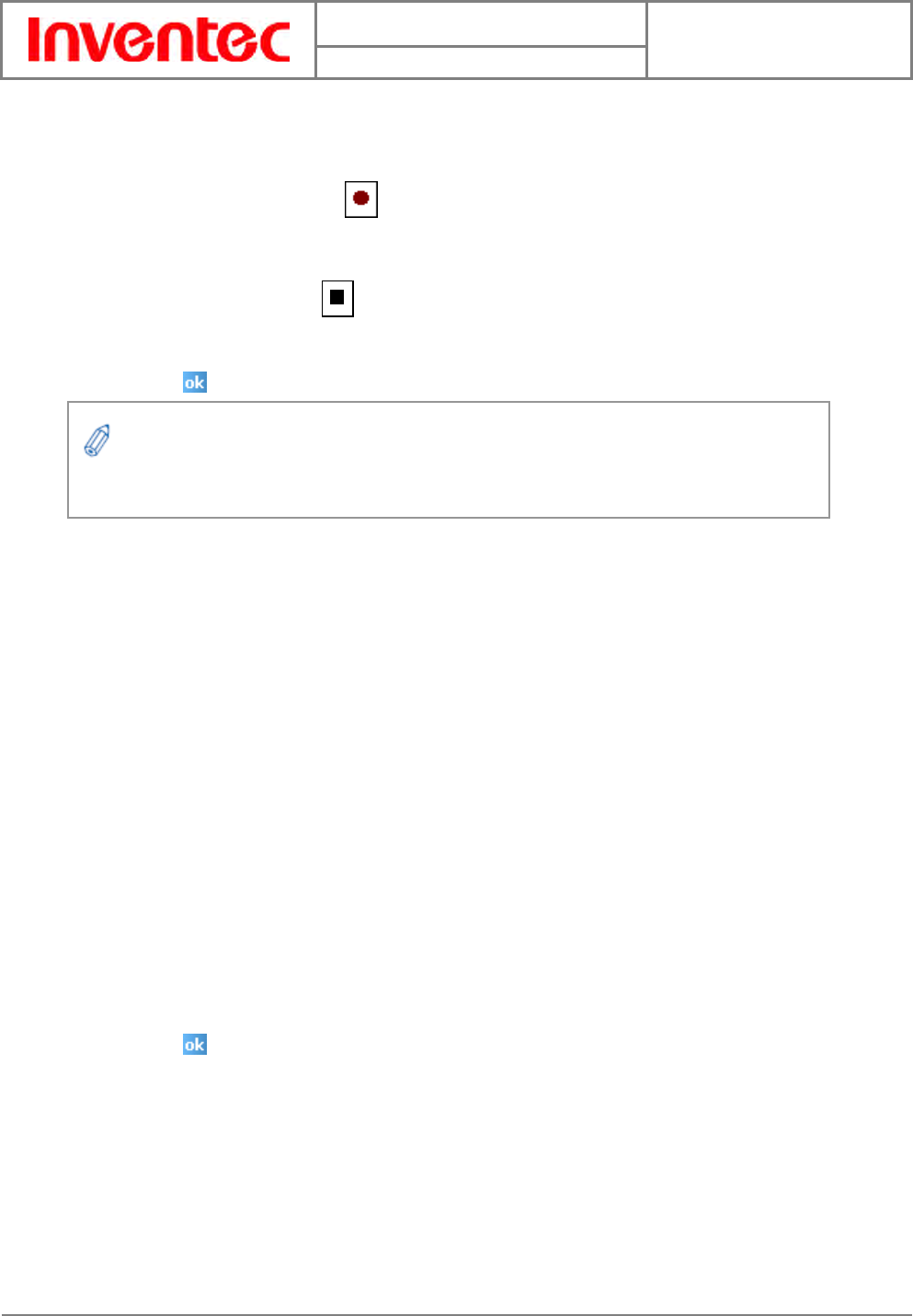
User Manual
Velocity 103
Version : 0.001
日 期 : 2008/05/06
51
INVENTEC CORPORATION
英業達股份有限公司
51
2. If the recording toolbar is not shown, tap Menu and then tap View Recording
Toolbar.
3. Tap the RECORD button on the recording toolbar and speak into the microphone
to start a voice recording.
4. Tap the STOP button on the recording toolbar when finished. The recording will
appear in the notes list, and you can review it by tapping it.
5. Tap to return to the notes list.
Switching between Typing/Writing Modes
1. Tap Start, tap Programs, and then tap Notes.
2. Create a new note or open an existing note from the notes list.
3. Tap Menu and then tap Draw to switch to a different mode.
Deleting a Note
1. Tap Start, tap Programs, and then tap Notes.
2. Tap and hold the note and then tap Delete.
3. Tap Yes to confirm deleting the selected note.
Choosing a Default Note Template
1. Tap Start, tap Programs, and then tap Notes.
2. Tap Menu and then tap Options.
3. Select a template from Default template.
4. Tap to save your settings.
6.3 Using Tasks
Use Tasks to keep track of things you need to do. A task can occur once or repeatedly
(recurring). You can set reminders for your tasks and you can organize them by using
categories.
Except creating a stand-alone voice recording, you can also add a voice recordin
g
to a
note.
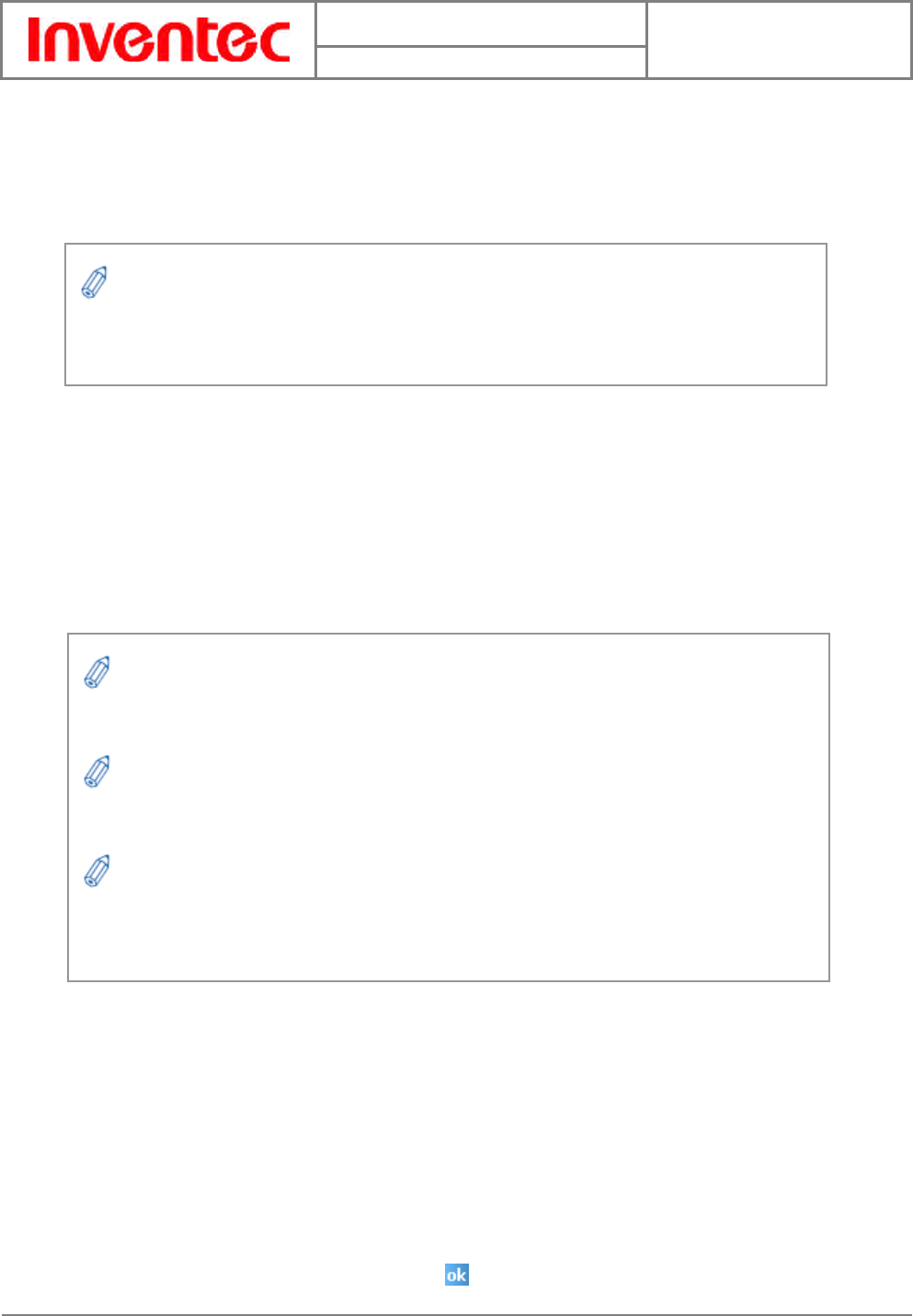
User Manual
Velocity 103
Version : 0.001
日 期 : 2008/05/06
52
INVENTEC CORPORATION
英業達股份有限公司
52
Your tasks are displayed in a task list. Overdue tasks are displayed in red.
If you use Outlook on your PC, you can synchronize tasks between your device and PC so that
tasks you create or update on your PC will also be updated on your device and vice versa.
Creating a Task
1. Tap Start, tap Programs, and then tap Tasks.
2. Do one of the following:
z Tap the box labeled Tap here to add a new task, enter the task name and
press the jog ball.
z Tap Menu, tap New Task, and then enter details about the new task.
Deleting a Task
1. Tap Start, tap Programs, and then tap Tasks.
2. Select the task, tap Menu, and then tap Delete Task.
Changing a Task
1. Tap Start, tap Programs, and then tap Tasks.
2. Select an existing task, and tap Edit.
3. When finished making changes, tap .
You can synchronize information on your phone with your PC to keep your task list up
to date in both locations.
If you create a new task with a reminder on your PC and then synchronize tasks with
your phone, the reminder will play at the time it was set on your PC.
You can assign a category to a task or create a new category for it. When editing a
task, tap Categories, tap New, and then give the new category a name. Tap Done and
the new category will appear in the list.
To quickly see the number of active tasks you have, tap Start and then tap Today. If
the Tasks item is enabled, you will see the number of active tasks listed on the Today
screen.

User Manual
Velocity 103
Version : 0.001
日 期 : 2008/05/06
53
INVENTEC CORPORATION
英業達股份有限公司
53
Sorting/Filtering Your Tasks
1. Tap Start, tap Programs, and then tap Tasks.
2. Do one of the following:
z To sort the tasks, tap Menu, tap Sort by, and then select a sorting option (e.g.
Status or Due Date).
z To filter the tasks by category, tap Menu, tap Filter, and then select a
category to display.
Setting Tasks Options
1. Tap Start, tap Programs, and then tap Tasks.
2. Tap Menu and then tap Options, there are 3 options you can set:
z Set reminders for new items
z Show start and due dates
z Show Tasks entry bar

User Manual
Velocity 103
Version : 0.001
日 期 : 2008/05/06
54
INVENTEC CORPORATION
英業達股份有限公司
54
Chapter 7. Connecting to the Internet

User Manual
Velocity 103
Version : 0.001
日 期 : 2008/05/06
55
INVENTEC CORPORATION
英業達股份有限公司
55
7.1 Setting up Internet connections
Your device’s powerful networking capabilities allow you to access the Internet or your
corporate network at work through telephony or wireless connections. Specifically, you can
configure your device to establish a connection via GPRS or a network Proxy.
With an active connection on your device, you can browse the Web, download e-mails, or use
Window Live Messenger. Check with your service provider to see if a connection has already
been set up for you, and if over-the-air configuration is supported.
If you need to manually set up a connection, it is important that you obtain the following
information from your Internet Service Provider (ISP) or the company whose intranet you are
trying to access:
z User name
z Password
z Access point name (required for GPRS connection)
z Domain name (required for accessing a corporate network or an intranet)
Creating a GPRS Connection
Every network connection is different. You should gather all of the relevant information or
network settings you need before starting this process.
1. Tap Start, tap Settings, tap the Connections tab, and then tap Connections.
2. Tap Add a new modem connection.
3. Enter the following information (you may or may not need to enter all of the following
information) and then tap Finish.
z Enter a name for the connection.
z In Select a modem, select Cellular Line (GPRS), and then tap Next to
continue.
z In Access point name, enter the access point name and then tap Next.
Access point name will be provided by your carrier.
z In User name, enter your user name for the GPRS network, if required. Again,
this has to be provided by your carrier.
z In Password, enter a password, if required.
z Tap Advanced > Servers tab. In DNS, enter the primary Domain Name
System (DNS) address, if required.
z In Alt DNS, enter the secondary DNS address, if required.
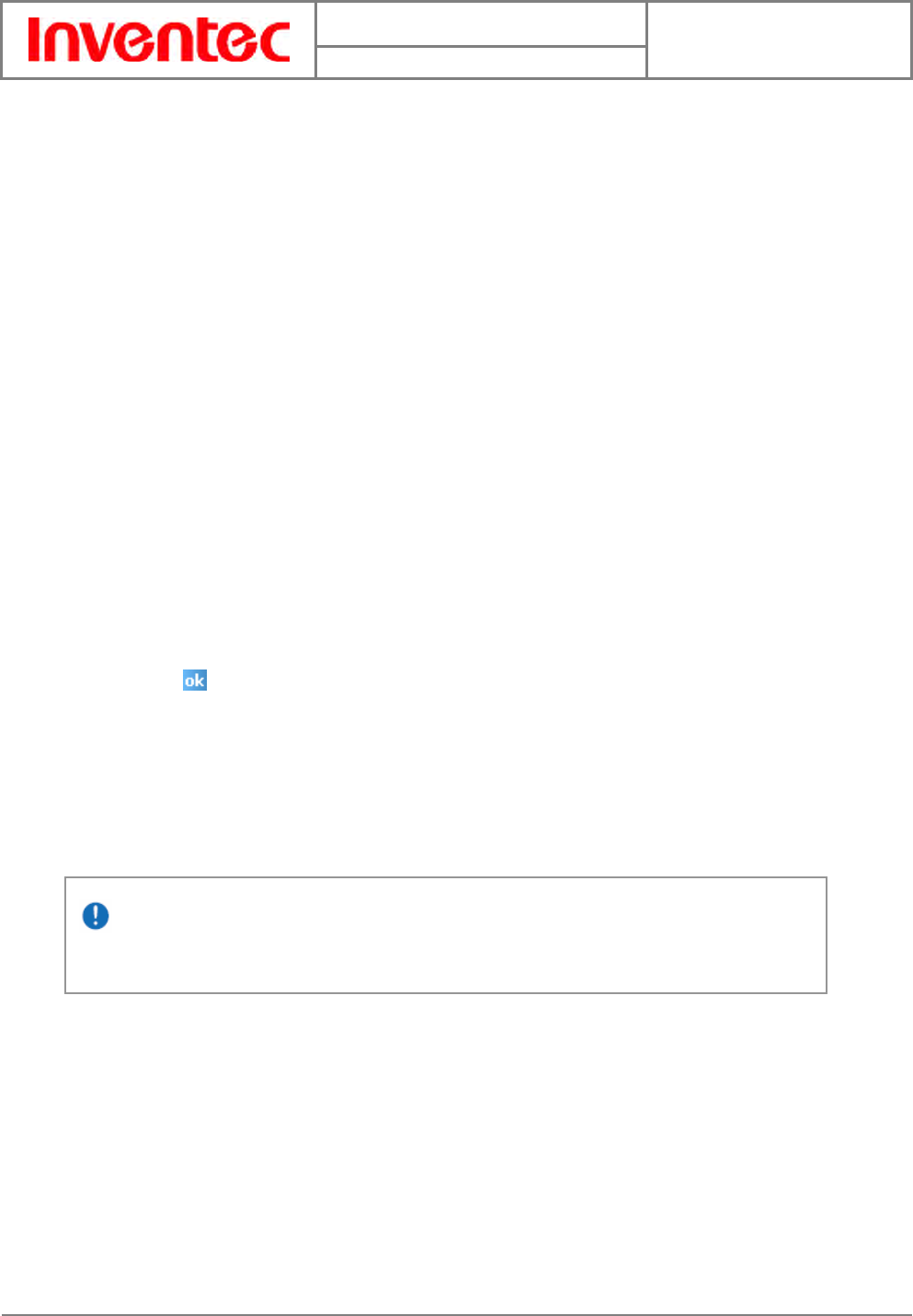
User Manual
Velocity 103
Version : 0.001
日 期 : 2008/05/06
56
INVENTEC CORPORATION
英業達股份有限公司
56
z Tap TCP/IP tab. In Use specific IP address, enter the Internet Protocol (IP)
address for the device, if required.
The phone uses this connection when you open a program that connects to the Internet.
Creating a Proxy Connection
Every network connection is different. You should gather all of the relevant information or
network settings you need before starting this process.
1. Tap Start, tap Settings, tap the Connections tab, and then tap Connections.
2. Tap Set up my proxy server.
3. Check the checkbox in front of This network connects to the Internet.
4. Check the checkbox in front of This network uses a proxy server to connect to
the Internet.
5. Under Proxy server, enter the proxy server name.
6. If the proxy server uses a different port or requires a username and password tap
Advanced, select the proxy type to change its settings, then enter username,
password and/or port number in the proper fields.
7. Tap .
Deleting a Connection
1. Tap Start, tap Settings, tap the Connections tab, and then tap connections.
2. Tap Manage existing connections in the My ISP section.
3. Tap and hold on the connection you want to delete and select Delete.
7.2 Using Internet Explorer Mobile
Internet Explorer Mobile is a full-featured Web browser, optimized for use on your phone. You
can use Internet Explorer Mobile to browse the Internet once you have set up your Internet
connection (if you haven’t done so, please read the previous section before continuing).
Browsing the Internet
1. To browse the Internet you must have a valid connection established.
The device cannot connect to a PC through ActiveSync while connecting to the
Internet using GPRS.
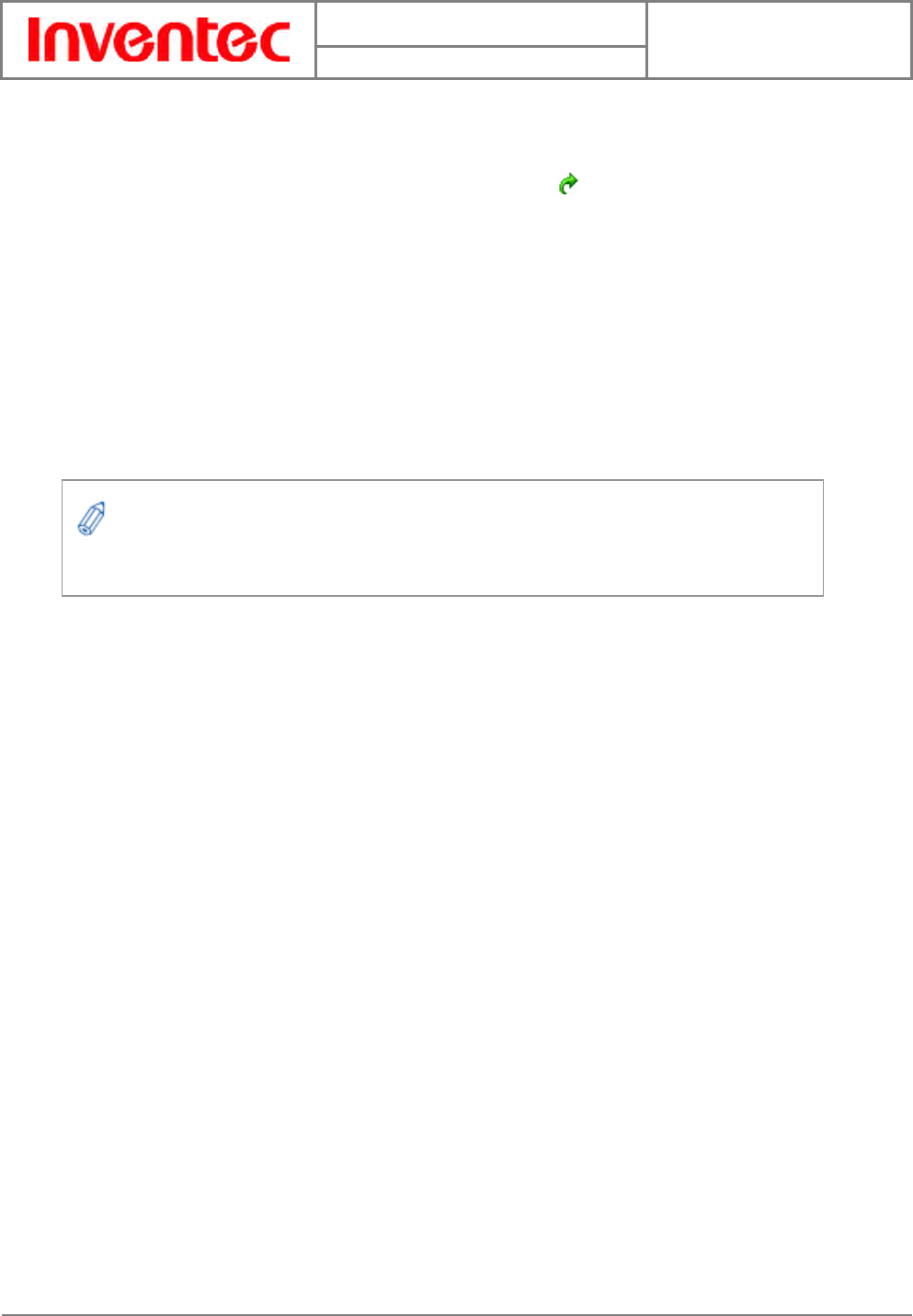
User Manual
Velocity 103
Version : 0.001
日 期 : 2008/05/06
57
INVENTEC CORPORATION
英業達股份有限公司
57
2. Tap Start and then tap Internet Explorer.
3. Do either of the following:
z Enter the address in the address bar, and tap .
z Tap Favorites, then select a Web Page from the list.
Adding a Web Page to the Favorite List
1. Tap Start and then tap Internet Explorer.
2. To go to the page you want to add, tap Menu and then tap Add to Favorites.
3. Confirm or change the name and Web page address.
4. In Create in, select a folder for this favorite.
5. Tap Add.
Deleting a Favorite
1. Tap Start and then tap Internet Explorer.
2. Tap Favorites.
3. Tap the Add / Delete tab.
4. Select the favorite to delete.
5. Tap the Delete button.
6. Tap Yes to confirm the deletion.
Changing the Size of Text on Web Pages
1. Tap Start and then tap Internet Explorer.
2. Tap Menu, tap View, tap Text Size, and then select the size you want.
Showing or Hiding Pictures on Web Pages
1. Tap Start and then tap Internet Explorer.
2. Tap Menu, tap View, and then tap Show Pictures. A check mark next to Show
Pictures indicates that pictures will be displayed. Un-check this item if you do not
want Internet Explorer to show pictures.
Changing Web Page Display Options
1. Tap Start and then tap Internet Explorer.
A quick way to add favorites to your phone is to synchronize with your PC using
ActiveSync. For more information, see ActiveSync Help on your PC.
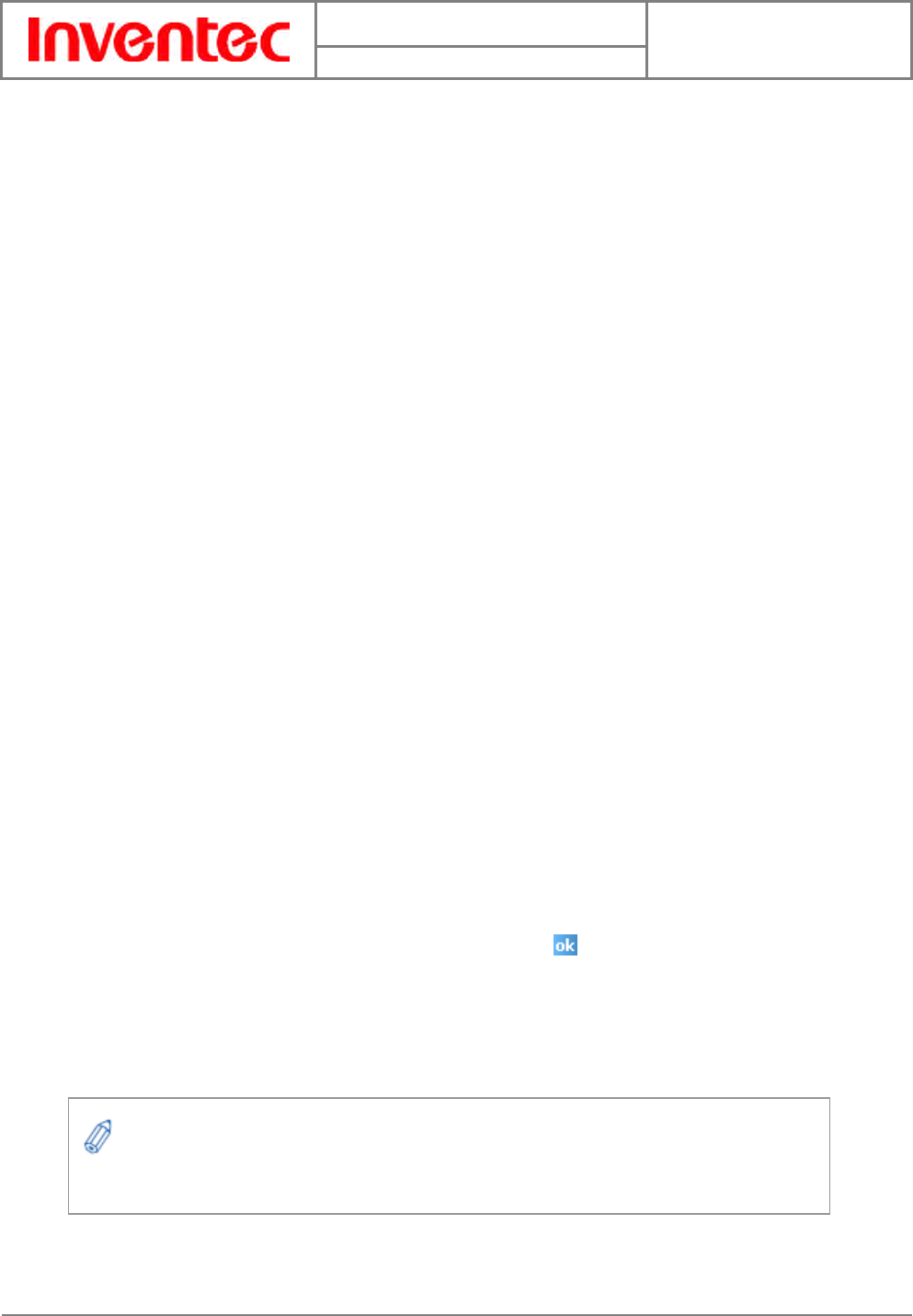
User Manual
Velocity 103
Version : 0.001
日 期 : 2008/05/06
58
INVENTEC CORPORATION
英業達股份有限公司
58
2. Tap Menu and then tap View.
3. Select one of the following:
z One Column. Arranges the content into one column that is as wide as the
screen. This means that you will rarely have to scroll horizontally.
z Fit To Screen. Maintains a layout similar to what you see on a desktop
computer, but makes items smaller and arranges the content so that you can
see most of it without having to scroll horizontally.
z Desktop. Keeps the same layout and size as on a desktop computer, which will
require both horizontal and vertical scrolling.
Send a Link via E-mail
1. Tap Start and then tap Internet Explorer.
2. Go to the page you want to send.
3. Tap Menu, tap Tools, and then tap Send Link.
4. The Messaging accounts list will appear. Select an account.
5. A new message is created with the page address inserted in the message body.
Choose a recipient, enter any accompanying message and then tap Send.
Clearing History, Cookies, or Temporary Files
From time to time you might want to clear up space on your device and wipe Internet Explorer’s
browser history.
1. Tap Start and then tap Internet Explorer.
2. Tap Menu, tap Tools, and then tap Options.
3. Tap the Memory tab.
4. Change the number in the day(s) box if needed.
5. Tap Clear History or Delete Files and then tap .
Viewing a Page in Full Screen Mode
1. Tap Start and then tap Internet Explorer.
2. Tap Menu, tap View, and then tap Full Screen.
To exit full screen mode, tap and hold on the screen, and then un-check the Full
Screen item in the pop-up menu to cancel the selection.

User Manual
Velocity 103
Version : 0.001
日 期 : 2008/05/06
59
INVENTEC CORPORATION
英業達股份有限公司
59
Chapter 8. Transferring Files To and From Your Device
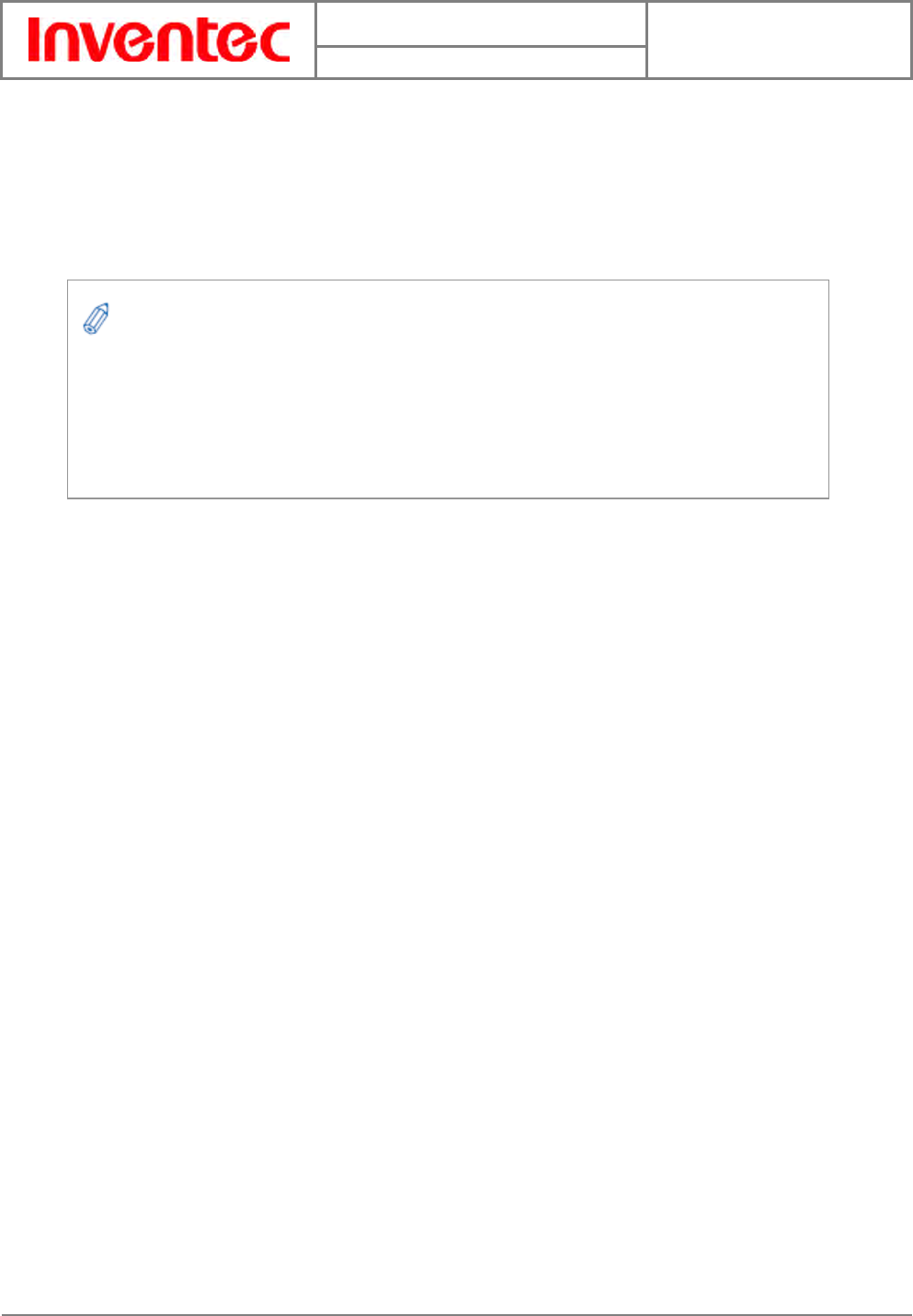
User Manual
Velocity 103
Version : 0.001
日 期 : 2008/05/06
60
INVENTEC CORPORATION
英業達股份有限公司
60
You might need to transfer application data such as Word documents, Excel spreadsheets,
PowerPoint slides, and/or media files from your PC to your device, and vice versa. This section
describes different methods for transferring files to and from your device.
8.1 Using ActiveSync
1. Connect your device to the PC with the USB cable. Microsoft ActiveSync on the PC
should start up the Synchronization Setup Wizard automatically..
2. Select an information type under Synchronization Options in the Synchronization
Setup Wizard by checking the appropriate checkbox.
3. Click the Settings button and add the files you want to transfer to the device. Click
the OK button when you finish.
4. Click Next, and then click Finish to start the synchronization process.
5. On your device, tap Start, tap Programs, and then tap File Explorer. The newly
transferred files should appear under My Documents. Check to see if the files have
been transferred to your device successfully.
8.2 Transferring from Memory Cards
1. Insert your memory card into the device’s MicroSD card slot.
2. Tap Start, tap Programs, and then tap File Explorer.
3. In the Show list, select Storage Card.
4. File Explorer should display all the files stored in your memory card. Tap and hold
the file or folder you want to transfer, and then select Copy from the pop-up menu.
5. From the Show list in File Explorer, choose the destination folder for the copied files.
(For example, tap My Device and then tap My Documents.)
6. In the destination folder, tap Menu, tap Edit, and then tap Paste.
8.3 Using Bluetooth
To transfer files from PC to your device with ActiveSync, Windows XP users must first
install Microsoft ActiveSync on the PC first. Windows Vista users do not need to install
ActiveSync, but should use Windows Mobile Device Center, which comes pre-installed with
Vista. Please refer to “Chapter 3. Synchronizing Information” for details on how to install
and set up ActiveSync.

User Manual
Velocity 103
Version : 0.001
日 期 : 2008/05/06
61
INVENTEC CORPORATION
英業達股份有限公司
61
Bluetooth is a short-range wireless communication technology. Devices with Bluetooth
capabilities can exchange information over a distance of about 10 meters without requiring a
physical connection. You can even beam information to a device in a different room, as long as
it is within range.
Before transferring files, you must turn on Bluetooth and establish a Bluetooth partnership
between your device and the other device (typically your PC, but it could equally be a headset
or another phone).
Turning on Bluetooth
1. Tap Start, tap Settings, tap the Connections tab, tap Bluetooth, and then tap the
Mode tab.
2. Select the Turn on Bluetooth option.
Creating a Bluetooth Partnership
1. Tap Start, tap Settings, tap the Connections tab, tap Bluetooth, and then tap the
Device tab.
2. Tap Add new device. Your device searches for other Bluetooth-enabled devices and
displays them in the list.
3. Select the device with which you want to create a Bluetooth partnership, and tap
Next. If the device you are looking for does not appear in the list, ensure that it is in
range and that it has been made discoverable, and then hit Refresh.
4. In Passcode, enter an alphanumeric passcode between 1 and 16 characters, and tap
Next. Otherwise, leave the passcode blank. For security reasons, it is strongly
recommended that you use a passcode.
5. Enter the same passcode on the other device (there will be a prompt to do so).
6. Select the service to use from the partner device, and tap Finish. One of the most
common examples of this is to choose the Microsoft ActiveSync service from the list of
your PC’s available Bluetooth services.

User Manual
Velocity 103
Version : 0.001
日 期 : 2008/05/06
62
INVENTEC CORPORATION
英業達股份有限公司
62
Appendix

User Manual
Velocity 103
Version : 0.001
日 期 : 2008/05/06
63
INVENTEC CORPORATION
英業達股份有限公司
63
A.1 Regulatory Notices
Regulatory Agency IDs
For regulatory identification purposes, your product is assigned a model number of Mercury
619.
To ensure continued reliable and safe operation of your device, use only the accessories listed
below with your Mercury 619.
The Battery Pack has been assigned a model number of Mercury 619.
This product is intended for use with a certified Class 2 Limited Power Source, rated 5 Volts DC,
maximum 1 Amp power supply unit.
European Union Notice
Products with CE marking comply with the R&TTE Directive (99/5/EC), the EMC Directive
(89/336/EEC), and the Low Voltage Directive (73/23/EEC) issued by the Commission of the
European Community.
Compliance with these directives implies conformity to the following European Norms (in
parentheses are the equivalent international standards).
z ETSI EN 301 481-1
Electromagnetic compatibility and Radio spectrum Matters (ERM); ElectroMagnetic
Compatibility (EMC) standard for radio equipment and services; Part 1: Common
technical requirements.
z ETSI EN 300 328
Electromagnetic compatibility and Radio spectrum Matters (ERM); Wideband
Transmission systems; data transmission equipment operating in the 2.4 GHz ISM
band and using spread spectrum modulation techniques.
z EN 50360:2001
Product standard to demonstrate the compliance of mobile phones with the basic
restrictions related to human exposure to electromagnetic fields (300MHz – 3GHz)
z ETSI EN 301 489-7
Electromagnetic compatibility and Radio spectrum matters (ERM); ElectroMagnetic
Compatibility (EMC) standard for radio equipment and services; Part 7: Specific
conditions for mobile and portable radio and ancillary equipment of digital cellular
radio telecommunications systems (GSM and DCS).
z ETSI EN 301 489-17
Electromagnetic compatibility and Radio spectrum Matters (ERM); ElectroMagnetic
Compatibility (EMC) standard for radio equipment and services; Part 17: Specific
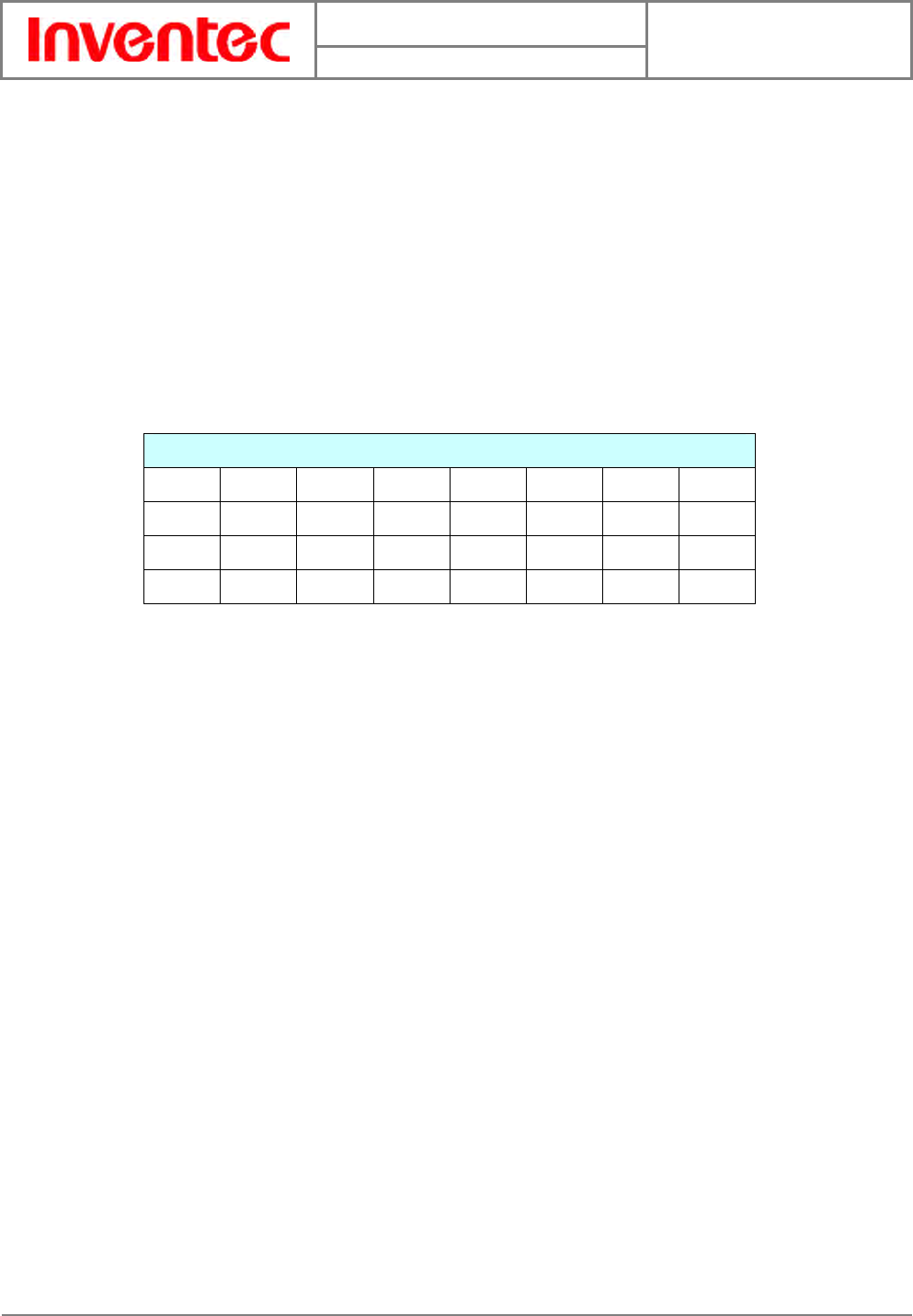
User Manual
Velocity 103
Version : 0.001
日 期 : 2008/05/06
64
INVENTEC CORPORATION
英業達股份有限公司
64
conditions for 2.4 GHz wideband transmission systems and 5 GHz high performance
RLAN equipment.
z EN 60950-1 (IEC 60950-1)
Safety of information Technology Equipment.
z ETSI EN 301 511
Global system for mobile communications (GSM); Harmonized EN for mobile
stations in the GSM 900 and GSM 1800 bands, covering essential requirements of
article 3.2 of the R&TT directive (1995/5/EC).
This equipment may be operated in:
AT BE BG CH CY CZ DE DK
EE ES FI RU GB GR HU IE
IT IS LI LT LU LV MT NL
NO PL PT RO SE SI SK TR
Federal Communications Commission Notice
This device complies with part 15 of the FCC Rules. Operation is subject to the following two
conditions: (1) This device may not cause harmful interference, and (2) this device must accept
any interference received, including interference that may cause undesired operation. This
equipment has been tested and found to comply with the limits for a Class B digital device,
pursuant to Part 15 of the FCC Rules. These limits are designed to provide reasonable
protection against harmful interference in a residential installation. This equipment generates,
uses, and can radiate radio frequency energy and, if not installed and used in accordance with
the instructions, may cause harmful interference to radio communications. However, there is no
guarantee this equipment does not cause harmful interference to radio or TV reception. This
can be determined by turning the equipment on and off. The user is encouraged to try to
correct the interference by one or more of the following measures:
z Reorient or relocate the receiving antenna.
z Increase the separation between the equipment and receiver.
z Connect the equipment into an outlet on a circuit different from that to which the
receiver is connected.
z Consult the dealer or an experienced radio or television technician for help.

User Manual
Velocity 103
Version : 0.001
日 期 : 2008/05/06
65
INVENTEC CORPORATION
英業達股份有限公司
65
Exposure to Radio Frequency (RF) Signals
Your wireless phone is a radio transmitter and receiver. It is designed and manufactured not to
exceed the emission limits for exposure to radio frequency (RF) energy set by the Federal
Communications Commission of the U.S. Government. These limits are part of comprehensive
guidelines and establish permitted levels of RF energy for the general population. The
guidelines are based on the safety standards previously set by both U.S. and international
standards bodies:
z American National Standards Institute (ANSI) IEEE. C95.1-1992
z National Council on Radiation Protection and Measurement (NCRP). Report 86. 1986
z International Commission on Non-Ionizing Radiation Protection (ICNIRP) 1996
z Ministry of Health (Canada), Safety Code 6. The standards include a substantial safety
margin designed to assure the safety of all persons, regardless of age and health.
The highest SAR value for this model phone tested by DASY5 for use at the ear is 0.984 W/kg
and use at the body is 1.470 W/kg
FCC RF Exposure requirements: SAR compliance for body-worn operations is restricted which
provide at least 2 cm separation between the device and the users body.
In the U.S. and Canada, the SAR limit for mobile phones used by the public is 1.6 Watts/kg
(W/kg) averaged over one gram of tissue. The standard incorporates a substantial margin of
safety to give additional protection for the public and to account for any variations in usage.
Normal conditions only ensure the radiative performance and safety of the interference. As with
other mobile radio transmitting equipment, users are advised that for satisfactory operation of
the equipment and for personal safety reasons, it is recommended that no part of the human
body be allowed to come too close to the antenna during operation of the equipment.
NOTE: THE MANUFACTURER IS NOT RESPONSIBLE FOR ANY RADIO OR TV NTERFERENCE
CAUSED BY UNAUTHORIZED MODIFICATIONS TO THIS EQUIPMENT. SUCH MODIFICATIONS
COULD VOID THE USER'S AUTHORITY TO OPERATE THE EQUIPMENT.
WEEE Notice
The Waste Electrical and Electronic Equipment (WEEE) Directive is designed to encourage and
regulate the collection, re-use, recycling and recovery of waste electrical and electronic
equipment, which entered into force as European law on 13th February 2003. The Directive
aims to improve the level of recycling of electrical and electronic equipment (EEE) and
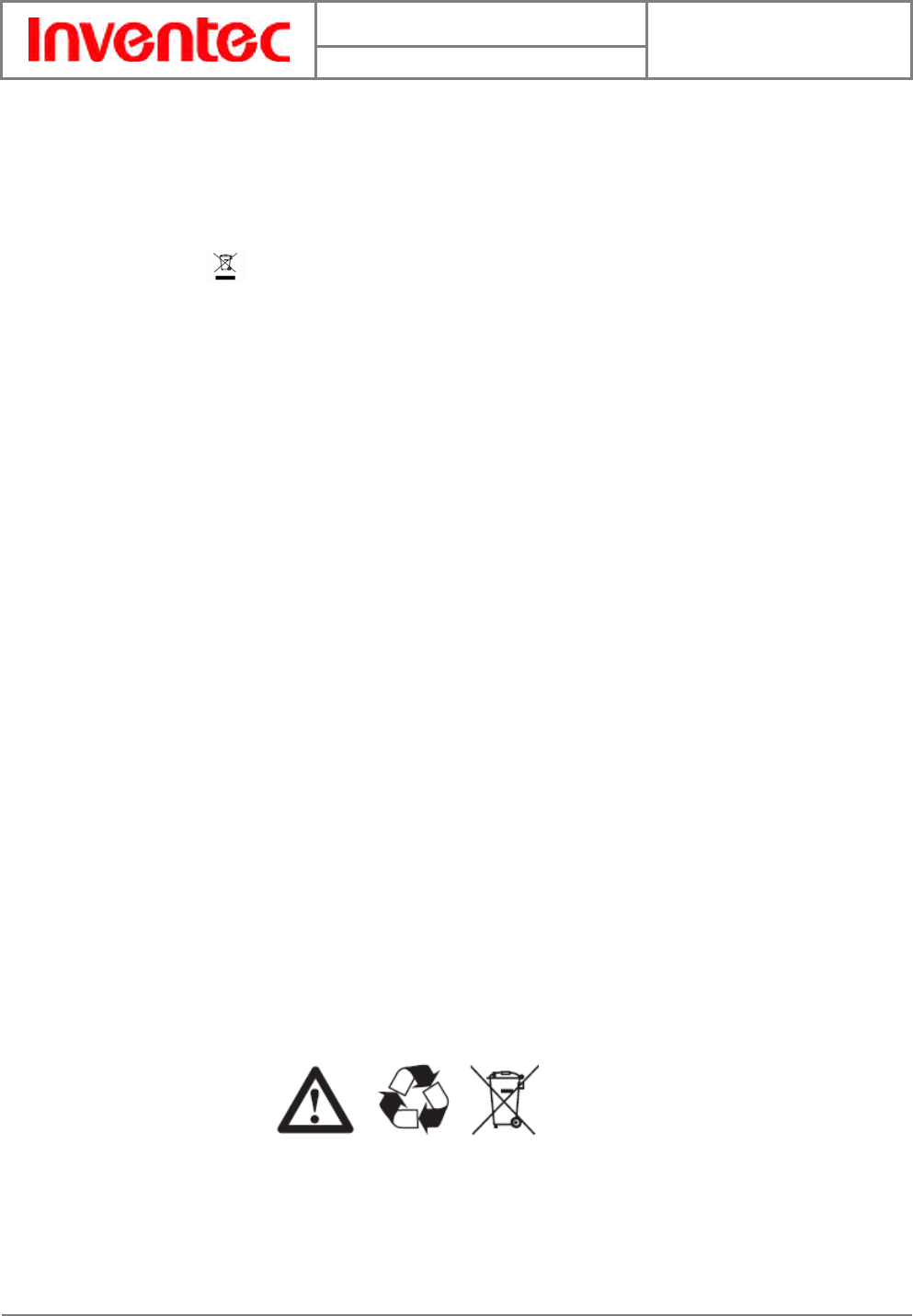
User Manual
Velocity 103
Version : 0.001
日 期 : 2008/05/06
66
INVENTEC CORPORATION
英業達股份有限公司
66
encourages designers to develop products with recycling efficiency in mind; it also aims to
improve our environment and reduce risks to human health through the proper treatment of
discarded goods.
The WEEE logo ( ) on the product and its accessories or on its box indicates that this
product must not be disposed of or dumped with your other household waste. You are liable to
dispose of all your electronic or electrical waste equipment by relocating over to the specified
collection point for recycling of such hazardous waste. Isolated collection and proper recovery
of your electronic and electrical waste equipment at the time of disposal will allow us to help
conserve natural resources and reduce harm to the environment and human health.
For more information about electronic and electrical waste equipment disposal, recovery and
collection points, please contact your local government office, household waste disposal service,
the retailer from where you purchased the equipment, or the manufacturer of the equipment.
RoHS Compliance
This product is in compliance with Directive 2002/95/EC of the European Parliament and of the
Council of 27 January 2003, on the restriction of the use of certain hazardous substances in
electrical and electronic equipment (RoHS) and its amendment.
Warning!
DANGER OF EXPLOSION IF BATTERY IS INCORRECTLY REPLACED. TO REDUCE RISK OF FIRE
OR BURNS, DO NOT DISASSEMBLE, CRUSH, PUNCTURE, SHORT EXTERNAL CONTACTS,
EXPOSE TO TEMPERATURE ABOVE 60.C (140.F), OR DISPOSE OF IN FIRE OR WATER.
REPLACE ONLY WITH SPECIFIED BATTERIES. RECYCLE OR DISPOSE OF USED BATTERIES
ACCORDING TO THE LOCAL REGULATIONS OR REFERENCE GUIDE SUPPLIED WITH YOUR
PRODUCT.

User Manual
Velocity 103
Version : 0.001
日 期 : 2008/05/06
67
INVENTEC CORPORATION
英業達股份有限公司
67
A.2 PC Requirement to Run ActiveSync 4.5
To connect your device to a Windows PC running any Windows operating system prior to
Windows Vista*, you must have Microsoft® ActiveSync® program installed on your PC.
ActiveSync 4.5 is included in the Installation CD, which is compatible with the following
operating systems and applications:
z Microsoft® Windows® 2000 Service Pack 4
z Microsoft® Windows® Server 2003 Service Pack 1
z Microsoft® Windows® Server 2003 IA64 Edition Service Pack 1
z Microsoft® Windows® Server 2003 x64 Edition Service Pack 1
z Microsoft® Windows® XP Professional Service Packs 1 and 2
z Microsoft® Windows® XP Home Service Packs 1 and 2
z Microsoft® Windows® XP Tablet PC Edition 2005
z Microsoft® Windows® XP Media Center Edition 2005
z Microsoft® Windows® XP Professional x64 Edition
z Microsoft® Outlook® 98, Microsoft® Outlook® 2000 and Microsoft® Outlook® XP,
and Microsoft® Outlook® 2003 messaging and collaboration clients
z Microsoft® Office 97, excluding Outlook
z Microsoft® Office 2000
z Microsoft® Office XP
z Microsoft® Office 2003
z Microsoft® Internet Explorer 4.01 or later (required)
z Microsoft® Systems Management Server 2.0
* If you are a Windows Vista user please download and use Windows Mobile Device Center, not
Microsoft ActiveSync, for device connectivity between your Windows Mobile device and
Windows Vista.